

Customer Journey Maps and User Personas
In this article, the main focus is on:
- highlighting the importance of the use of personas in helping craft good customer journey maps (CJM).
- how the Automatic Persona Generation (APG) system can help make CJM’s in a quick and effective way!
Disclaimer: This article does not cover the topic of CJM in-depth but rather focuses on the marriage between CJM’s and personas! For a detailed breakdown on the what, why and how of CJM’s, refer to this customer journey mapping guide by the folks at UXPressia .
Let’s get to the exciting stuff now!

What is a Customer Journey Map?
It can be challenging for an organization or a product team to get into the minds of its users. Often times, you might be left wondering why a user is spending so much time performing a particular action (an example could be on an e-commerce website where the customer is spending a lot of time adding products to their cart) or why does it take him/her several steps to get from Point A to Point B when it should only take a few!
Whatever your issue might be, the root cause of this is that you don’t have a clear grasp of the customer journey. This is where a CJM comes into picture.
CJM is a visualization technique which allows you to see how your users/customers are interacting with your business over time and across channels (e.g. mobile, website, laptop, social media etc.).
A CJM allows you to:
- Understand the entire journey which a user takes to accomplish their goal when using your product or service.
- Get a better understanding of (and subsequently improve) their experience when using your product/service.
- Retain users!
Let’s take a look at the following example of CJM. In this CJM, there is a person named Eric who is impulsive, wants to buy a car and wants to do his research online. He has certain expectations of an “ideal” website which he can use to both search for new cars and also the dealership which will sell him the car. Specifically, Eric wishes that the website should have:
- Ability to compare cars and their breakdowns.
- Good photography with closeups, inside and out
- Video overview of car with demonstrations
He comes across a website and starts searching for cars and also dealerships. The following CJM describes his entire journey when he is doing all of this!
It describes his frustrations, his expectations of when he is frustrated about how the website “should have been designed” and also some moments where the design of the website made him happy! Now to flesh out this CJM is a cumbersome process.

Using Personas in making a customer journey map
While there are several steps involved in making a CJM, the most important step is making a user persona .
A user persona forms the backbone on the basis of which a good CJM is made.
If you take a look at the CJM template which I have shared below, you can see that a user persona is presented in the same CJM, and the pain points, expectations and frustrations of the persona would be represented in the CJM.

It would be safe to say that personas are a tool that helps you take a user-centric approach to customer journey mapping: they help you to really define the tasks that your users want to complete and their needs and pain points in doing so across the customer journey.
By understanding these needs and pain points, you can start to define the ‘moments of truth’ that really matter to your users, where your business has a role to play and what you need to do to make this possible.
If there is one persona which you need to make, then this is a relatively straightforward process. Say for instance, you need to make persona for Eric (on whom the above CJM is based), then the process would look like:
- Contact Eric and users similar to Eric and agree for a suitable time for interviewing.
- While interviewing, understand more about him, his needs and wants from an online car shopping portal.
- Make a persona which describes Eric the best.
- You observe Eric when he is searching for a car online and makes a purchasing decision.
- Based on your observations, you draft a CJM.
There is no right/wrong, linear or prescriptive way to make a CJM. For the sake of brevity, I am simplifying the steps involved.
Now imagine, if there is an organization which wants to understand the journey of most of their users when they are interacting with their product or services. Let’s take the example of the fictitious website which was used to draft Eric’s CJM “YourCarNext.Net”.
Assuming “YourCarNext.Net” is a popular company and has thousands of people who use it. If one day, the company decides that they want to understand how users in a particular city, say New York think of their website, what are their needs, pain points, frustrations and how do they actually use their website, then this would be a hugely cumbersome task.
The organization might need to take help of many UX Researchers who would interview/survey all of these people, construct many many personas and then flesh out CJM’s. And this is not the end! Once they have all user personas and CJM’s in hand, they need to compare and analyse the common problems/frustrations/pain points/journeys of most users to be able to improve their service offering!
Needless to say that this is a bummer!
Not just this but CJM’s also vary in their complexity! If your boss wishes to see many details in a CJM to understand different facets of a user interaction with your product or service, then you might need to go the extra mile to get that extra information about your user! Take a look at the following two CJM’s – I hope you are able to appreciate the complexity of these CJM’s.

So, we have established following things so far:
- CJM involves (lots!) user research.
- Most important step in making a CJM is a persona.
- Personas can take a lot of time if you have many users!
However, an easy way to simplify all of the above is to have a good starting point to make CJM’s- an automatically generated persona which is representative of your user base by using the Automatic Persona Generation system developed by the APG team at the Qatar Computing Research Institute .
Automatic Persona Generation System (APG)
APG is a tool for turning your data into personas. It works currently with YouTube Analytics, Google Analytics, Facebook Ads, and Facebook Insights (if you have enough video content). The system pulls data from these sources and automatically generates user personas that represent your most engaged audience segments.
The benefits of APG are:
- Data-driven personas are created within minutes.
- Data-driven personas are updated automatically every month, thus saving a lot of time for your product team in manually updating these.
APG is both a methodology and a system for automatically creating data-driven personas from online analytics data!
Say, for instance, your organization has a large and diverse customer base (like in the YourCarNext.net example above) and collects digital information on them. Using APG would enable you to better understand all of them!
Take a look at the following persona which is automatically generated using APG, without the need for manual user research!

As you can see from the above figure, the persona which is generated using the APG contains anonymized names of all users of a particular organization. If I go back to the example of YourCarNext.net, a persona generated using the APG would look similar to the above and would list user needs, goals, wants, frustrations etc.
Not only this, using the APG, one can also search for different users (all of whom will have unique problems, needs, pain points, goals etc.) using the APG system as shown below:

Needless to say that combining customer journey mapping with data-driven personas generated using APG is an exciting research endeavor, one that is not time consuming and sustainable for you as a business!
The customer journey concept relies on the notion that users or customers engage with an organization’s products and messages on various channels at various times. Data-driven personas can help isolate, conceptualize, and communicate information on customer segments that are specifically salient at each step of the customer journey.
Think of the countless hours you would save on interviewing users, manually drawing CJM’s and user personas!
Would you like to learn more?
If this article got you intrigued, read our persona analytics research for more in-depth knowledge on persona development.
If you are interested in learning more about how APG can help identify user pain-points and inform design decisions for your team, contact us !
Jansen, B. J., Salminen, J., Jung, S.G., and Guan, K. (2021). Data-Driven Personas . Synthesis Lectures on Human-Centered Informatics,1 Carroll, J. (Ed). Morgan-Claypool: San Rafael, CA., 4:1, i-317.
Jansen, B. J., Salminen, J., and Jung, S.G. (2020) Data-Driven Personas for Enhanced User Understanding: Combining Empathy with Rationality for Better Insights to Analytics . Data and Information Management . 4(1), 1-17. https://content.sciendo.com/view/journals/dim/4/1/article-p1.xml
Customer Journey Maps: How to Create Really Good Ones [Examples + Template]
Updated: April 17, 2024
Published: May 04, 2023
Did you know 70% of online shoppers abandoned their carts in 2022? Why would someone spend time adding products to their cart just to fall off the customer journey map at the last second?
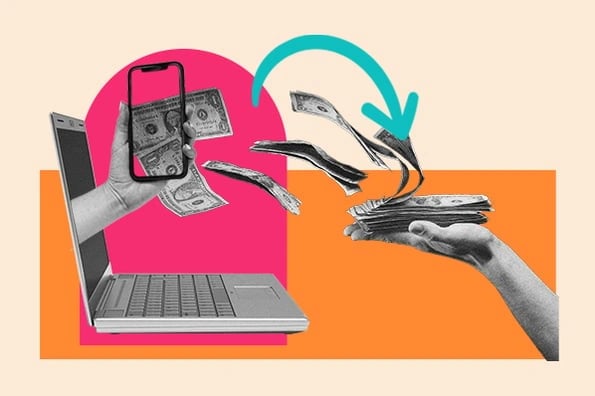
The thing is — understanding your customer base can be very challenging. Even when you think you’ve got a good read on them, the journey from awareness to purchase for each customer will always be unpredictable, at least to some level.

Download Now
While it isn’t possible to predict every experience with 100% accuracy, customer journey mapping is a convenient tool for keeping track of critical milestones that every customer hits. In this post, I’ll explain everything you need to know about customer journey mapping — what it is, how to create one, and best practices.
Table of Contents
What is the customer journey?
What is a customer journey map, benefits of customer journey mapping, customer journey stages.
- What’s included in a customer journey map?
The Customer Journey Mapping Process
Steps for creating a customer journey map.
- Types of Customer Journey Maps
Customer Journey Mapping Best Practices
- Customer Journey Design
- Customer Journey Map Examples
Free Customer Journey Map Templates
.webp)
Free Customer Journey Template
Outline your company's customer journey and experience with these 7 free templates.
- Buyer's Journey Template
- Future State Template
- Day-in-the-Life Template
Download Free
All fields are required.
You're all set!
Click this link to access this resource at any time.
The customer journey is the series of interactions a customer has with a brand, product, or business as they become aware of a pain point and make a purchase decision. While the buyer’s journey refers to the general process of arriving at a purchase, the customer journey refers to a buyer's purchasing experience with a specific company or service.
Customer Journey vs. Buyer Journey
Many businesses that I’ve worked with were confused about the differences between the customer’s journey and the buyer’s journey. The buyer’s journey is the entire buying experience from pre-purchase to post-purchase. It covers the path from customer awareness to becoming a product or service user.
In other words, buyers don’t wake up and decide to buy on a whim. They go through a process of considering, evaluating, and purchasing a new product or service.
The customer journey refers to your brand’s place within the buyer’s journey. These are the customer touchpoints where you will meet your customers as they go through the stages of the buyer’s journey. When you create a customer journey map, you’re taking control of every touchpoint at every stage of the journey instead of leaving it up to chance.
For example, at HubSpot, our customer’s journey is divided into three stages — pre-purchase/sales, onboarding/migration, and normal use/renewal.

Don't forget to share this post!
Related articles.
![customer journey map persona Customer Journey Maps: How to Create Really Good Ones [Examples + Template]](https://www.hubspot.com/hubfs/customer-journey-map_13.webp)
How to Maximize Your Success with a Customer Experience Platform
![customer journey map persona How to Measure Customer Experience: 8 Metrics 1000+ Service Reps Prioritize [+Data]](https://www.hubspot.com/hubfs/customerexperiencemetrics.webp)
How to Measure Customer Experience: 8 Metrics 1000+ Service Reps Prioritize [+Data]
![customer journey map persona How AI Image Misuse Made a World of Miscommunication [Willy's Chocolate Experience]](https://www.hubspot.com/hubfs/ai%20image%20misuse%20the%20willy%20wonka%20experience%20%281%29.png)
How AI Image Misuse Made a World of Miscommunication [Willy's Chocolate Experience]

7 Ways to Delight Your Customers This Holiday Season

14 Customer Experience Fails that Companies Can Learn From
![customer journey map persona How Customer Experience Has Evolved Over the Last Decade [+ 2024 Trends]](https://www.hubspot.com/hubfs/future-of-customer-experience.png)
How Customer Experience Has Evolved Over the Last Decade [+ 2024 Trends]
![customer journey map persona Memorable Examples of AR in Customer Experience [+Tips for Implementing the Technology]](https://www.hubspot.com/hubfs/augmented%20reality%20customer%20experience.png)
Memorable Examples of AR in Customer Experience [+Tips for Implementing the Technology]
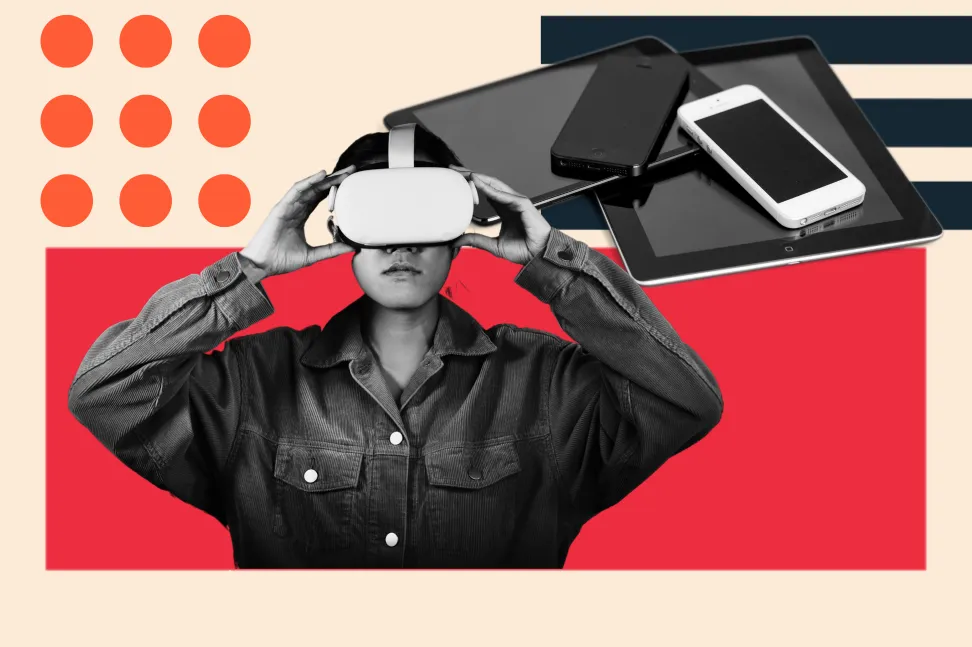
Digital Customer Experience: The Ultimate Guide for 2024
![customer journey map persona How to Implement a Hybrid Customer Service Strategy That Works [Expert Tips]](https://www.hubspot.com/hubfs/hybrid%20customer%20service_featured.png)
How to Implement a Hybrid Customer Service Strategy That Works [Expert Tips]
Outline your company's customer journey and experience with these 7 free customer journey map templates.
Service Hub provides everything you need to delight and retain customers while supporting the success of your whole front office
Integrations
What's new?
In-Product Prompts
Participant Management
Interview Studies
Prototype Testing
Card Sorting
Tree Testing
Live Website Testing
Automated Reports
Templates Gallery
Choose from our library of pre-built mazes to copy, customize, and share with your own users
Browse all templates
Financial Services
Tech & Software
Product Designers
Product Managers
User Researchers
By use case
Concept & Idea Validation
Wireframe & Usability Test
Content & Copy Testing
Feedback & Satisfaction
Content Hub
Educational resources for product, research and design teams
Explore all resources
Question Bank
Maze Research Success Hub
Guides & Reports
Help Center
Future of User Research Report
The Optimal Path Podcast
Maze Guides | Resources Hub
User Personas: Your Guide to Building Personas for UX
0% complete
Persona mapping: How to map personas to drive better decisions
In this chapter, we’re covering how to manage persona mapping as part of the UX process. We’ll cover the questions you need to ask, how to organize your answers, and the benefits of persona mapping. We’ll wrap up with how you can repeatedly test and validate your personas.
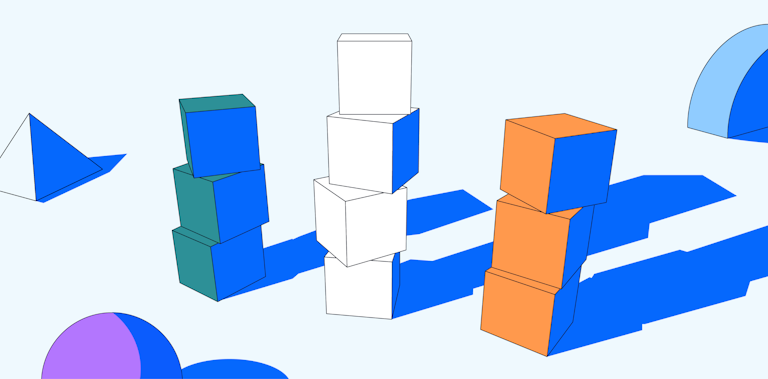
Persona mapping enables you to accurately build user personas with rich data. Done right, persona mapping will be the fuel to well-rounded personas that are usable and understandable for your product team.
In chapter two, we took you through a 9-step process to building user personas; this includes everything from defining your plan, all the way through to distributing your personas with your team.
In this chapter, we’re going to build on one of the most crucial steps from chapter two: persona mapping. Here, you’ll learn the types of questions you need to ask, as well as how to map the answers you get, in a way that helps you build usable personas.
First, let’s start by clearing up what persona mapping actually is.
What is persona mapping?
Persona mapping is a logical step in your user persona build process. Persona mapping helps you collect and use your target audience research data to create more distinct personas.
Despite constantly being in debate, most UX designers consider the act of persona mapping to be from the moment you start creating your user research questions.
Therefore, this chapter will consider the process of persona mapping to start at those all-important questions that will enable you to better segment your data further down the line, and truly understand who’s using your product.
Done well, persona mapping can help product teams devise relevant marketing campaigns, and design and build better products.
How to create a persona map
Ask the right questions.
You can only finish with valuable user personas when you start with a solid set of questions. Ash Oliver , UX Designer & Design Advocate at Maze, runs us through his thought process when it comes to crafting questions that get results.
“Ask open-ended questions, and ensure they’re rich questions that can potentially be asked to anyone. Asking a question that anybody can answer helps guide the conversation.
Building on this, you’ll definitely need a combination of closed and open-ended questions. Closed-ended questions help for segmentation upfront, whereas open-ended questions help you find persona cohorts further down the line.”
So, what sort of questions do you need answering to better segment users and build a better customer experience? Here are nine user persona questions you can rewrite to fit your niche:
1. What role do they perform at work?
By identifying their role, you can better understand their jobs-to-be-done, and likely use cases for your product and its features.
2. Do they have the final say on purchasing decisions?
This is more a consideration for building buyer or customer personas, but a useful personal attribute to know in UX personas as well. Are your personas decision-makers or product advocates? Do they have direct access to budgets? This information will help you understand their seniority and likeliness for in-app purchases.
3. What device do they use?
Meet them on devices they use every day. Especially if your product team is running off of the RARRA framework—focusing on retention over acquisition, you’ll want to be building interfaces that work with their device and screen size. Answering this question will help you focus on designing a UI that helps retain users.
4. Do they use social media? What do they use it for?
Another good question to ask when building buyer personas, and this question can certainly support your product marketing’s social media strategy. However, it’s also a great-to-know for UX/UI designers. When you understand your personas’ most-used social media channels you can borrow tactile UI navigation rules they’re already familiar with, making their product interactions with you seem like second nature. For example, if you find one persona typically uses TikTok, a swipe up feature to navigate to new screens may be more familiar for your mobile app than a swipe across or click.
5. What are their career goals?
Looking beyond jobs-to-be-done, how can you help your users achieve their entire role, and be championed for their work? Identifying personal attributes like this can help highlight new features, onboarding strategies and more.
6. What are their values?
Today’s users won’t buy products that don’t resonate with their values. What’s more, helping users achieve personal missions and values will create product advocates, increase referrals, lift net promoter score (NPS), and more.
7. What workplace culture are they in right now?
Identifying workplace culture will help you make core product decisions. Are personas looking for a product that can keep up with their agile culture—rapid releases, sprints, and fast-paced teams? Do they have a waterfall culture that will require admin rights and seniority levels within your app?
At the same time, are you dealing with people in an entirely distributed team, and your product also needs room for digital communication?
Remember, you’re not building for the culture they aspire to create—if you do that, your product won’t be relevant. Build for the culture they are working with right now.
8. Who are they following?
Who are your user personas following? These can be competitor brands, industry influencers, or likeness brands. Answering this decision will help you better understand the personalities you’re dealing with, the language and references they’re accustomed to, and UX branding traits they enjoy.
9. What language & sentiment do they use?
Take a look at how your current users talk about your product, or your competition’s if you don’t have a product on the market yet—what trends are you noticing? Do they refer to features another way to what your team has named them? Do they feel a certain way toward a feature, product, or even brand? What language do they use to express this sentiment?
Understanding all this can help UX writers—and marketers in general—put together copy that resonates, weave onboarding flows which are understandable, and thread tooltips that your personas will understand.
Now we’ve covered the questions to ask and how they can help your persona mapping process, let’s look at how you can learn from them and map your data into something useful.
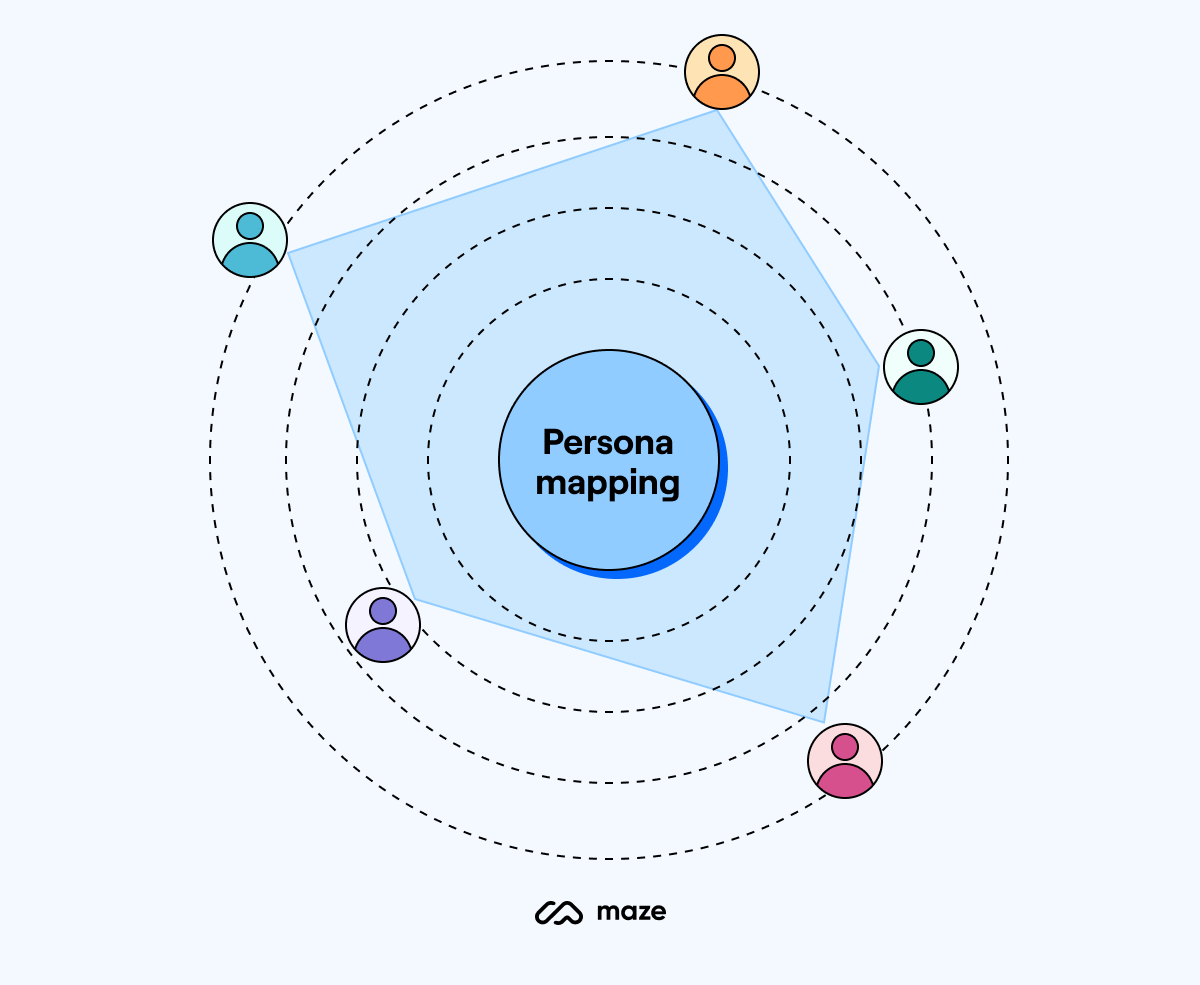
Map your answers
Start by segmenting answers based on your respondents’ goals and barriers. Consider demographic features like job title, geolocation, and age—but only if you deem demographics to be important to your product design decisions.
Ash Oliver, UX Designer & Design Advocate at Maze, explains how he likes to go about segmenting data.
“I’m a big whiteboard, mind mapper-type designer—very visual. I tend to work heavily in Miro. That’s where I can start to sort and make sense, and organize user information. Physical or digital whiteboards can play really helpful roles in the storming stage of user persona-building, and later on as well.”
We asked Ash, why Miro ?
“Personas tend to be boxed into a one-page, text-driven template doc, and that’s okay if they serve their learning purpose. However, Miro helps build an interactive learning place—it hosts a live project we can come back to time and time again.”
Alongside Miro, Ash also highlighted some other tools as key to his persona mapping process.
“Notion is another big tool I use. The flexibility within the document structure is really helpful. I’ve also used Excel for more quantitative research and creating a measure to run with, once I start coding out teams and tags.”
After you’ve started to group your data into the above trends you can micro-segment them to enable you to build user personas from each segment. Two categories to consider are:
Lifecycle segments:
- First-time users
- Passive users
- Regular/active users
- Power users/advocates
Note: If you’ve run an NPS survey with your user base, then the information from this research will drastically aid this segmentation through use of detractors, neutrals, and promoters.
Purpose segments:
- Experiential users: People that use your product recreationally
- Side-hustle users: People that use your product outside of work for their passion projects
- Professional users: People that use your product for their work
Understanding these further segmentation categories will help you understand the potential customer lifecycles for these personas. For example, it will highlight if they’re likely to churn, not activate, or be a long-term advocate of your product. It will also help you define the feature sets most relevant to each persona.
Segmenting all of this information will help you map user personas that can truly inform your product design roadmap and provide a personalized experience for the right people.
Now you know the right questions to ask, let’s cover the benefits of persona mapping.
8 Benefits of persona mapping
When you dive into the details of your target audience and accurately map detailed personas, there are plenty of benefits on the table. Let’s take a look at eight persona mapping benefits for UX researchers and their product teams.
1. Develop more personalized UX strategies
Personal details win user longevity. They help you develop conscious products that are aware of users' needs, surroundings, and problems. They give your users a tailored experience that you can scale to a wider audience.
2. Fight customer churn
Customer churn is a metric every company tracks, and with good reason. However, when you run persona mapping, you’re able to fight customer churn by implementing anti-churn strategies within each persona’s first few in-app experiences.
This can extend outside of your application too, with push notifications, email messaging, and more.
3. Build on customer retention via referral rates & growth loops
Let your product do the selling for you. Product-led growth teams that are able to increase their customer retention rates, referral rates, and create impactful growth loops generate a larger and more scalable ROI.
Persona mapping can provide key information to support these strategies and build customer experiences that resonate around them.
4. Increase NPS
This is another core metric that validates product-market fit, and a promising retention rate. Persona mapping can help you build products that create a positive NPS. The information you collect will dictate core product design elements that users love.
5. Understand jobs-to-be-done and 'aha!' moments
When you’re better able to understand your users, you’re able to identify their jobs-to-be-done, and aha! moments that will activate them within your product. Next, you can build smoother onboarding flows to get new users to these moments quicker, and to keep delighting them with more throughout their lifecycle.
6. Create products that are easier to onboard
Businesses often struggle with attracting potential customers, even if the customer knows they need the solution. Why? This could be a pricing and cost issue, however, it can also be a fear of change; due to time, capability, or something else.
When your team runs persona mapping, your product development efforts shift to create solutions which are easier to onboard, helping attract new users, either through word-of-mouth or other product-led growth (PLG) strategies. Suddenly, the task of onboarding a new tool doesn’t seem so daunting after all.
7. Create accessible interfaces
Your target market has needs that are larger than what your product can provide. If your product team is small, then it can be hard to consider this array of potential needs which you must adapt to.
When you conduct persona mapping, you create empathy and open the floor up to diverse and inclusive product decisions which will attract a wider user base, create a better digital presence, and give every user the accessibility they deserve.
8. Build better product positioning
Although we’re specifically discussing persona mapping to build user personas, this will also help your product positioning.
The buyer insights you’ll get from this research will help your product marketing, as well as allowing your product teams to better place your product and its features in the market, set it apart from the competition, and convey benefits in a way which resonate.
Furthermore, it will help you hone in on product messaging within your product, ensuring you’re using the right language that accurately reflects how your users view your product and features.

The importance of testing and validating your user personas
Your persona mapping doesn’t have an end date and your team should constantly be updating and tweaking personas to adapt to change.
At Maze, we approach user personas on an ongoing basis, it’s part of our UX team’s routine. That doesn’t mean we need to update a particular UX artifact—like a persona PDF one-pager—every six months. Instead, we have ongoing workshops every eight weeks or so, to constantly find out things that are contrary to what’s documented.
In order for UX teams to learn often, you’ll need to make their learning pathway as easy as possible.

Ash Oliver , UX Designer & Design Advocate at Maze
To enable regular user persona testing and learning opportunities, move away from project-minded personas and take an iterative approach. Do your internal users feel like the information they’re getting is specific and valuable?
It could be specific, but that doesn’t necessarily mean it’s valuable. A great example of this is demographic information. Do you really need that information to relate to someone? This data may not (and probably won’t) help your internal users.
Does your team feel like they’re getting specific, valuable information that’s driving successful decisions? Or are they finding the decisions they’re making unsuccessful? Furthermore, validating comes from a combination of data and product decisions.
Take copy and positioning, for example. Say you’re making decisions on this based on persona research—if it doesn’t move the needle, it either suggests you’re leaning in the wrong direction, or haven’t gone far enough.
In order to test and validate you need to place some educated bets and decisions. It’s always a test, and things can always change further down the line.
Conclusion: persona mapping
That’s a wrap on persona mapping. Hopefully you’re now in a position to collect and segment your user data in a way that enables you to efficiently map personas which optimize UX tactics and product growth strategies.
Now you’ve got all your data, and have segmented it, you’re ready to start displaying and sharing it. The final chapter in this guide will walk you through how to showcase your data for internal teams.
Frequently asked questions about persona mapping
Persona mapping is the process of collecting and segmenting potential user information to create archetypes that help your product team make informed product-led decisions.
Persona mapping helps encompass your ideal customer’s characteristics, job-to-be-done, diversity needs, and more.
Why is persona mapping important?
Persona mapping is an essential UX research strategy that enables your product teams to collect an array of customer-centric data. This data segments ideal users and ensures you’re building products that are empathetic, inclusive, usable, and retain target customers or existing clients for the long-run.
How is creating a user persona beneficial for customer journey mapping?
A user persona is beneficial for customer journey mapping as it helps product marketing teams understand who they’re selling to and the types of long-term users that benefit from their products. Persona mapping helps flip traditional AARRR pirate metrics to RARRA growth models, prioritizing retention over acquisition.
User persona templates
Root out friction in every digital experience, super-charge conversion rates, and optimize digital self-service
Uncover insights from any interaction, deliver AI-powered agent coaching, and reduce cost to serve
Increase revenue and loyalty with real-time insights and recommendations delivered to teams on the ground
Know how your people feel and empower managers to improve employee engagement, productivity, and retention
Take action in the moments that matter most along the employee journey and drive bottom line growth
Whatever they’re saying, wherever they’re saying it, know exactly what’s going on with your people
Get faster, richer insights with qual and quant tools that make powerful market research available to everyone
Run concept tests, pricing studies, prototyping + more with fast, powerful studies designed by UX research experts
Track your brand performance 24/7 and act quickly to respond to opportunities and challenges in your market
Explore the platform powering Experience Management
- Free Account
- Product Demos
- For Digital
- For Customer Care
- For Human Resources
- For Researchers
- Financial Services
- All Industries
Popular Use Cases
- Customer Experience
- Employee Experience
- Net Promoter Score
- Voice of Customer
- Customer Success Hub
- Product Documentation
- Training & Certification
- XM Institute
- Popular Resources
- Customer Stories
- Artificial Intelligence
- Market Research
- Partnerships
- Marketplace
The annual gathering of the experience leaders at the world’s iconic brands building breakthrough business results, live in Salt Lake City.
- English/AU & NZ
- Español/Europa
- Español/América Latina
- Português Brasileiro
- REQUEST DEMO
- Experience Management
- Customer Journey Mapping
What is customer journey mapping?
Customer journey map template, the customer journey mapping process, data inputs for your customer journey map, why should you use customer journey maps, the uses of customer journey mapping, how to improve a customer journey, tools to help you with your journey mapping, try qualtrics for free, customer journey mapping 101: definition, template & tips.
22 min read Find out about how to start customer journey mapping, and how to improve it for the benefit of your customers and the business.
If you want to improve your customer experience you need to be able to understand and adapt the customer journey you offer when someone interacts with your organization. Whether their journey is entirely online , offline, or a blend of both, there are multiple journeys a customer might undergo.
Understanding the customer journey in depth helps you identify and take action on customer pain points and repeat what’s working. By doing this, you will improve the overall experience that your customers have, which will have better outcomes for your business.
Outlining the potential customer journeys your audience might go through requires a process called customer journey mapping.
Free Course: Customer journey management & improvement
Creating a customer journey map is the process of forming a visual representation of customers’ processes, needs , and perceptions throughout their interactions and relationship with an organization. It helps you understand the steps customers take – the ones you see, and don’t – when they interact with your business.
It enables you to assess:
- Insights – from your existing customer journey, how to understand it better
- Impact – how to optimize budgets and effort for changes we want to make to the customer experiences
- Issues/opportunities – Diagnose the existing customer journey
- Innovation – where you might want to completely change the existing customer experience
A customer journey map gives you deeper insight into the customer, so you can go beyond what you already know. Many brands see the customer journey as something that is visible – where the customer interacts with the brand. But in reality, this is not true, and only accounts for a percentage of the entire customer journey. Creating a customer journey map gets you thinking about the aspects of the journey you don’t see, but have equal weight and importance to the entire experience.
When mapping out the customer journey, you are looking for the moments that matter – where there is the greatest emotional load.
If you’re buying a car, then the greatest moment of emotional load is when you go to pick the car up because it’s yours , after picking the color, choosing the model, and waiting for it to be ready.
Ensuring these moments match your customers’ expectations of your product, brand and service teams are key to helping you reach your business goals. But you can only do that by understanding the journey your customers go on in order to get there, what they’re thinking and needing from you at that time. Developing a customer journey map puts you in their shoes so you can understand them better than ever before.
Getting started when creating a customer journey map template doesn’t have to be difficult. However, your customer journey map template will need to cover several elements in order to be effective.
There are several ingredients that make up the anatomy of a customer journey, all of which should be looked at carefully so that you can find out where the customer journey runs smoothly and meets customer needs at that moment in time – and where the experience does not, and needs some improvement.
Understanding their behaviors and attitudes also means you can fix bad experiences more effectively too because you know why you haven’t met your customers’ expectations and what you need to do to make amends. There may be times when things go wrong, but it’s how you adapt and what you do to fix these experiences that separates the best. Knowing how the customer will be feeling makes taking that decisive action much easier.
When exploring and visualizing the customer journey we are assessing:
- Customer behavior What is your customer trying to do?
- Customer attitudes What is your customer feeling/saying?
- The on-stage experience Who/what is your customer directly interacting with? (This includes various channels, such as TV ads or social media)
- The off-stage experience Who/what needs to be in place but which your customer is NOT directly aware of?
So what could the customer journey map examples look like when starting the process of buying a car?
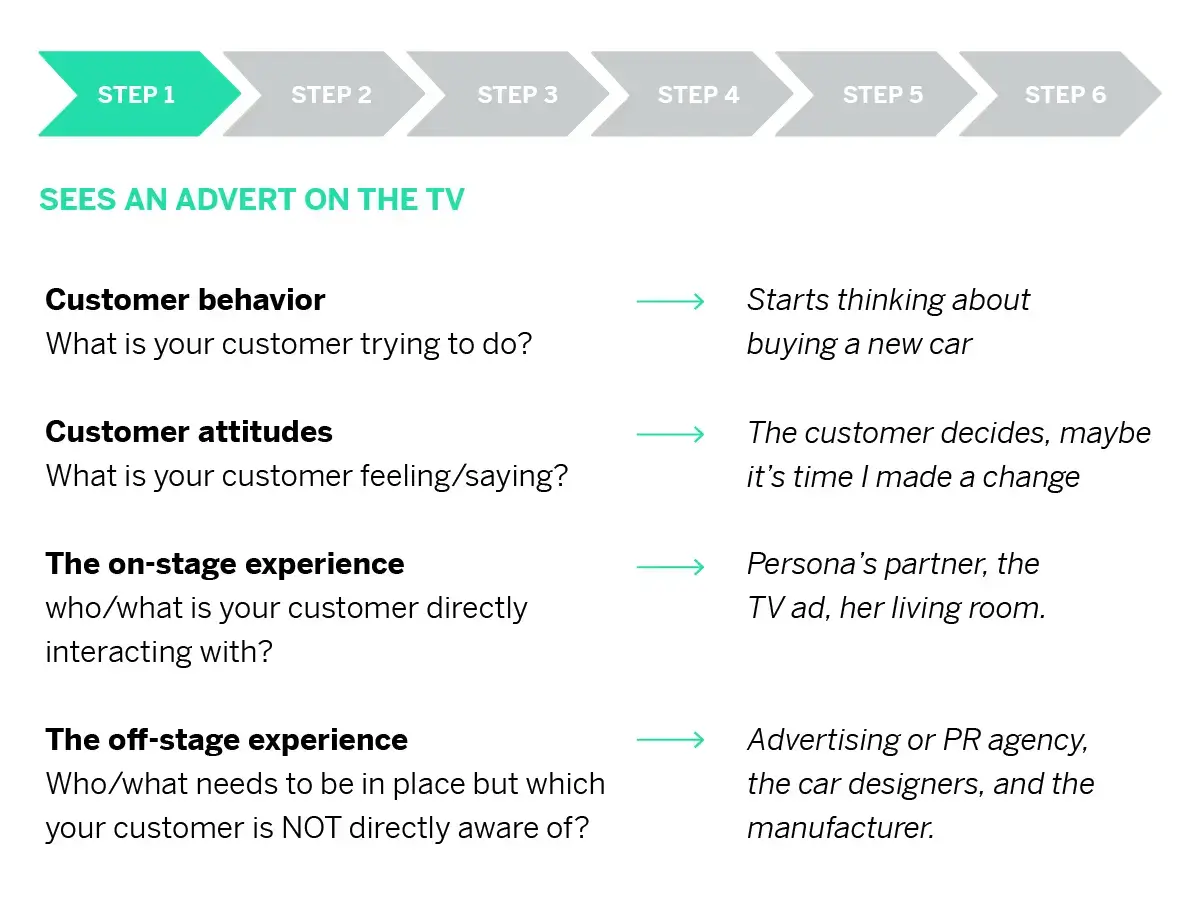
Customer journey vs process flow
Understanding customer perspective, behavior, attitudes, and the on-stage and off-stage is essential to successfully create a customer journey map – otherwise, all you have is a process flow. If you just write down the touchpoints where the customer is interacting with your brand, you’re typically missing up to 40% of the entire customer journey.
There is no single customer journey. In fact, there are multiple. The best experiences combine multiple journeys in a seamless way to create a continuous customer lifecycle as outlined below.
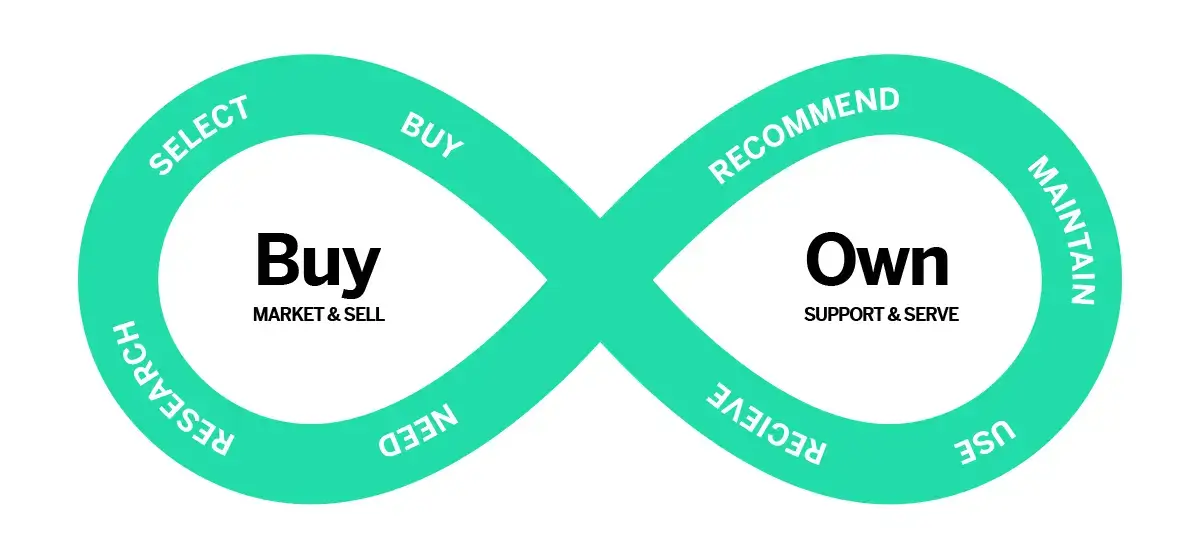
Getting started with customer journey map templates
To begin, start by choosing a journey that you would like to create a customer journey map for and outline the first step that customers will take.
You can use this customer journey map template below to work out the customer behaviors, attitudes, the on-stage and off-stage processes – and the KPIs attached to measuring the success of this experience.
Download our free journey mapping template here
The step-by-step process of mapping the customer journey begins with the buyer persona .
Step 1 – Create a customer persona to test
In order to effectively understand the customer journey, you need to understand the customer – and this is where creating a persona really helps. You may base this around the most common or regular customers, big spend, or new customers you haven’t worked with before. This persona is beyond a marketing segment , but that can be a great place to begin if you’re just starting out on the mapping process for your organization.
What do you include? Start with these characteristics.
- Family status
- Professional goals
- Personal goals
These personas help you gain a deeper understanding of your customers and can be derived from insights and demographic data , or even customer interviews . This works for both B2B and B2C business models, but in B2B especially you’ll have multiple customers for each opportunity so it’s recommended you build out multiple personas.
To begin, start with no more than three personas to keep things simple.
Create a diverse team
When creating a customer journey map, you also need to build out a diverse mapping team to represent the whole business. Include frontline staff , day-to-day management, corporate teams, HR, and business support functions. They will give you vital feedback, advice, and perspectives you hadn’t thought of.
Step 2 – Choose a customer journey for mapping
Select a customer journey map to construct, then build a behavior line. This might be a new customer journey, renewal, or fixing a product issue. You might also choose this based on the most frequent customer journeys taken, or the most profitable.
Step 3 – Work through the mapping process
Ask yourself the following:
- Who are the people involved in this journey? E.g. if you’re in a car dealership, that might be the customer, the sales rep, and front-of-house staff.
- What are the processes or the things that happen during this journey?
- What are the customer attitudes ? What are they feeling at this time? Go beyond excitement or frustration. Bring these feelings to life. This car is my dream come true!
- What is the moment that matters? Identify the greatest moment of emotional load. The make or break where everything could be good up until that point, but if you get that moment of maximum impact wrong, then all that’s good is forgotten. The best experience brands get this moment right and identifying it is an important first step to achieving that. In that moment, ask yourself what are the things/people/processes involved? Think about this for the whole business – across your product , brand , and service teams.
- But beyond identifying this moment, you need to establish what your customers’ needs are. What are they getting out of this moment? How do their needs change if this experience goes badly? Knowing the answer to these questions can help you deliver experiences that will resonate , and respond quickly to unforeseen circumstances or issues.
- And finally, how do you measure how effectively you are meeting customer needs throughout the journey? Set KPIs to put benchmarks in place for your customer journey map and customer experience and track your progress.
Step 4 – Innovate
When you are mapping out your customer journey, brainstorm ideas for how to improve that moment that really matters . These ideas don’t need to be practical, but by putting together a diverse mapping team from around the business you can begin to filter through these ideas.
Then, test it.
Ask yourself: Is it feasible? Is it viable? Is it desirable? Don’t ask can we do it, ask should we do it? Then you can start to differentiate yourself from your competitors.
Step 5 – Measure
Use the customer journey map to decide on your measurement framework.
Who are you measuring? What are you measuring? When on the journey are you measuring it? And why? And finally, what metrics and KPI’s are in place to measure this?
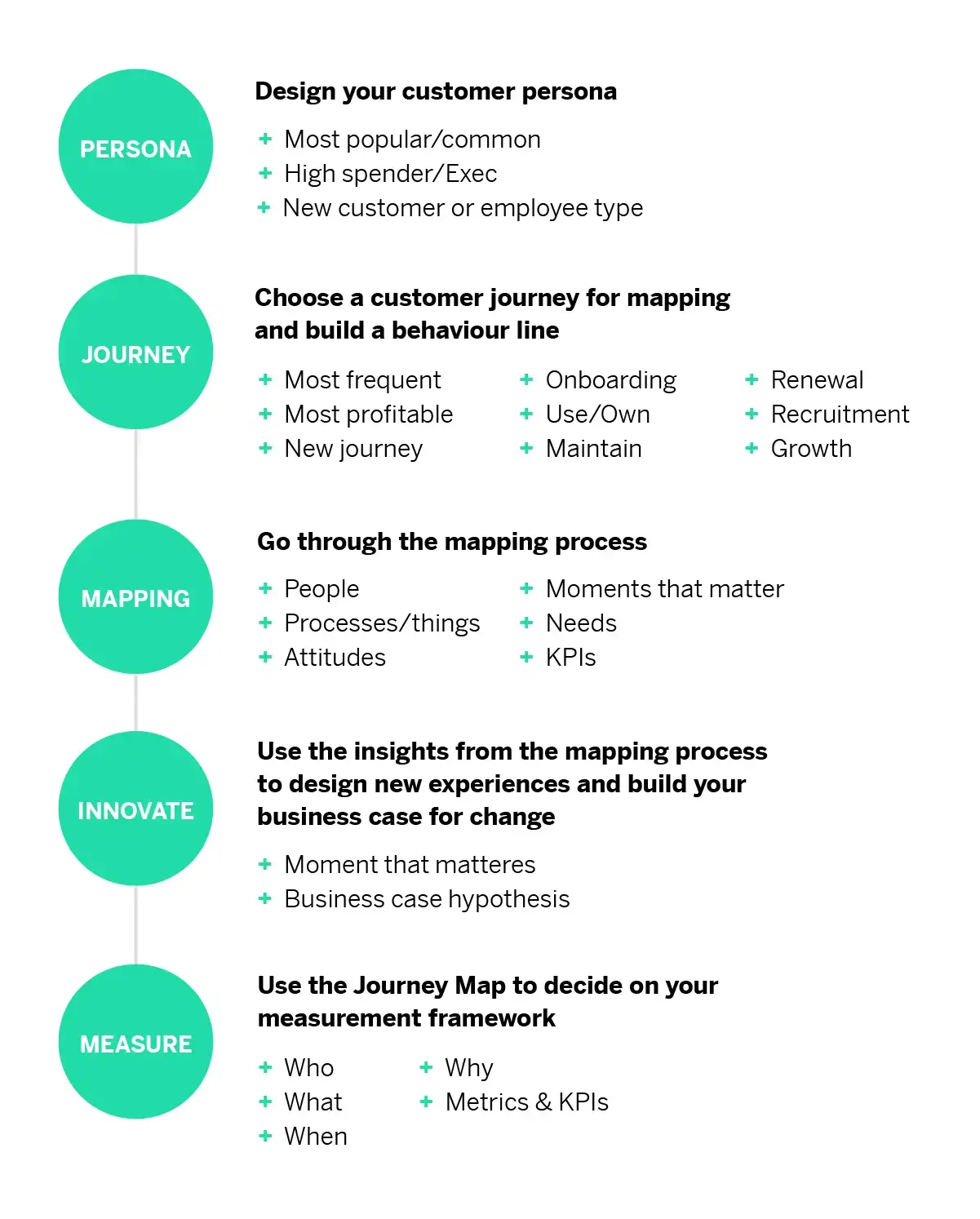
Your customer journey map process will require you to use several different data inputs to get an accurate picture of how your customers behave and where you can improve their experience.
A customer journey map is often developed using data gleaned from customer feedback you’ve requested . While this type of market research is useful, your research process needs to be deeper to gain a richer, more accurate understanding of your customer’s behavior.
To create a customer journey map that accurately reflects the truth of customer actions and intentions, you need to take into account both solicited and unsolicited data.
Use solicited data to understand the voice of the customer
Solicited data includes the customer feedback you gain when you conduct research through surveys such as Net Promoter Score (NPS) or ask customers for feedback on social media. This approach can be very useful for understanding your customer’s point of view , rather than just making assumptions about how they think and behave.
However, your target audiences won’t tell you everything about what they plan to do when undergoing their customer journey. Though they might tell you that they’ve had a great experience in a particular part of their customer journey, this type of feedback presents a few issues:
- You have to know when to ask for feedback : You might already have a customer journey in mind when asking for feedback – but do you know all the routes a customer might take in your customer journey map?
- It’s a snapshot: When you survey customers, you’ll likely only get insights into their experience at that particular moment about a specific touchpoint
- It’s what customers say they think/will do, not what they actually think/will do: You’re relying on your customers to accurately reflect their sentiment and intentions in their responses, which isn’t always the case. For your customer journey map to be effective, you need to find the truth
- Your sample size might be too small : If you’re trying to understand how a relatively niche customer journey is doing, you might find that the number of customers who have not only taken the customer journey but are willing to respond with feedback is very limited. You can’t risk survey fatigue by polling the same audience several times, so your insights are limited
- You’re only getting part of the picture : You will likely have several types of useful customer data on file, but these are often not considered as part of the process when creating a customer journey design because solicited data takes precedence
You’ll need to infer how customers feel to be able to accurately predict the actions a customer takes. To do so, you’ll need to look at unsolicited data.
Unsolicited data
Unsolicited data covers everything your customers aren’t telling you directly when you ask them and contextual data that you likely already collect on them, such as purchase history. It can be taken from various sources, such as your website and social channels, third-party sites, customer calls, chat transcripts, frontline employee feedback , operational sources, and more.
This type of data is nuanced, but it allows you to establish the truth of your customers’ experience. The ability to gather unsolicited customer feedback from every channel enables you to see more than just what a customer tells you directly. Using real-time feedback gathering and natural language understanding (NLU) models that can detect emotion, intent, and effort, you’ll be able to understand your customers’ actions in a more profound way. Unsolicited data offers you a 100% response rate that better indicates what your customers actually think of each step in their customer journey.
Rather than be limited to a small sample size of customers who respond to surveys, you’ll be able to build an accurate picture of the average customer on each step of the customer journey map by using this richer insight data with your own operational data.
Why using solicited and unsolicited data is important data
With solicited data, you don’t always see why a customer behaves or thinks as they do. For example, a customer might tell you that they would recommend you to a friend or family – but they don’t renew their subscription with you. A customer might be an ideal candidate for a particular journey, but they abandon their basket when prompted to give their personal details. Understanding the why behind customer actions is key for designing a great customer journey, and that’s why both solicited and unsolicited data collection and evaluation are necessary for creating great customer journey maps.
Of course, knowing how customers will actually respond to your customer touchpoints is only part of the process. You may need to develop more than one customer journey map and create sub-audiences for your customer personas to accurately see where you can rectify pain points and improve outcomes. You will need to collect and analyze contextual data across all customer journey touchpoints and develop a highly detailed journey map that can unveil routes your customers might be taking without your knowledge.
Qualtrics can overlay solicited and unsolicited data to provide an all-encompassing picture of your customer journey map, no matter how complex. Creating an effective customer journey map is easier with all your data collated and analyzed together, with actionable insights created automatically.
A customer journey map creates a common understanding for the organization of how a customer interacts during different stages of the customer lifecycle, and the roles and responsibilities of the different teams in charge of fulfilling that experience.
It will also bring an organization together, and foster empathy and collaboration between teams because people will know what is required from everyone in the business to deliver the experiences that customers expect. This will help you to develop a shared sense of ownership of the customer relationship, which ultimately drives a customer-centric culture . With everyone working towards a common goal, communication of what you learn about the customer and the journey they go through is vital in order to drive best practices throughout the organization.
Creating an accurate customer journey map will help your customer service team to focus on more specific issues, rather than handling problems generated by a less-tailored customer journey. Your customer experience will be improved with a customer journey that’s personalized to the specific personas you have generated. You’ll have put yourself in your customer’s shoes and adapted your strategy to reflect your customer’s perspective – which in turn will create more memorable experiences.
Creating a customer journey map will influence your journey analytics across the business. So for example, it will determine what you ask, who you ask, when you ask, why you ask it and how you ask questions in your Voice of the Customer Program .
So when should you use customer journey mapping?
There are four main uses:
- Assess the current state of your customer journey Understand and diagnose the specific issues in current experiences
- Understand what the future state of your customer journey should look like Design, redesign and create new experiences
- Blueprints For implementing change
- Communication Bringing teams together to train and scale up best practices.
Take stock and take action
To improve the customer journey you need a clear vision of what you want to achieve and you need to make a distinction between the present and the future.
- What is your customer journey right now?
- What does the future state of your customer journey look like?
This is why organizations blueprint their customer journey because they can see what works and act accordingly. By understanding your customers’ attitudes and needs at critical times in the journey, you can make amends to better meet them – and develop contingencies to cope when these needs aren’t or can’t be met. For example, during a sudden, unexpected surge in demand.
Orchestrate your customer journey
To offer your customers truly optimized experiences, you’ll need to go further than just creating a customer journey map. You’ll also need to orchestrate journeys using real-time customer behavior to adapt your strategy as your customers make choices. Orchestrating a journey means taking dynamic action towards optimizing your customer’s experience, using real-time customer behavior as informative data.
Improve your employee experience
Use your diverse mapping team to come up with ideas that incorporate experience from all aspects of the business to improve the customer journey – and remember that this has a significant payoff for your employees too. Improving the employee journey – by giving teams the tools to make a difference – can have a positive knock-on effect for the customer and improve their experience in those key moments. This is because employees have the autonomy and motivation in their roles to help their customers, and realize their own potential.
Your customer journey map isn’t just designed to improve the customer experience. Creating an accurate customer journey map can help you to improve your business outcomes.
Being able to link operational data to key touchpoints in a customer journey is transformative for organizations. This is because improving segments of the customer journey will see a direct impact on your business. The Qualtrics Journey Optimizer helps you do just that. By analyzing areas for improvement as outlined by your customer journey map, organizations can take actions that will have maximum benefit for their customers, and the business too.
With Qualtrics, you’ll:
- Create a common understanding throughout your workforce of how a customer interacts with your organization, and you’ll know the roles and responsibilities of your different teams
- Develop empathy and collaboration between teams, working together to achieve the same outcome
- Develop a shared sense of ownership of the customer relationship which ultimately drives a customer-centric culture
Free course: Customer journey management & improvement
Related resources
Customer Journey
Customer Interactions 11 min read
Consumer decision journey 14 min read, customer journey orchestration 12 min read, customer journey management 14 min read, customer profiles 16 min read, customer journey stages 12 min read, buyer's journey 16 min read, request demo.
Ready to learn more about Qualtrics?
Product Design (UX/UI) Bundle and save
User Research New
Content Design
UX Design Fundamentals
Software and Coding Fundamentals for UX
- UX training for teams
- Hire our alumni
- Student Stories
- State of UX Hiring Report 2024
- Our mission
- Advisory Council
Education for every phase of your UX career
Professional Diploma
Learn the full user experience (UX) process from research to interaction design to prototyping.
Combine the UX Diploma with the UI Certificate to pursue a career as a product designer.
Professional Certificates
Learn how to plan, execute, analyse and communicate user research effectively.
Master content design and UX writing principles, from tone and style to writing for interfaces.
Understand the fundamentals of UI elements and design systems, as well as the role of UI in UX.
Short Courses
Gain a solid foundation in the philosophy, principles and methods of user experience design.
Learn the essentials of software development so you can work more effectively with developers.
Give your team the skills, knowledge and mindset to create great digital products.
Join our hiring programme and access our list of certified professionals.
Learn about our mission to set the global standard in UX education.
Meet our leadership team with UX and education expertise.
Members of the council connect us to the wider UX industry.
Our team are available to answer any of your questions.
Fresh insights from experts, alumni and the wider design community.
Success stories from our course alumni building thriving careers.
Discover a wealth of UX expertise on our YouTube channel.
Latest industry insights. A practical guide to landing a job in UX.
How to design a customer journey map (A step-by-step guide)
A customer journey map is a visual representation of how a user interacts with your product. Learn how to create a customer journey map in this practical step-by-step guide.

Free course: Introduction to UX Design
What is UX? Why has it become so important? Could it be a career for you? Learn the answers, and more, with a free 7-lesson video course.
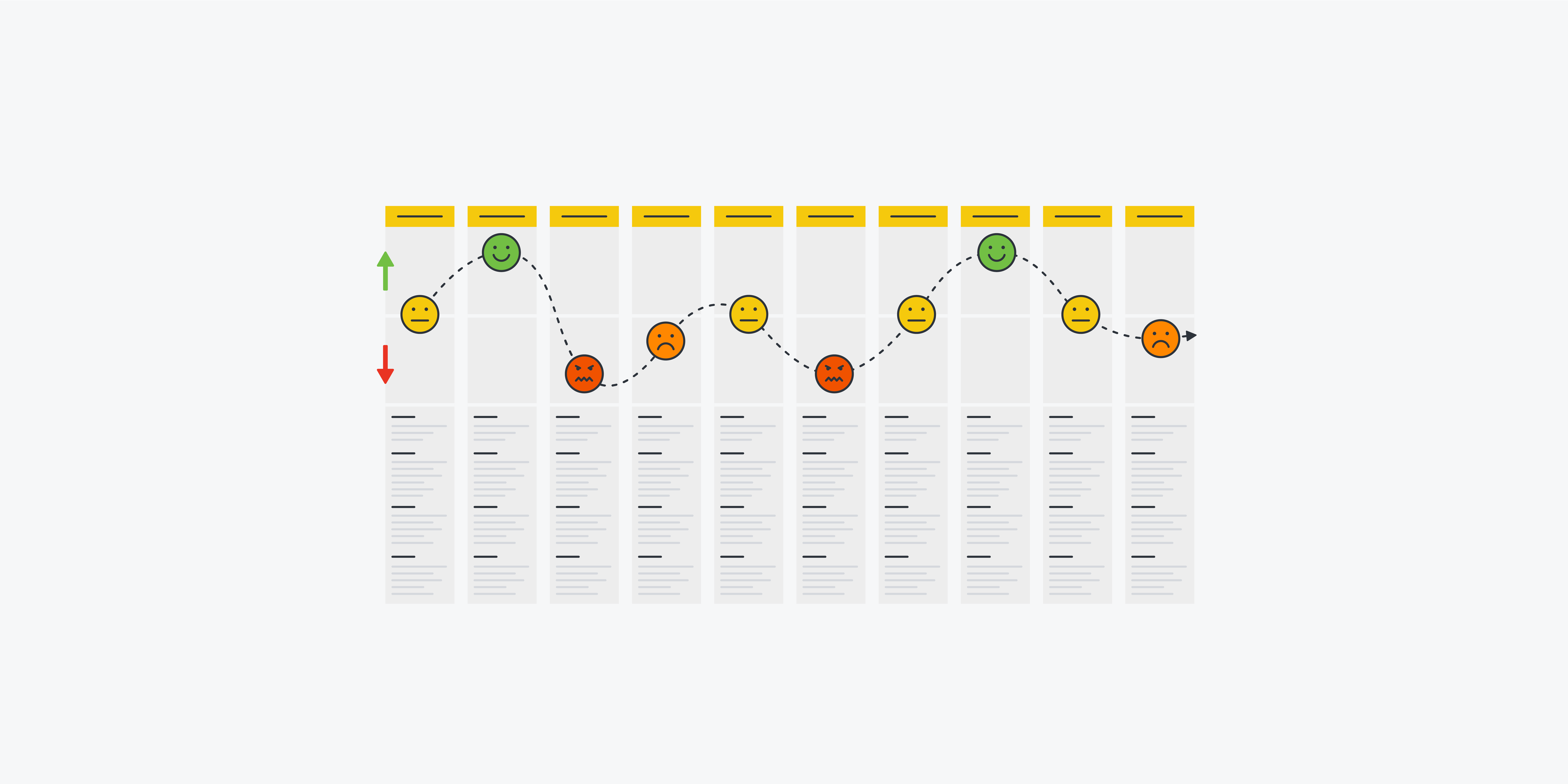
Successful UX design is rooted in empathy. The best designers are able to step into their users’ shoes and imagine what they think, feel, and experience as they interact with a product or service.
One of the most effective ways to foster user empathy and consider different perspectives is to create customer journey maps—otherwise known as customer journey maps.
If you’re new to journey mapping, look no further than this guide. We’ll explain:
- What is a customer journey map?
Why create customer journey maps?
When to create customer journey maps, what are the elements of a customer journey map, how to create a customer journey map (step-by-step).
If you want to skip straight to the how-to guide, just use the clickable menu to jump ahead. Otherwise, let’s begin with a definition.
[GET CERTIFIED IN UX]
What is a customer journey map?
A customer journey map (otherwise known as a user journey map) is a visual representation of how a user or customer interacts with your product. It maps out the steps they go through to complete a specific task or to achieve a particular goal—for example, purchasing a product from an e-commerce website or creating a profile on a dating app.
Where does their journey begin? What’s their first point of interaction with the product? What actions and steps do they take to reach their end goal? How do they feel at each stage?
You can answer all of those questions with a user journey map.
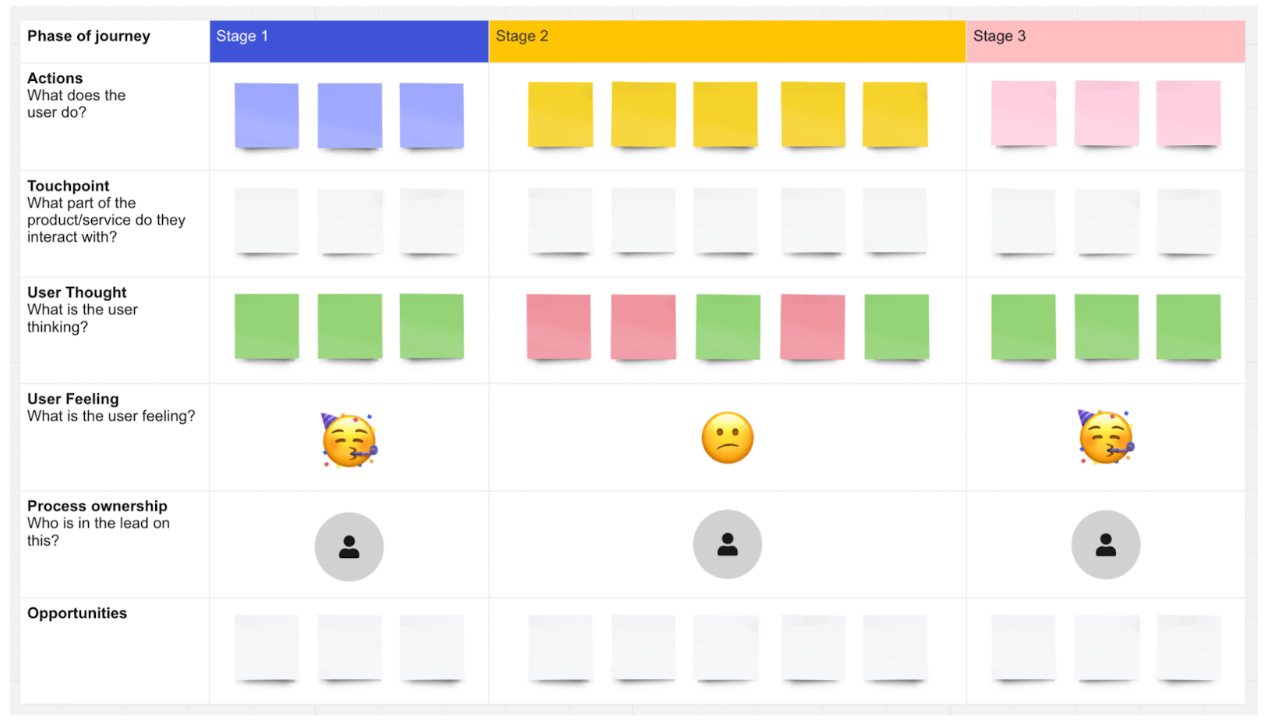
A user journey map template from Miro .
Creating customer journey maps helps to:
- Centre the end user and foster empathy. Creating a user/customer journey map requires you to step into the end user’s shoes and experience the product from their perspective. This reminds you to consider the user at all times and fosters empathy.
- Expose pain-points in the user experience. By viewing the product from the user’s perspective, you quickly become aware of pain-points or stumbling blocks within the user experience. Based on this insight, you can improve the product accordingly.
- Uncover design opportunities. User journey maps don’t just highlight pain-points; they can also inspire new ideas and opportunities. As you walk in your end user’s shoes, you might think “Ah! An [X] feature would be great here!”
- Get all key stakeholders aligned. User journey maps are both visual and concise, making them an effective communication tool. Anybody can look at a user journey map and instantly understand how the user interacts with the product. This helps to create a shared understanding of the user experience, building alignment among multiple stakeholders.
Ultimately, user journey maps are a great way to focus on the end user and understand how they experience your product. This helps you to create better user experiences that meet your users’ needs.
User journey maps can be useful at different stages of the product design process.
Perhaps you’ve got a fully-fledged product that you want to review and optimise, or completely redesign. You can create journey maps to visualise how your users currently interact with the product, helping you to identify pain-points and inform the next iteration of the product.
You can also create user journey maps at the ideation stage. Before developing new ideas, you might want to visualise them in action, mapping out potential user journeys to test their validity.
And, once you’ve created user journey maps, you can use them to guide you in the creation of wireframes and prototypes . Based on the steps mapped out in the user journey, you can see what touchpoints need to be included in the product and where.
No two user journey maps are the same—you can adapt the structure and content of your maps to suit your needs. But, as a rule, user journey maps should include the following:
- A user persona. Each user journey map represents the perspective of just one user persona. Ideally, you’ll base your journey maps on UX personas that have been created using real user research data.
- A specific scenario. This describes the goal or task the journey map is conveying—in other words, the scenario in which the user finds themselves. For example, finding a language exchange partner on an app or returning a pair of shoes to an e-commerce company.
- User expectations. The goal of a user journey map is to see things from your end user’s perspective, so it’s useful to define what their expectations are as they complete the task you’re depicting.
- High-level stages or phases. You’ll divide the user journey into all the broad, high-level stages a user goes through. Imagine you’re creating a user journey map for the task of booking a hotel via your website. The stages in the user’s journey might be: Discover (the user discovers your website), Research (the user browses different hotel options), Compare (the user weighs up different options), Purchase (the user books a hotel).
- Touchpoints. Within each high-level phase, you’ll note down all the touchpoints the user comes across and interacts with. For example: the website homepage, a customer service agent, the checkout page.
- Actions. For each stage, you’ll also map out the individual actions the user takes. This includes things like applying filters, filling out user details, and submitting payment information.
- Thoughts. What is the user thinking at each stage? What questions do they have? For example: “I wonder if I can get a student discount” or “Why can’t I filter by location?”
- Emotions. How does the user feel at each stage? What emotions do they go through? This includes things like frustration, confusion, uncertainty, excitement, and joy.
- Pain-points. A brief note on any hurdles and points of friction the user encounters at each stage.
- Opportunities. Based on everything you’ve captured in your user journey map so far, what opportunities for improvement have you uncovered? How can you act upon your insights and who is responsible for leading those changes? The “opportunities” section turns your user journey map into something actionable.
Here’s how to create a user journey map in 6 steps:
- Choose a user journey map template (or create your own)
- Define your persona and scenario
- Outline key stages, touchpoints, and actions
- Fill in the user’s thoughts, emotions, and pain-points
- Identify opportunities
- Define action points and next steps
Let’s take a closer look.
[GET CERTIFIED IN UI DESIGN]
1. Choose a user journey map template (or create your own)
The easiest way to create a user journey map is to fill in a ready-made template. Tools like Miro , Lucidchart , and Canva all offer user/customer journey map templates that you can fill in directly or customise to make your own.
Here’s an example of a user journey map template from Canva:
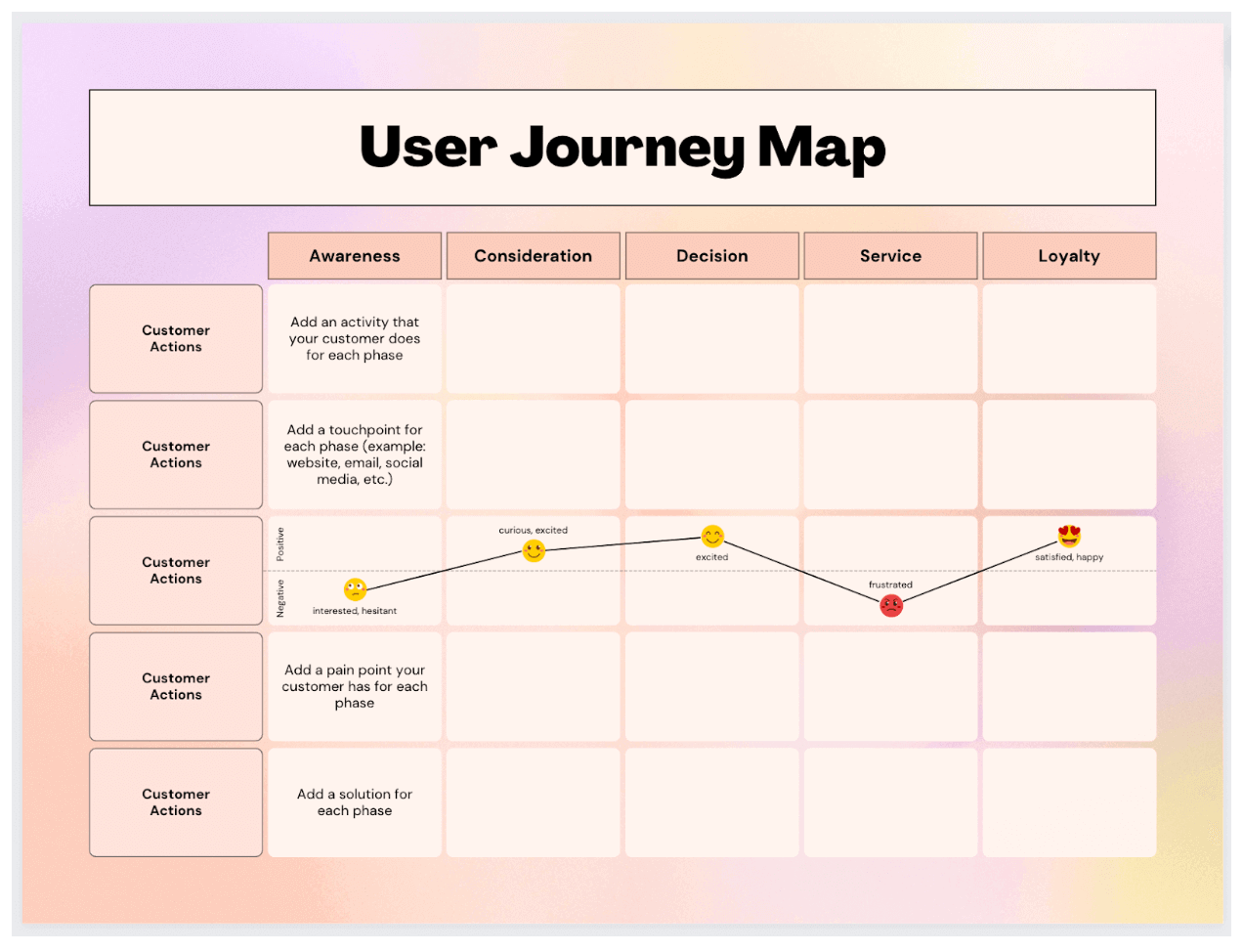
2. Define your persona and scenario
Each user journey map you create should represent a specific user journey from the perspective of a specific user persona. So: determine which UX persona will feature in your journey map, and what scenario they’re in. In other words, what goal or task are they trying to complete?
Add details of your persona and scenario at the top of your user journey map.
3. Outline key stages, actions, and touchpoints
Now it’s time to flesh out the user journey itself. First, consider the user scenario you’re conveying and think about how you can divide it into high-level phases.
Within each phase, identify the actions the user takes and the touchpoints they interact with.
Take, for example, the scenario of signing up for a dating app. You might divide the process into the following key phases: Awareness, Consideration, Decision, Service, and Advocacy .
Within the Awareness phase, possible user actions might be: Hears about the dating app from friends, Sees an Instagram advert for the app, Looks for blog articles and reviews online.
4. Fill in the user’s thoughts, emotions, and pain-points
Next, step even further into your user’s shoes to imagine what they may be thinking and feeling at each stage, as well as what pain-points might get in their way.
To continue with our dating app example, the user’s thoughts during the Awareness phase might be: “ I’ve never used online dating before but maybe I should give this app a try…”
As they’re new to online dating, they may be feeling both interested and hesitant.
While looking for blog articles and reviews, the user struggles to find anything helpful or credible. This can be added to your user journey map under “pain-points”.
5. Identify opportunities
Now it’s time to turn your user pain-points into opportunities. In our dating app example, we identified that the user wanted to learn more about the app before signing up but couldn’t find any useful articles or reviews online.
How could you turn this into an opportunity? You might start to feature more dating app success stories on the company blog.
Frame your opportunities as action points and state who will be responsible for implementing them.
Here we’ve started to fill out the user journey map template for our dating app scenario:
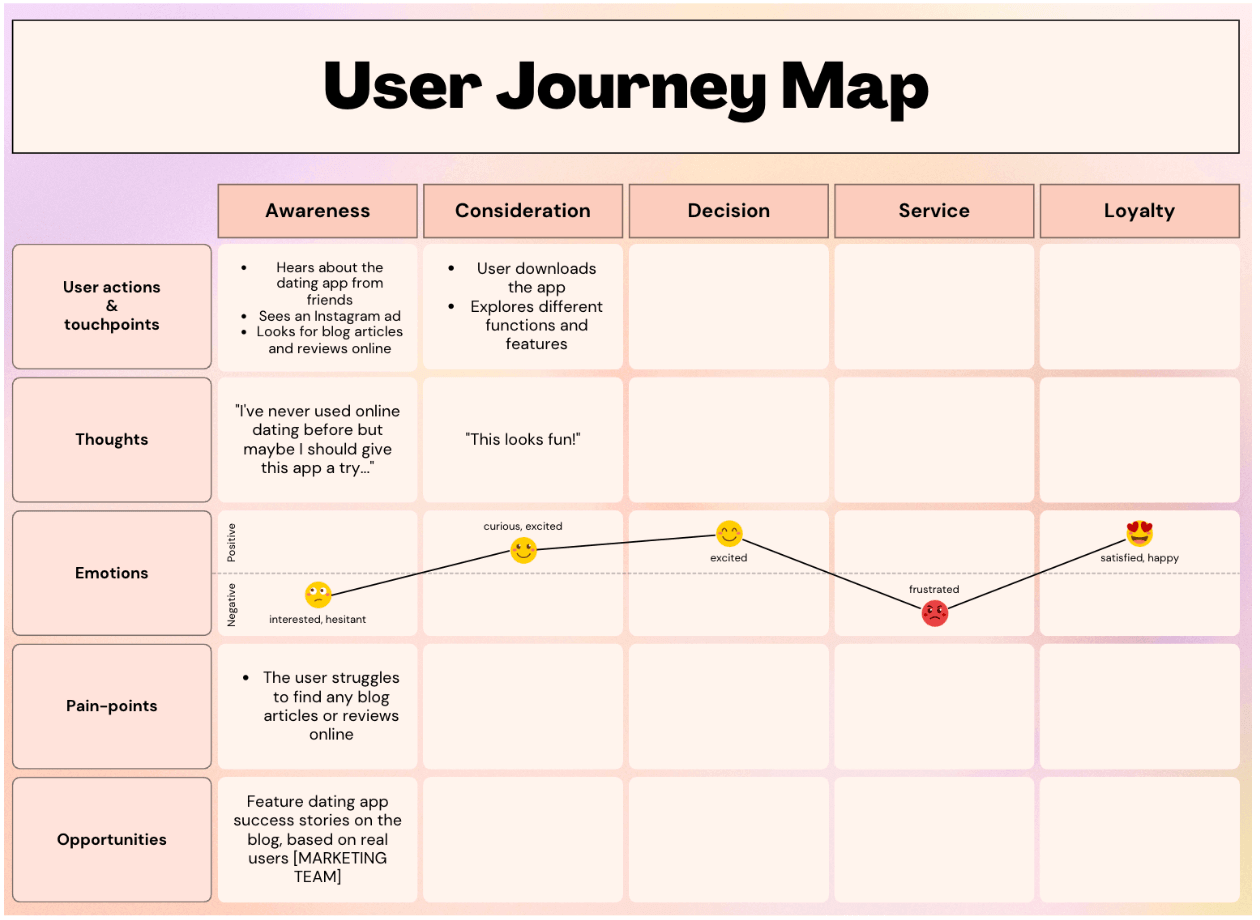
Repeat the process for each phase in the user journey until your map is complete.
6. Define action points and next steps
User journey maps are great for building empathy and getting you to see things from your user’s perspective. They’re also an excellent tool for communicating with stakeholders and creating a shared understanding around how different users experience your product.
Once your user journey map is complete, be sure to share it with all key stakeholders and talk them through the most relevant insights.
And, most importantly, turn those insights into clear action points. Which opportunities will you tap into and who will be involved? How will your user journey maps inform the evolution of your product? What are your next steps?
Customer journey maps in UX: the takeaway
That’s a wrap for user journey maps! With a user journey map template and our step-by-step guide, you can easily create your own maps and use them to inspire and inform your product design process.
For more how-to guides, check out:
- The Ultimate Guide to Storyboarding in UX
- How to Design Effective User Surveys for UX Research
- How to Conduct User Interviews
Subscribe to our newsletter
Get the best UX insights and career advice direct to your inbox each month.
Thanks for subscribing to our newsletter
You'll now get the best career advice, industry insights and UX community content, direct to your inbox every month.
Upcoming courses
Professional diploma in ux design.
Learn the full UX process, from research to design to prototyping.
Professional Certificate in UI Design
Master key concepts and techniques of UI design.
Certificate in Software and Coding Fundamentals for UX
Collaborate effectively with software developers.
Certificate in UX Design Fundamentals
Get a comprehensive introduction to UX design.
Professional Certificate in Content Design
Learn the skills you need to start a career in content design.
Professional Certificate in User Research
Master the research skills that make UX professionals so valuable.
Upcoming course
Build your UX career with a globally-recognised, industry-approved certification. Get the mindset, the skills and the confidence of UX designers.
You may also like
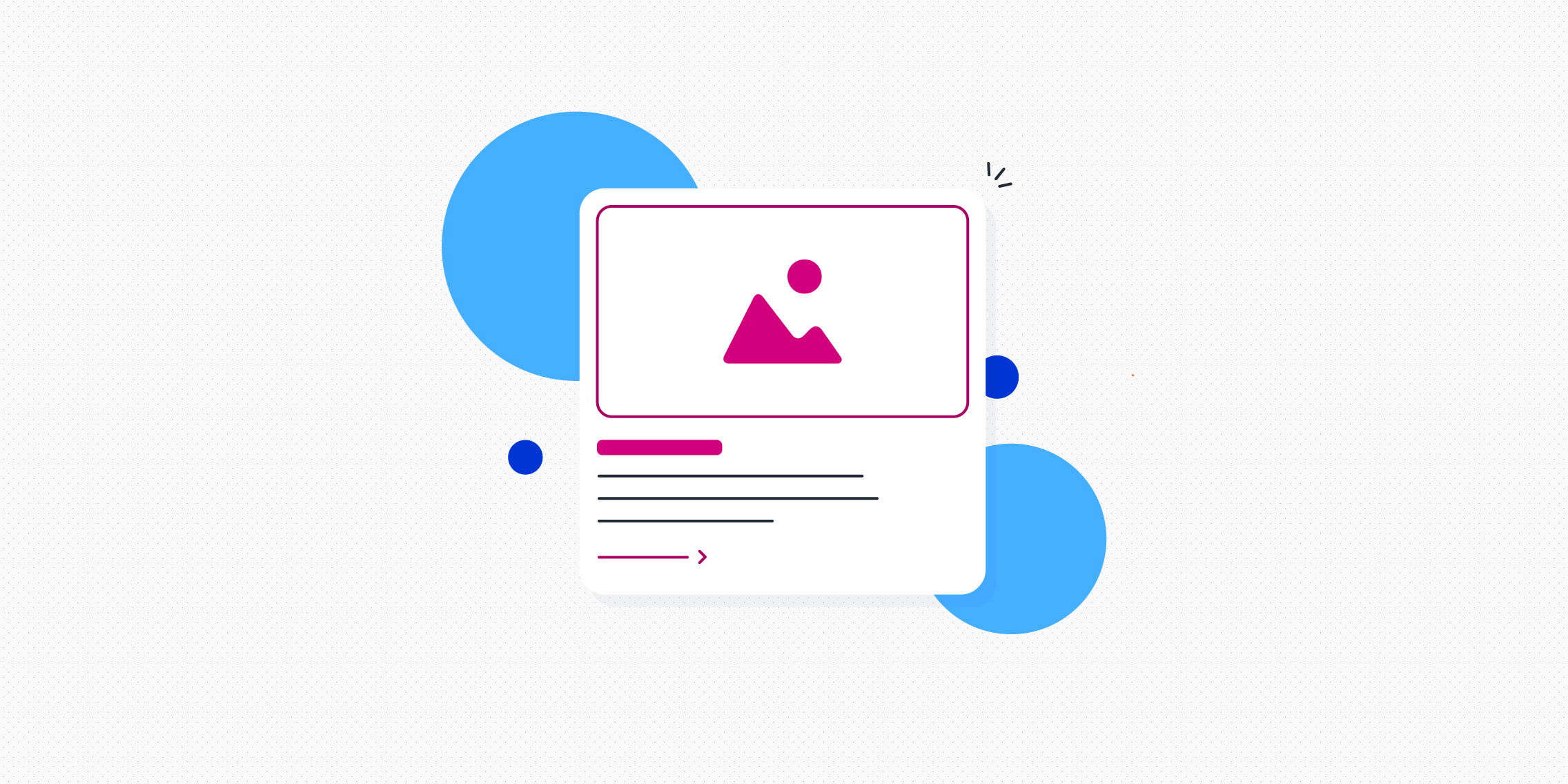
The ultimate guide to card design for UI (with examples)
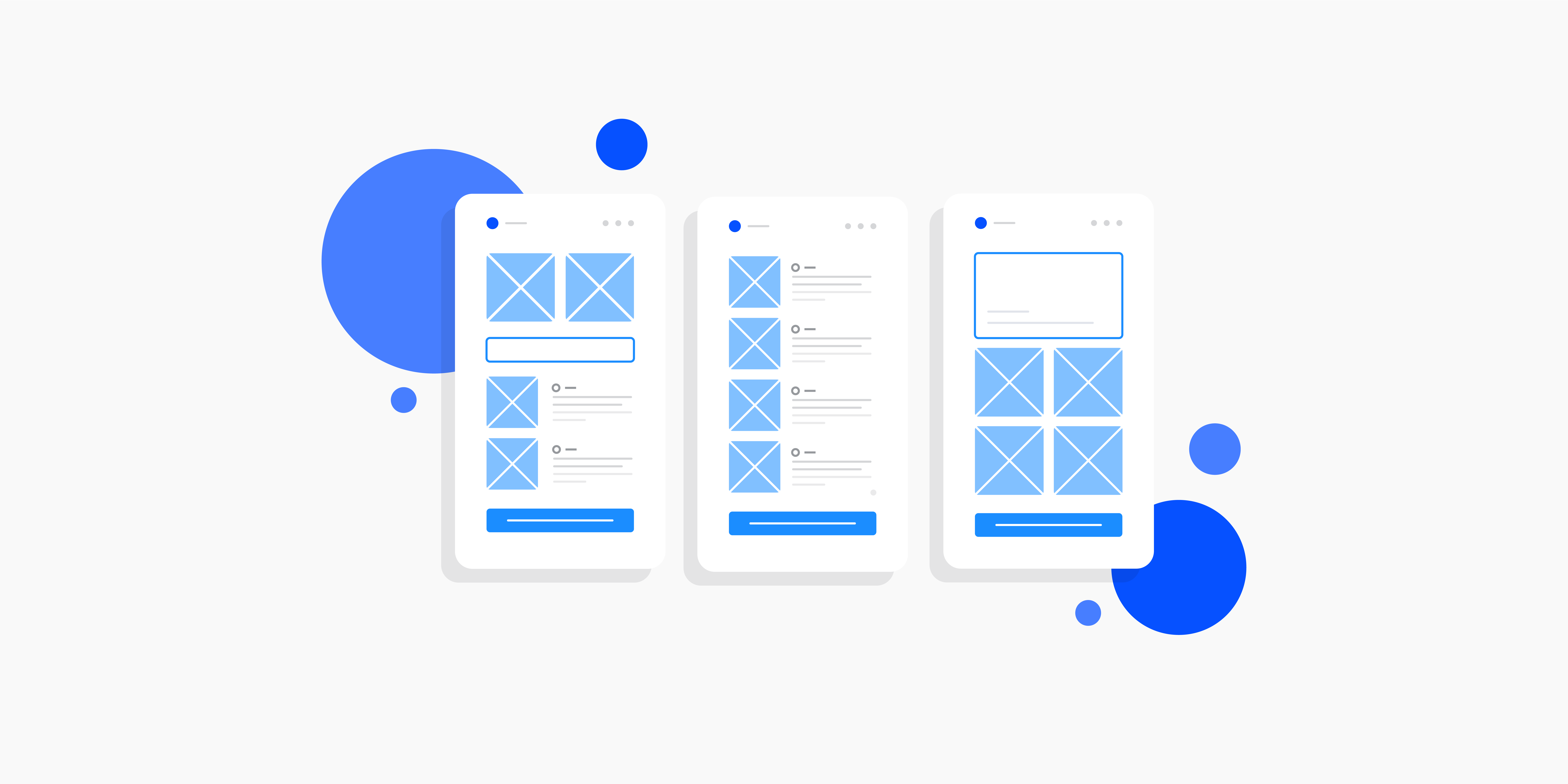
The ultimate guide to mobile app design: Follow these UI principles & best practices
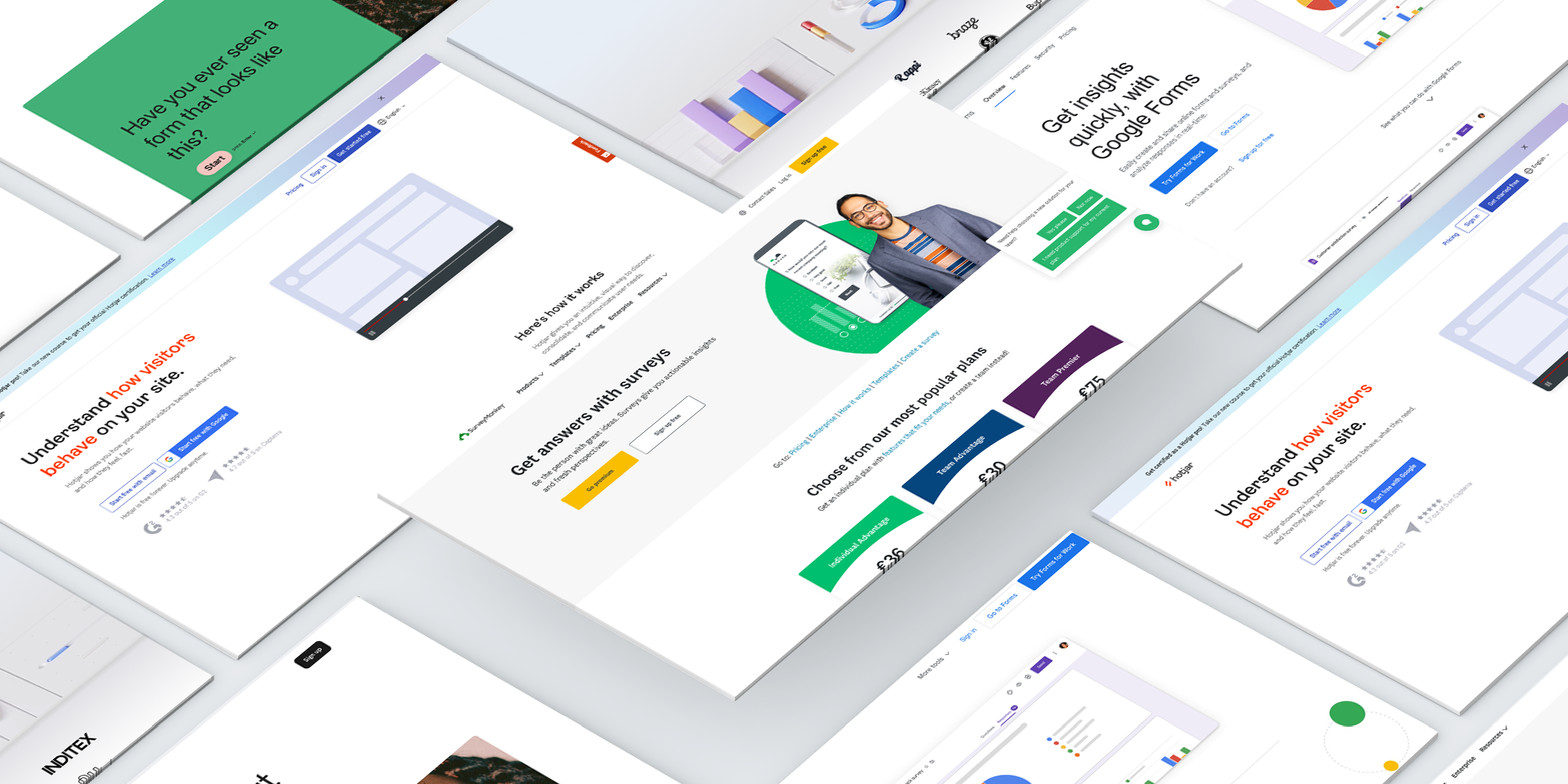
The best online survey tools to use in 2024
Build your UX career with a globally recognised, industry-approved qualification. Get the mindset, the confidence and the skills that make UX designers so valuable.
8 October 2024
Customer Journey Mapping
Journey mapping helps you visualize how customers experience your product or service, and how they feel along the way. Scroll to step 6 for a real-life example from one of our product teams!
USE THIS PLAY TO...
Understand the customer journey from a specific persona's perspective so that you can design a better experience.

Running the play
Depending on how many touchpoints along the customer journey you're mapping, you might break the journey into stages and tackle each stage in pairs.
Sticky notes
Whiteboards.io Template
Define the map's scope (15 min)
Ideally, customer journey mapping focuses on the experience of a single persona in a single scenario with a single goal. Else, the journey map will be too generic, and you'll miss out on opportunities for new insights and questions. You may need to pause creating a customer journey map until you have defined your customer personas . Your personas should be informed by customer interviews , as well as data wherever possible.
Saying that, don't let perfect be the enemy of good! Sometimes a team just needs to get started, and you can agree to revisit with more rigor in a few months' time. Once scope is agreed on, check your invite list to make sure you've got people who know the details of what customers experience when using your product or service.
Set the stage (5 min)
It's really important that your group understands the user persona and the goal driving their journey. Decide on or recap with your group the target persona and the scope of the journey being explored in your session. Make sure to pre-share required reading with the team at least a week ahead of your session to make sure everyone understands the persona, scope of the journey, and has a chance to delve deeper into research and data where needed. Even better- invite the team to run or attend the customer interviews to hear from customers first hand!
E.g. "We're going to focus on the Alana persona. Alana's role is project manager, and her goal is to find a scalable way for her team to share their knowledge so they spend less time explaining things over email. We're going to map out what it's like for Alana to evaluate Confluence for this purpose, from the point where she clicks that TRY button, to the point where she decides to buy it – or not."
Build a customer back-story (10 min)
Have the group use sticky notes to post up reasons why your target persona would be on this journey in the first place. Odds are, you'll get a range of responses: everything from high-level goals, to pain points, to requested features or services. Group similar ideas and groom the stickies so you can design a story from them.
These narratives should be inspired by actual customer interviews. But each team member will also bring a different perspective to the table that helps to broaden the lens.
Take a look at the example provided in the call out of this section. This back story starts with the pain points – the reasons why Alana would be wanting something like Confluence in the first place.
- E.g., "Her team's knowledge is in silos"
Then it basically has a list of requirements – what Alana is looking for in a product to solve the bottom pain points. This is essentially a mental shopping list for the group to refer to when mapping out the customer journey.
- E.g., "Provide structure"
Then it has the outcomes – goals that Alana wants to achieve by using the product
- E.g., "To keep my team focused on their work instead of distracted by unnecessary emails and shoulder-taps"
And finally the highest-level goal for her and her team.
- E.g., "Improve team efficiency"
Round off the back story by getting someone to say out loud what they think the overall story so far is, highlighting the main goals the customer has. This ensures a shared understanding that will inform the journey mapping, and improve the chances that your team will map it from the persona's point of view (not their own).
- E.g., "Alana and her team are frustrated by having to spend so much time explaining their work to each other, and to stakeholders. They want a way to share their knowledge, and organize it so it's easy for people outside their team to find, so they can focus more energy on the tasks at hand."

For example...
Here's a backstory the Confluence team created.
Map what the customer thinks and feels (30-60 min)
With the target persona, back story, and destination in place, it's time to walk a mile in their shoes. Show participants how to get going by writing the first thing that the persona does on a sticky note. The whole group can then grab stickies and markers and continue plotting the journey one action at a time.
This can also include questions and decisions! If the journey branches based on the answers or choices, have one participant map out each path. Keep in mind that the purpose of this Play is to build empathy for, and a shared understanding of the customer for the team. In order to do this, we focus on mapping the current state of one discrete end to end journey, and looking for opportunities for improvement.
To do a more comprehensive discovery and inform strategy, you will need to go deeper on researching and designing these journey maps, which will need to split up over multiple sessions. Take a look at the variation below for tipes on how to design a completely new customer journey.
Use different color sticky notes for actions, questions, decisions, etc. so it's easier to see each element when you look at the whole map.
For each action on the customer journey, capture which channels are used for the interactions. Depending on your context, channels might include a website, phone, email, postal mail, face-to-face, and/or social media.
It might also help to visually split the mapping area in zones, such as "frontstage" (what the customer experiences) versus "backstage" (what systems and processes are active in the background).
Journey mapping can open up rich discussion, but try to avoid delving into the wrong sort of detail. The idea is to explore the journey and mine it for opportunities to improve the experience instead of coming up with solutions on the spot. It's important not only to keep the conversation on track, but also to create an artefact that can be easily referenced in the future. Use expands or footnotes in the Confluence template to capture any additional context while keeping the overview stable.
Try to be the commentator, not the critic. And remember: you're there to call out what’s going on for the persona, not explain what’s going on with internal systems and processes.
To get more granular on the 'backstage' processes required to provide the 'frontstage' customer value, consider using Confluence Whiteboard's Service Blueprint template as a next step to follow up on this Play.

ANTI-PATTERN
Your map has heaps of branches and loops.
Your scope is probably too high-level. Map a specific journey that focuses on a specific task, rather than mapping how a customer might explore for the first time.
Map the pain points (10-30 min)
"Ok, show me where it hurts." Go back over the map and jot down pain points on sticky notes. Place them underneath the corresponding touchpoints on the journey. Where is there frustration? Errors? Bottlenecks? Things not working as expected?
For added value, talk about the impact of each pain point. Is it trivial, or is it likely to necessitate some kind of hack or work-around. Even worse: does it cause the persona to abandon their journey entirely?
Chart a sentiment line (15 min)
(Optional, but totally worth it.) Plot the persona's sentiment in an area under your journey map, so that you can see how their emotional experience changes with each touchpoint. Look for things like:
- Areas of sawtooth sentiment – going up and down a lot is pretty common, but that doesn't mean it's not exhausting for the persona.
- Rapid drops – this indicates large gaps in expectations, and frustration.
- Troughs – these indicate opportunities for lifting overall sentiments.
- Positive peaks – can you design an experience that lifts them even higher? Can you delight the persona and inspire them to recommend you?
Remember that pain points don't always cause immediate drops in customer sentiment. Sometimes some friction may even buold trust (consider requiring verification for example). A pain point early in the journey might also result in negative feelings later on, as experiences accumulate.
Having customers in the session to help validate and challenge the journey map means you'll be more confident what comes out of this session.
Analyse the big picture (15 min)
As a group, stand back from the journey map and discuss trends and patterns in the experience.
- Where are the areas of greatest confusion/frustration?
- Where is the journey falling short of expectations?
- Are there any new un-met needs that have come up for the user type?
- Are there areas in the process being needlessly complicated or duplicated? Are there lots of emails being sent that aren’t actually useful?
Then, discuss areas of opportunity to improve the experience. E.g., are there areas in the process where seven steps could be reduced to three? Is that verification email actually needed?
You can use quantitative data to validate the impact of the various opportunity areas identified. A particular step may well be a customer experience that falls short, but how many of your customers are actually effected by that step? Might you be better off as a team focused on another higher impact opportunity?
Here's a user onboarding jouney map our Engaging First Impressions team created.
Be sure to run a full Health Monitor session or checkpoint with your team to see if you're improving.
MAP A FUTURE STATE
Instead of mapping the current experience, map out an experience you haven't delivered yet. You can map one that simply improves on existing pain points, or design an absolutely visionary amazeballs awesome experience!
Just make sure to always base your ideas on real customer interviews and data. When designing a totally new customer journey, it can also be interesting to map competitor or peer customer journeys to find inspiration. Working on a personalised service? How do they do it in grocery? What about fashion? Finance?
After the mapping session, create a stakeholder summary. What pain points have the highest impact to customers' evaluation, adoption and usage of our products? What opportunities are there, and which teams should know about them? What is your action plan to resolve these pain points? Keep it at a summary level for a fast share out of key takeaways.
For a broader audience, or to allow stakeholders to go deeper, you could also create a write-up of your analysis and recommendations you came up with, notes captured, photos of the group and the artefacts created on a Confluence page. A great way of sharing this information is in a video walk through of the journey map. Loom is a great tool for this as viewers can comment on specific stages of the journey. This can be a great way to inspire change in your organization and provide a model for customer-centric design practices.
KEEP IT REAL
Now that you have interviewed your customers and created your customer journey map, circle back to your customers and validate! And yes: you might learn that your entire map is invalid and have to start again from scratch. (Better to find that out now, versus after you've delivered the journey!) Major initiatives typically make multiple journey maps to capture the needs of multiple personas, and often iterate on each map. Remember not to set and forget. Journeys are rapidly disrupted, and keeping your finger on the pulse of your customer's reality will enable your team to pivot (and get results!) faster when needed.

Related Plays
Customer Interview
Project Poster
Want even more Playbook?
Drop your email below to be notified when we add new Health Monitors and plays.
Thanks! Now get back to work.
Got feedback?
Drop a question or comment on the Atlassian Community site.
Shared understanding
Different types of teams need to share an understanding of different things.
LEADERSHIP TEAMS
The team has a shared vision and collective purpose which they support, and confidence they have made the right strategic bets to achieve success.
Proof of concept
Project teams.
Some sort of demonstration has been created and tested, that demonstrates why this problem needs to be solved, and demonstrates its value.
Customer centricity
Service teams.
Team members are skilled at understanding , empathizing and resolving requests with an effective customer feedback loop in place that drives improvements and builds trust to improve service offerings.
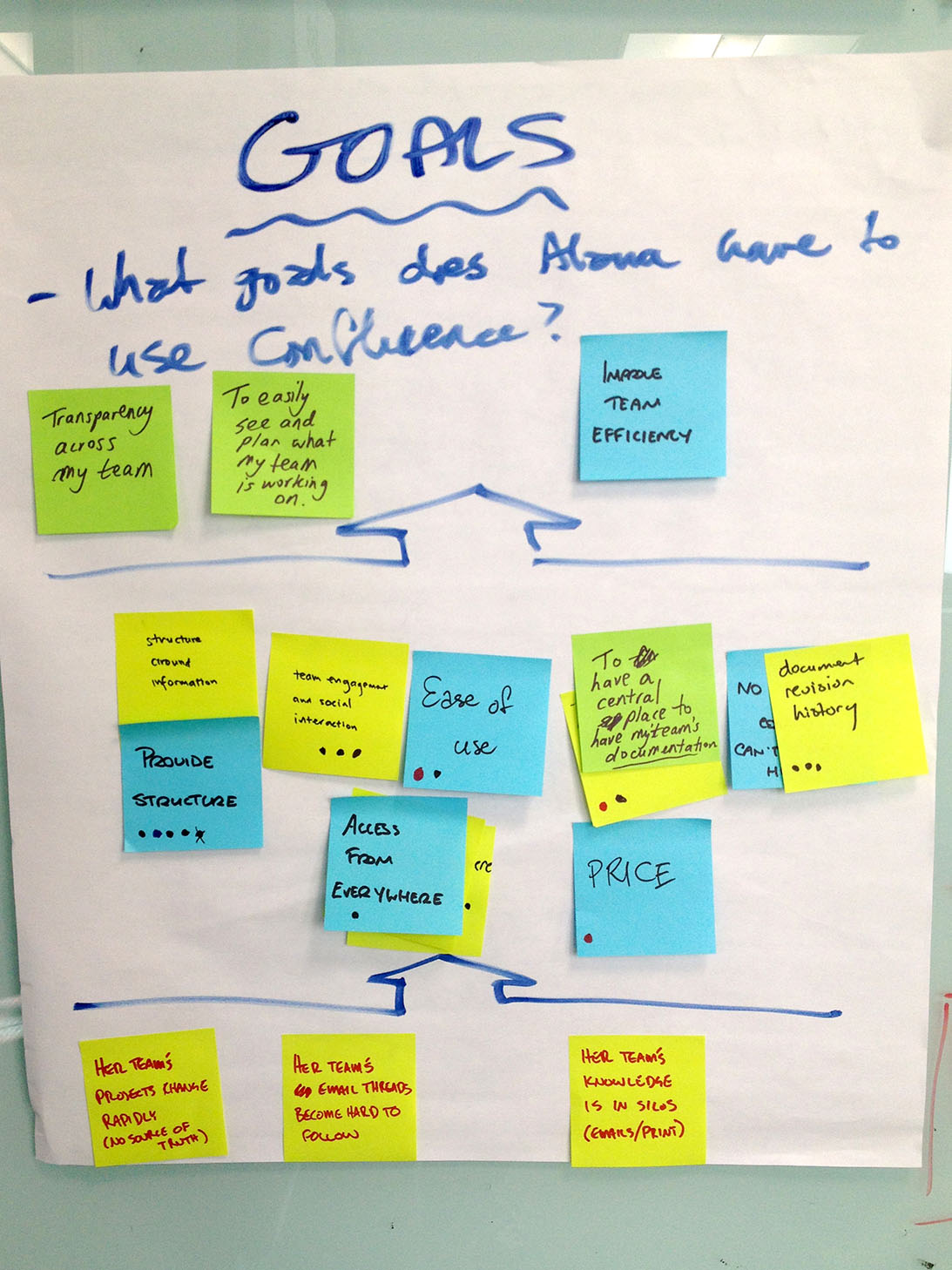

Personas and Journey Maps: Strategic tools for improving customer experience
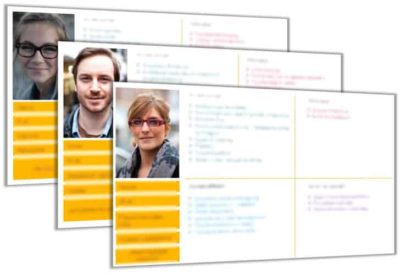
But more importantly, for sharing customer insights across the organization, these tools can be critical for building buy-in and helping teams take targeted action to improve customer experience .
To get started, you’ll want a clear understanding of what customer personas are, why they’re important, and what makes a good persona. Once you’ve created your personas, you can take a walk in your customers’ shoes with a journey map .
What are personas?
Personas are fictional, yet believable archetypes you can develop to represent your target customers. They go deeper than generalized customer segments by having individual names and stories that reflect personal attributes and behavioral characteristics such as needs, motivations, attitudes, and pain points.
Why are personas important?
Personas have been commonly used to help organizations develop user-centered design. As focus on customer experience has increased in recent years, personas are gaining popularity as a tool to benefit a wide range of departments across an enterprise from sales and customer service to operations and HR.
Personas can help guide customer-centric practices in various ways:
- Develop a deeper understanding of your customers Like Jeff Bezos’ empty chair that represents “the most important person in the room,” personas help you build empathy with your customers. What are their needs and goals? What motivates them? Why do they behave in certain ways?
- Design processes with the customer in mind Personas help you understand how your customers interact with your company throughout the entire lifecycle. Do your processes reflect the true customer experience, or do they reflect your internal operations? Personas provide awareness of the many journeys your customers may take, so you can improve them.
- Build stakeholder buy-in To build support for an enterprise-wide customer experience initiative, personas – especially those backed with data and research – can help you describe to executives and stakeholders what a better experience should look like.
Tips for creating highly effective personas
- Align with business objectives to help make your personas powerful tools for teams across the company. Engage key stakeholders to gain diverse perspectives on goals, processes, and issues unique to different lines of business that influence the overall customer experience.
- Use data and research to identify and inform each of your personas. Market segmentation research, surveys, interviews, and social customer insights are all useful methods. This qualitative research can complement your understanding of how customers behave with insight into the “whys,” providing important nuance and detail that humanize your personas.
- Demographics : Age, location, education, income, household or family size
- Personal attributes : Their goals, needs, and interests when they interact with your company
- Customer lifecycle : How their needs may vary for different channels and touch points, and how their needs may evolve over time
- Make them eye-catching and memorable with polished, professional quality photos and information layouts for socializing the personas across your organization. The more “real” you can make them, the more your teams can identify with them and map their own actions and attitudes toward delivering the best possible customer experience.
Using personas to map the customer journey
Once you’ve created distinct personas, you can use them to create customer journey maps that describe each persona’s experience at various touch points during their lifecycle with your company. An effective journey map is based on real research and behavior, and should represent the true customer experience– good or bad. That way you build an accurate picture of where you need to make improvements as well as where opportunities exist for cross-sell and up-sell.
Much of the information for creating a journey map will come from your personas (e.g., their goals, motivations, key tasks they want to accomplish, and current pain points), which is why it’s best to create the personas first .
At each step, the journey map should consider factors such as:
- Context – Where is the interaction taking place (e.g., in your store, on the phone, online or mobile, in social media) What is going on around the customer? How might their current context influence how they need to interact and what they want to do?
- Progression – How does each step enable the next?
- Emotion – How does the customer feel at each step? (e.g., are they engaged, bored, or frustrated?)
With a detailed and insightful customer journey map, your business can more effectively assess current and proposed processes, identify targeted actions to resolve pain points, and leverage opportunities for building stronger customer relationships.
The wins from using personas and customer journey maps
Companies can use personas and journey maps to rally employees behind the common goal of improving and optimizing the customer experience. That shared commitment is key to building a customer-centric culture. From there, your organization has the best chance to deliver what your customers want, understand how to exceed their expectations, and create experiences that nurture brand loyalty.
Bottom line? Investing in small powerful tools can translate into very big wins for you and your customers.
Interested to explore customer personas and journey mapping can work for you? Let’s talk!
You might also be interested in…
- White paper Download: Using Personas and Journey Maps
- Customer Personas & Journey Maps – Success Stories and Use Cases
- Prioritizing projects with customer journey analytic
Share This Story, Choose Your Platform!

- Work With Us
Advisory Services
- Customer Experience Training And Workshops
- Customer Experience Coaching And Consulting
- CXI Ground School TM
- Speaking & Thought Leadership
- Jeannie Walters, CCXP, CSP
- Get Started with CX
- Align Organizational Vision & Goals
- Build Customer Journey Maps
- Connect with Customers
- Create a Customer-Centric Culture
- Take Action
- Audio & Podcasts
- Workbooks & Guides
CXI Ground School™ – Learn More Here
CXI Compass™ – Identify your next steps to CX Excellence
Quick Start Guide to Customer Experience Leadership
10 Critical Components of Successful Customer Experience Programs
Learning Center
How to build a customer experience persona.
More From Our Learning Center
Similar Articles
Customer Journey Mapping Examples: 4 Use Cases to Inform Your CX Strategy
Customers want personalized experiences and privacy. can they have both, what is the meaning of quality to customers.
- Create a Customer-Centric Culturee
Developing CX Personas: The Step Before Journey Mapping
In my work consulting, training, and running workshops , one consistent theme I find is teams are super eager to begin the Customer Journey Mapping process.
I get it. Customer Journey Mapping can reveal — and help solve — a lot of problems in the customer journey. But in order to do so, those journey maps must be built on a foundation of a true picture of your customer.
Maybe you’ve heard leaders on your CX team say something along the lines of, “We know our customers.” But if you asked ten people across your organization, how many varying answers would you get?
A Customer Persona — and especially a CX-focused one — can help paint an accurate picture of your customer and communicate that across your organization, empowering your employees and leading to better outcomes across the board.
In this article, we’ll look at what a Customer Experience Persona is, how to create one, and how to use it when it’s done.
What is a CX Persona?
CX Personas are fictionalized archetypes representing your customer. They help everyone in your organization identify who this person really is, instead of relying on collective data that dehumanizes the customer.
In business-to-consumer (B2C) organizations, customer personas are typically about the main shopper or buyer of the product. In business-to-business (B2B) organizations, personas often focus on the professional role the customer has within the client organization, including their likely title and department.
A Customer Experience Persona typically consists of one page of both an image and high-level bullets about your customer. Sometimes they include quotes and additional information about the goals of your customer.
Ultimately, these help identify general truths about your customer including their:
- Expectations
- Motivations
- Frustrations
- Emotional Drivers
CX Personas vs Buyer Personas & Avatars
A CX Persona is not the same as a buyer persona (which is more focused around sales and marketing) nor is it the same as an avatar (which tends to be more focused on your ideal customer rather than your true customer).
Does your organization already use one of these other types of personas or avatars? If so, you can definitely refer back to these when developing your CX Persona — but don’t make a carbon copy and consider your work done.
Here’s a quick comparison between Buyer Personas/Avatars and CX Personas:
Buyer Personas/Avatars:
- Tend to focus on demographic information like age, gender, & income level
- Generally paint a picture of an ideal customer
- Are centered around sales and marketing as they relate to the business
CX Personas:
- Go beyond demographics to paint a more complete picture of your customer’s life
- Paint a picture of your true current customer
- Are centered around improving the customer journey and are written from the customer’s point of view
Customer Experience Personas are an incredible foundational tool to support building great customer journey maps. Which leads to the question…
How Do You Build a CX Persona?
When my team and I work with clients to build CX Personas, our work revolves around four main steps:
- Decide on the goal of the project
- Define and consider the specific points of interaction between the customer persona and your brand
- Build your persona using a common template
- Tap into the data available to you
Let’s look at each step in more detail.
1. Decide on the goals of the project
Before you begin building a persona, it’s key to know and agree upon what it will be used for.
No single Customer Journey Map is all-encompassing. Most organizations have many journeys, varying depending on the product/service, type of customer, or other context.
Even if you only have one core path for customers, that path can be micromapped — broken up into smaller journeys and mapped.
What do you want to do with the Persona you develop?
- Is there a specific journey or group of touchpoints you want to address?
- Maybe there are key outcomes you’re looking to achieve, like reduced cart abandonment, increased customer loyalty, or fewer support requests.
- Do you have a known issue you’re trying to fix, or are you trying to uncover issues as you go?
Record these goals and communicate them with the team you’ll be working with to develop the CX Persona. As you move through the remaining steps, refer back to these regularly and ask: “Is the work we’re doing in service of these goals?”
If so, you can move forward confidently. If not, no problem — it’s simply a chance to recognize this and adjust along the way.
2. Define and consider the specific points of interaction between your customer persona and your brand.
Now that your goals have been defined and communicated, you can dive into specific touchpoints along the way.
Don’t worry about having all the answers at this point… After all, that’s what Customer Journey Mapping is for.
For now, think about:
- The general type of customer you want to develop a persona for
- The journey you want to map for this customer
- The points of interaction for that customer within that journey
For example, let’s say a bank wants to create a customer persona for new homebuyers seeking a home mortgage, and the journey they want to focus on is specifically the initial inquiry process online.
Points of interaction in this example might include:
- Finding an informational landing page via search engine
- Reading about the process
- Requesting an informational meeting
- Confirming the meeting and getting it into their calendar
- Having the meeting and getting questions answered
- Leaving with more information and next steps
We’re not journey mapping (yet), so it’s okay if these points of interaction aren’t especially specific or precise.
A great activity to try at this stage is Customer Journey Storyboarding, which can help you identify key touchpoints in a simple, visual way.
- [Article] An Introduction to Customer Journey Storyboarding
- [Free Resource] Customer Journey Storyboarding Template
Simply understanding and recording the general touchpoints that a customer will go through will help you paint a picture of what kinds of information will be most helpful when building your persona.
3. Use a common template to create all your CX Personas.
Wait a second — “All our personas?” Aren’t we just creating one?
Well, yes and no.
While we want to create one persona for one journey at a time, almost all organizations serve more than one persona.
Using a common template across CX Personas offers a few key benefits:
- Subsequent personas become easier to create
- Personas can more easily be compared and contrasted
- The urge to include too much information (or too nuanced information) is limited
What should your template include?
This can vary depending on your customer, industry, and process, but common sections include:
- A photo or image, along with a name or initials , as well as life information like family or education details
- Their decision-making process , like what media or content they consume, as well as what influences them. Include emotional drivers to clarify the why behind their decisions.
- Their challenges and celebrations – how they define wins and losses
- Their emotional and attitudinal relationship to your industry
- Quotes that help personify their real-life experiences
- Their goals with your brand
Not sure how to fill out some of these sections? It’s time to do some digging.
4. Tap into the data available to you
It’s not uncommon that I hear “we don’t have enough data!” from clients. And while we’d all love to have oodles of informative, well-organized data at our disposal, the truth is any information we have gives us a suitable starting point.
Available data may include:
- Demographic information (when applicable)
- Customer feedback metrics like NPS, CSAT, and CES
- Customer quotes
- Internal information from customer-facing teams
- …And wherever else you have information about customers.
What matters most is that you start with the data you have, then see what additional work or research can be done to supplement it.
While most usually think of data as quantitative, having a qualitative component can be a game-changer when it comes to developing Customer Personas. Numbers are great at explaining the What , but qualitative data is often better at explaining the Why , which is key to understanding the customer experience.
If you find you don’t have a lot of information that explains the Why , consider additional research like customer interviews or specifically designed surveys.
- [Article] Customer Interviews for CX: How to Conduct Interviews & How They Can Make a Difference
- [Free Resource] Customer Interview Guidebook
Here’s the key takeaway: Don’t make assumptions; use what you know.
Our Persona is Complete — How Do We Use It?
A completed CX Persona is a new tool for your team to use… but it does you no good left in the proverbial toolbox!
Here are a few ways to use your new persona to propel you to the next level:
1. Use it during Journey Mapping
Keep your CX Personas easily accessible. When it’s time to sit down with your team to build a Customer Journey Map, have the persona out so you can reference it directly.
As you build your journey map, check in often to ask:
- Is this journey true to the information in our customer persona?
- Is there information in our customer persona we can use to shed light on the goals, problems, and emotions our customer might be feeling at different points in the journey?
- What opportunities are there to augment the journey to better serve this customer persona?
This is only a starting point — I encourage you to brainstorm other ways to integrate your personas into your Journey Mapping process!
2. Share it across your organization
Everyone in your organization has a role in delivering the customer experience, whether they’re customer-facing or not.
Don’t make the mistake of creating wonderful CX Personas and then keeping them hidden within the circle of your CX Team!
Sharing your completed personas can help:
- Assure everyone in the organization is on the same page and “rowing in the same direction”
- Empower employees to make informed decisions
- Provide a guidepost to help employees know and communicate about customers
3. Use it as a Template to Create More Customer Experience Personas
I mentioned it above, but it bears repeating: Once you’ve created one CX Persona, you’ve got a template for all future personas.
Oftentimes I find that after running a Persona Development Workshop with an organization’s CX Leaders, it serves the dual purpose of building one persona while also giving them the tools to build future personas themselves.
If creating your first persona feels difficult, just remember: It almost always gets easier from here!
About Jeannie Walters, CCXP, CSP

Get Jeannie’s insights in your inbox each week by subscribing to The Weekly Win and follow her on LinkedIn , Instagram and YouTube .
Insights in Your Inbox
Subscribe to The Weekly Win and join thousands in our community receiving insider perspective from our Founder and Chief Experience Investigator, Jeannie Walters, CCXP.

- About Experience Investigators
- 312-676-1315
- Consulting, Coaching & Workshops
- CXI Navigator™
- Our Process
- CXI Compass™
- Work with Us
Thought Leadership
- Keynotes, Webinars, & Other Content Partnerships
- Meet Jeannie Walters
- Thought Leadership Topics
- CXI Ground School™

How to create a customer journey map
Lucid Content
Reading time: about 8 min
How to Make a Customer Journey Map
- Conduct persona research
- Define customer touchpoints
- Map current states
- Map future states
Steve Jobs, the genius behind Apple’s one-of-a-kind customer experience, said, “You’ve got to start with the customer experience and work back toward the technology, not the other way around.”
Nowadays, a clear vision and strategy for customer interactions is no longer an optional “nice-to-have”—it’s essential. As you refine your customer experience, a customer journey map is one of the most powerful ways to understand your current state and future state.
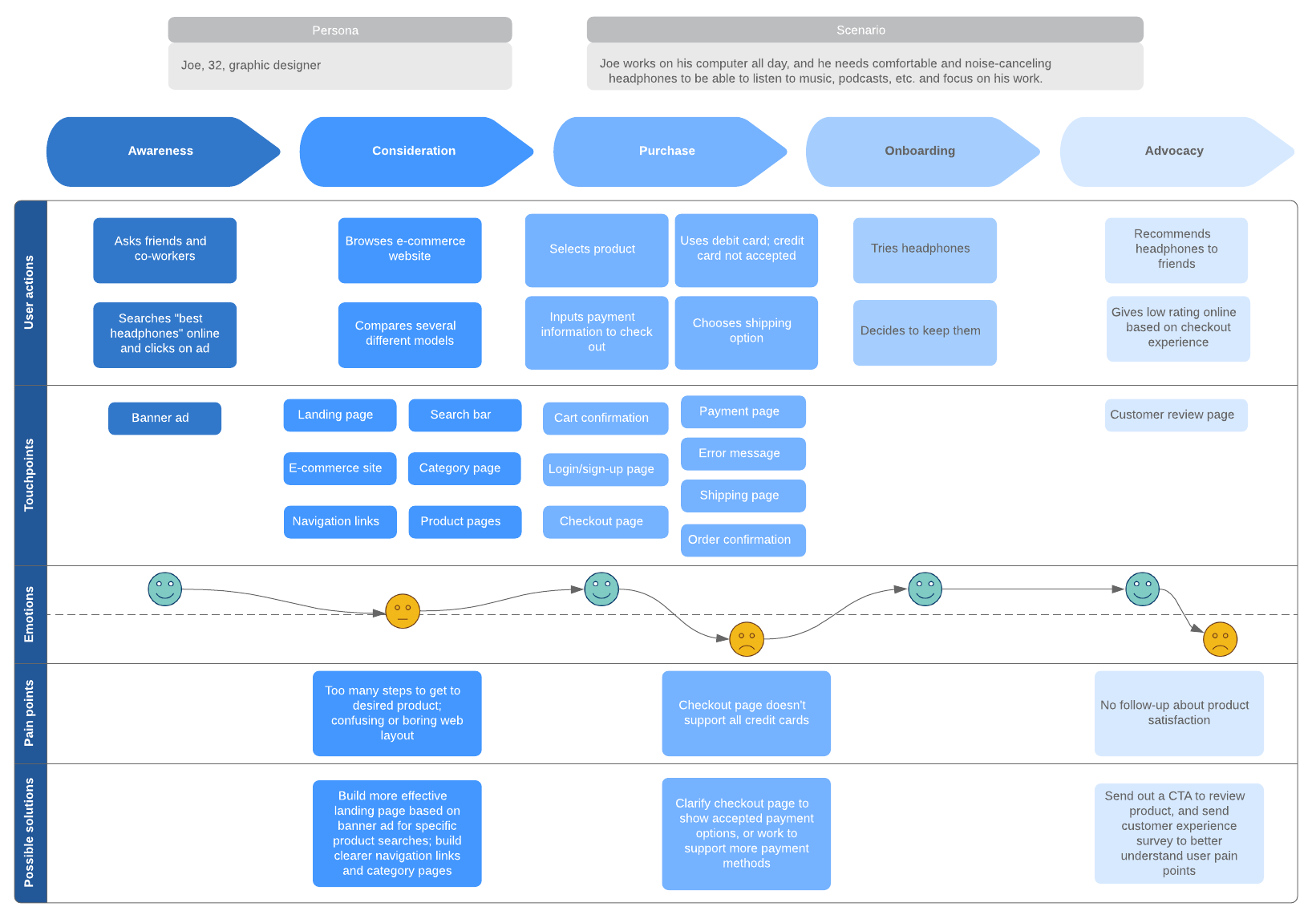
A customer journey map is a diagram that shows the process your customers go through in interacting with your business, such as an experience on the website, a brick and mortar experience, a service, a product, or a mix of those things.
What is a customer journey map?
A customer journey map is a visual representation of a customer’s experience with your brand. These visuals tell a story about how a customer moves through each phase of interaction and experiences each phase. Your customer journey map should include touchpoints and moments of truth, but also potential customer feelings, such as frustration or confusion, and any actions you want the customer to take.
Customer journey maps are often based on a timeline of events, such as a customer’s first visit on your website and the way they progress towards their first in-product experience, then purchase, onboarding emails, cancellation, etc.
Your customer journey maps may need to be tailored to your business or product, but the best way to identify and refine these phases is to actually talk to your customers. Research your target audiences to understand how they make decisions, decide to purchase, etc. Without an essential understanding of your customers and their needs, a customer map will not lead you to success. But, a well-constructed and researched customer journey map can give you the insights to drastically improve your business’s customer experience.
The benefits of customer journey mapping
Customer journey mapping is a powerful tool for uncovering insights into your customer experience, driving business goals, and building resilience in a changing market. In a 2022 report, Hanover Research found that 94% of businesses said their customer journey maps help them develop new products and services to match customer needs. Another 91% said their maps drove sales.
But understanding a customer’s journey across your entire organization does so much more than increase your revenue. It enables you to discover how to be consistent when it comes to providing a positive customer experience and retaining customer loyalty.
This was especially evident in recent years as top of improving marketing, customer journey maps emerged as a valuable way to understand evolving buyer behavior. In fact, 1 in 3 businesses used customer journey maps to help them navigate the changing landscape during the pandemic.
When done correctly, customer journey mapping helps to:
- Increase customer engagement through channel optimization.
- Identify and optimize moments of truth in the CX.
- Eliminate ineffective touchpoints.
- Shift from a company to a customer-focused perspective.
- Break down silos between departments and close interdepartmental gaps.
- Target specific customer personas with marketing campaigns relevant to their identity.
- Understand the circumstances that may have produced irregularities in existing quantitative data.
- Assign ownership of various customer touchpoints to increase employee accountability.
- Make it possible to assess the ROI of future UX/CX investments.
Following the process outlined above, customer mapping can put your organization on a new trajectory of success. Yet, according to Hanover Research, only 47% of companies currently have a process in place for mapping customer journeys. Making the investment to map your customer journey and solidify that process as part of your company’s DNA can result in significant advantages in your competitive landscape, making your solution the go-to option that customers love.
Customer journey maps can become complicated unless you keep them focused. Although you may target multiple personas, choose just one persona and one customer scenario to research and visualize at a time. If you aren’t sure what your personas or scenarios might be, gather some colleagues and try an affinity diagram in Lucidchart to generate ideas.
1. Set goals
Without a goal, it will be difficult to determine whether your customer journey map will translate to a tangible impact on your customers and your business. You will likely need to identify existing—and future—buyers so you can set goals specifically for those audiences at each stage of their experience.
Consider gathering the key stakeholders within your company—many of whom likely touch different points of the customer experience. To set a logical and attainable goal, cross-functional teamwork is essential. Gather unique perspectives and insights about each part of the existing customer journey and where improvements are needed, and how those improvements will be measured.
Pro Tip : If you don’t already have them in place, create buyer personas to help you focus your customer journey map on the specific types of buyers you’re optimizing for.
2. Conduct persona research
Flesh out as much information as possible about the persona your customer journey map is based on. Depending on the maturity of your business, you may only have a handful of records, reports, or other pre-existing data about the target persona. You can compile your preliminary findings to draft what you think the customer journey may look like. However, the most insightful data you can collect is from real customers or prospective customers—those who have actually interacted with your brand. Gather meaningful customer data in any of the following ways:
- Conduct interviews.
- Talk to employees who regularly interact with customers.
- Email a survey to existing users.
- Scour customer support and complaint logs.
- Pull clips from recorded call center conversations.
- Monitor discussions about your company that occur on social media.
- Leverage web analytics.
- Gather Net Promoter Score (NPS) data.
Look for information that references:
- How customers initially found your brand
- When/if customers purchase or cancel
- How easy or difficult they found your website to use
- What problems your brand did or didn’t solve
Collecting both qualitative and quantitative information throughout your research process ensures your business makes data-driven decisions based on the voice of real customers. To assist when conducting persona research, use one of our user persona templates .

Discover more ways to understand the Voice of the Customer
3. Define customer touchpoints
Customer touchpoints make up the majority of your customer journey map. They are how and where customers interact with and experience your brand. As you research and plot your touchpoints, be sure to include information addressing elements of action, emotion, and potential challenges.
The number and type of touchpoints on your customer journey map will depend on the type of business. For example, a customer’s journey with a SaaS company will be inherently different than that of a coffee shop experience. Simply choose the touchpoints which accurately reflect a customer’s journey with your brand.
After you define your touchpoints, you can then start arranging them on your customer journey map.
4. Map the current state
Create what you believe is your as-is state of the customer journey, the current customer experience. Use a visual workspace like Lucidchart, and start organizing your data and touchpoints. Prioritize the right content over aesthetics. Invite input from the stakeholders and build your customer journey map collaboratively to ensure accuracy.
Again, there is no “correct” way to format your customer journey map, but for each phase along the journey timeline, include the touchpoints, actions, channels, and assigned ownership of a touchpoint (sales, customer service, marketing, etc.). Then, customize your diagram design with images, color, and shape variation to better visualize the different actions, emotions, transitions, etc. at a glance.
Mapping your current state will also help you start to identify gaps or red flags in the experience. Collaborators can comment directly on different parts of your diagram in Lucidchart, so it’s clear exactly where there’s room for improvement.
5. Map future states
Now that you’ve visualized the current state of the customer journey, your map will probably show some gaps in your CX, information overlap, poor transitions between stages, and significant pain points or obstacles for customers.
Use hotspots and layers in Lucidchart to easily map out potential solutions and quickly compare the current state of the customer journey with the ideal future state. Present your findings company-wide to bring everyone up to speed on the areas that need to be improved, with a clear roadmap for expected change and how their roles will play a part in improving the customer journey.
Customer journey map templates
You have all the right information for a customer journey map, but it can be difficult to know exactly how to start arranging the information in a digestible, visually appealing way. These customer journey mapping examples can help you get started and gain some inspiration about what—and how much—to include and where.
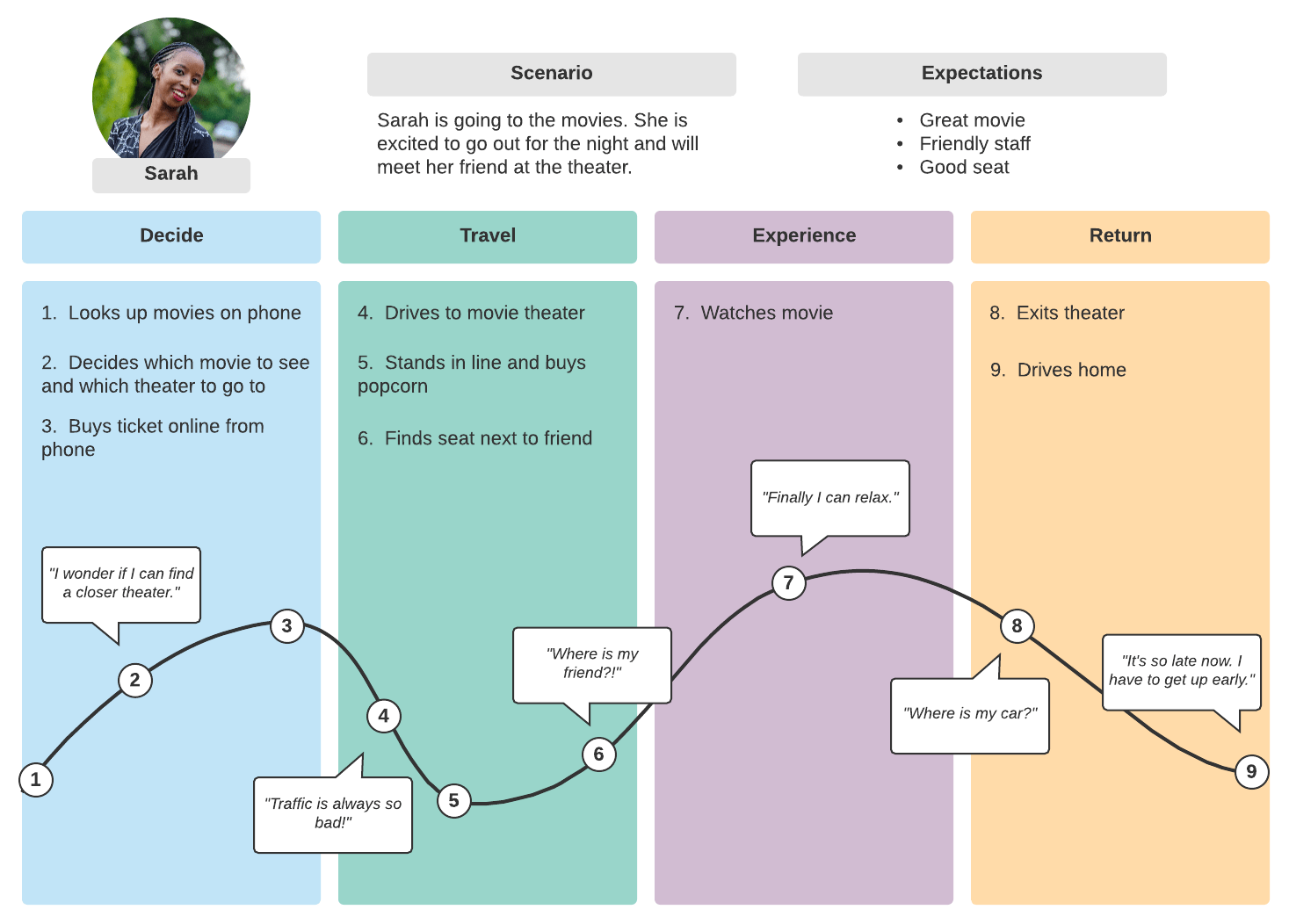
Don’t let the possibility of a bad customer journey keep you up at night. Know the current state of the customer journey with you business, and make the changes you need to attract and keep customers happy.
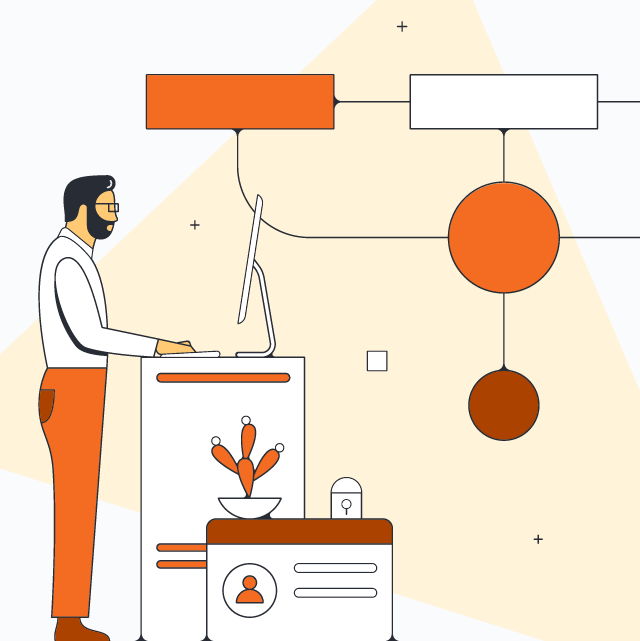
Customer journey mapping is easy with Lucidchart.
About Lucidchart
Lucidchart, a cloud-based intelligent diagramming application, is a core component of Lucid Software's Visual Collaboration Suite. This intuitive, cloud-based solution empowers teams to collaborate in real-time to build flowcharts, mockups, UML diagrams, customer journey maps, and more. Lucidchart propels teams forward to build the future faster. Lucid is proud to serve top businesses around the world, including customers such as Google, GE, and NBC Universal, and 99% of the Fortune 500. Lucid partners with industry leaders, including Google, Atlassian, and Microsoft. Since its founding, Lucid has received numerous awards for its products, business, and workplace culture. For more information, visit lucidchart.com.
Bring your bright ideas to life.
or continue with
By registering, you agree to our Terms of Service and you acknowledge that you have read and understand our Privacy Policy .
Are you an agency specialized in UX, digital marketing, or growth? Join our Partner Program
Learn / Guides / Customer journey mapping (CJM) guide
Back to guides
The definitive 8-step customer journey mapping process
In business, as in life, it's the customer's journey that makes the company's destination worth all the trouble. No customer wants to jump through several different hoops to get to your product: they want it fast and they want it now.
Following certain customer journey mapping stages helps you improve your user's experience (UX) to create a product they love interacting with, ensures you stay ahead of key workflow tasks, and keeps stakeholders aligned. But a misaligned map can derail your plans—leading to dissatisfied users who don’t stick around long enough to convert or become loyal customers.
Last updated
Reading time.

This article walks you through the eight key stages of great customer journey mapping, and shows you how to adapt each to your unique business and product to optimize the customer experience from start to finish.
Learn how customers interact with your product and website
Hotjar's Observe and Ask tools let you go ‘behind the scenes’ to understand your users’ product experiences and improve their customer journey.
An 8-step process for effective customer journey mapping
A customer journey map is a visualization of every point of interaction a user has with your company and product.
Mapping out the customer journey gives you insights into your buyers’ behavior to help you make changes that improve your website and the user flow between touchpoints. This helps you increase online sales and turn users into loyal customers and brand advocates.
Follow these eight proven steps to understand—and enhance—the customer experience.
Note: every business is distinct, so be sure to adapt these steps to your particular user and business needs.
1. Define your purpose
The first step to creating a successful customer journey map is to define your product's vision or purpose. Without a clear purpose, your actions will be misguided and you won’t know what you want users to achieve during their journey on your website, product page, or web app.
To define your purpose, consider your company’s mission statement and incorporate your specific user pain points as much as possible.
Make your purpose specific to your company’s needs and goals—for example, the purpose of an ecommerce brand looking to help users navigate several different products and make multiple purchases will differ from that of a SaaS company selling subscriptions for one core product.
2. Make sure your team is aligned and roles are clear
Cross-functional collaboration is essential when mapping out your brand's or product’s user journey. Get insights from different teams within your organization to find out exactly how users engage with key touchpoints to derive a holistic sense of the user experience (UX), which will help you improve every aspect of the customer experience.
Lisa Schuck , marketing lead at Airship , emphasizes the importance of keeping “anybody that has a touchpoint with a customer” involved. She advises teams to “figure out how to align your external marketing and sales with your internal operations and service.”
Although sales, product, and marketing departments are often the key players in customer journey mapping, also involve your operations and design teams that are responsible for creating the user flow.
If you have a SaaS company, for example, marketing creatives, sales teams, product owners and designers, and your customer experience department all need to participate in the process. Clearly define who’s responsible for different aspects of the map, and regularly check in to make sure your final map isn’t missing any important perspectives.
Pro tip: use Hotjar's Highlights feature to collect and organize key product experience (PX) insights and data on user behavior from teams across your organization to help you build your customer journey map. Then use Hotjar’s Slack integration to quickly share learnings with your relevant stakeholders to get buy-in and ensure everyone is aligned.
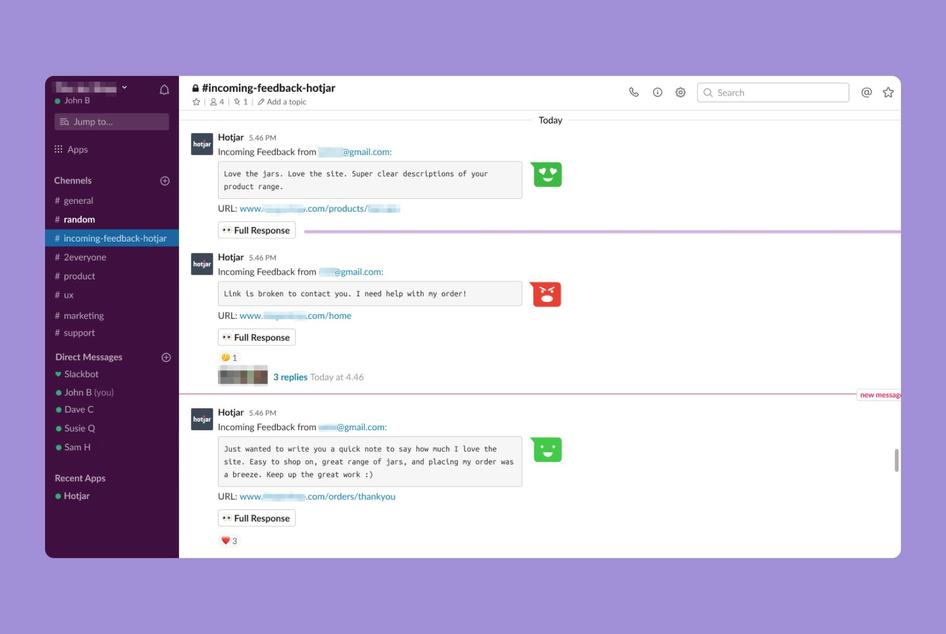
Hotjar’s Slack integration Slack lets teams discuss insights in the moment, so they’re up to date with critical issues
3. Create user personas
Once you’ve defined your purpose and involved all relevant stakeholders, it’s time to design your user personas . Use resources like UXPressia and HubSpot’s Make My Persona tool to help you design various product personas .
Create a range of user personas to understand what each type of buyer needs to curate a journey that’s easy and enjoyable for every customer. This is an important early step in the customer journey mapping process—because if you don’t understand your users, you won’t be able to fully comprehend how they interact with your brand to better it.
Create user personas for all your product’s possible buyers—for example, to map out a B2B customer journey for a company in the hospitality business means developing personas for a range of different customers, from large chain hotel managers to small vacation rental owners.
4. Understand your user goals
Once you’ve designed your user personas, it’s time to define their jobs to be done . What do your users hope to accomplish when they search for your product or service? What do they want to do when they click on your website? Address and answer these questions to build a deep understanding of your users’ goals and pain points to inform your customer journey.
In a SaaS customer journey , perhaps users are looking for helpful comparisons of product features on your website, or want to easily sign up for a trial account in the hopes that your product will solve their problems. But you won’t know until you ask .
Once you have users or test users, get direct insights from them with Hotjar's Feedback tools and Surveys to ask buyers exactly what their goals are as they browse different pages of your website or interact with product features.
Since user goals are at the center of your customer journey map, define them early on—but keep speaking to your users throughout the entire process to make sure you’re up to date with their needs.
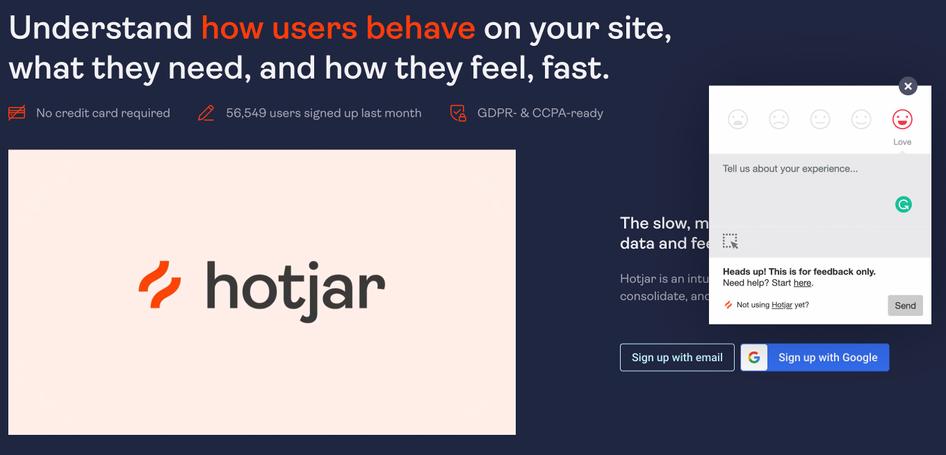
5. Identify customer touchpoints
After you understand your users and what their goals are, it’s time to identify the ways they interact with your company and your product.
"Touchpoints are the moments the customer interacts with your brand, be it through social media channels, your product, or customer support. The quality of these experiences affects the overall customer experience, which is why it’s important to be aware of them. Consider what happens before, during, and after a customer makes a purchase or uses your product."
Key customer journey touchpoints for a website or product include your homepage, landing pages, product pages, CTA buttons, sign-up forms, social media accounts, and paid ads.
Collaboration is key to identifying touchpoints throughout the entire customer journey. Include insights from different teams and stakeholders —your marketing and sales teams will have a strong understanding of the touchpoints involved pre-purchase, while the customer experience department can shed light on post-purchase touchpoints.
Post-purchase touchpoints can help turn users into loyal customers and even advocates for your brand.
In the words of Lisa Schuck, "When you create a raving fan, or a brand advocate, who goes out and tells the world how wonderful you are, you get social credibility and validity. It’s becoming more and more important to have advocates."
Pro tip : speak with your users regularly to get direct voice-of-the-customer (VoC) insights on what they love and what frustrates them on their journey. Place Hotjar Feedback widgets and Surveys at key website touchpoints like your homepage and landing pages to get valuable user insights on what you can improve. Use Hotjar’s survey templates to get inspiration for your survey questions.
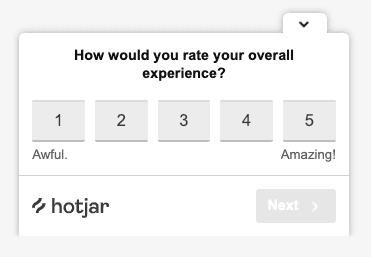
An example of an on-site Hotjar Survey
6. Map out the customer journey
Once your user and product research are complete and all roles are distributed, it’s time to map out the full customer journey.
First, map out an overarching customer journey by putting your key touchpoints in order and identifying how your various user personas interact with them. Then, home in on the details, looking at how customers engage with specific aspects of your website, product, or social media accounts.
Breaking down the mapping process into smaller phases will ensure you don’t miss any key interactions.
Here’s how an ecommerce brand could lay out general touchpoints, then narrow each down into more specific actions:
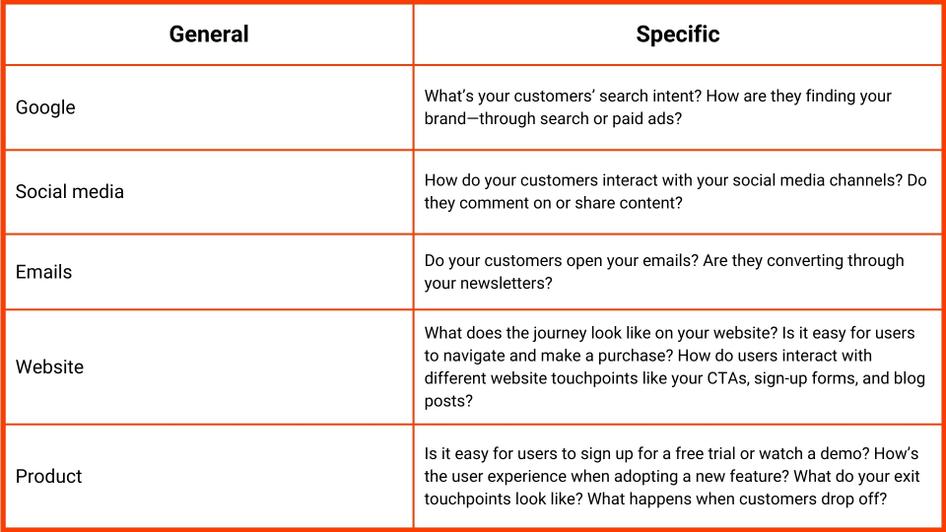
Pro tip : it’s helpful to think of the user journey in terms of different functions when mapping it out, like:
Connect: how are buyers connecting with your brand?
Attract: how are you convincing them to convert?
Serve: how are you serving customers when they want to purchase?
Retain: how are you promoting brand advocacy and customer retention ?
7. Test the customer journey
Once you’ve mapped out the customer journey, it’s time to take it for a spin. You can’t understand how your users move through customer touchpoints unless you test out the user flow yourself.
Start with an informational Google search, then visit your website, check out your social media pages, and simulate the purchase process. This will help you get a better sense of how users interact with each touchpoint and how easy it is to move between them.
Be sure to try out the journey from the standpoint of every relevant user persona. For an enterprise software company, this could mean looking at how decision-makers move through the user flow vs. the employees who’ll use your software day to day.
By walking through the customer journey yourself, you can identify issues and difficulties that users may have to address them proactively.
Try out the user flow with test users to get a realistic perspective of the user experience. Be sure to use focus groups that represent every one of your user personas.
8. Use continuous research to refine your map
Continuously map out, analyze, and evaluate the customer journey by observing users and getting their feedback. Hotjar Heatmaps and Recordings help you understand how your users are experiencing the customer journey on your website: create heatmaps to see whether users are clicking on CTAs or key buttons, and watch recordings to find out how they navigate once they reach your homepage.
Then, use Google Analytics to get an overview of your website traffic and understand how customers from different channels move through the user journey.
Finally, once you have these combined user insights, use them to make changes on your website and create a user journey that is more intuitive and enjoyable.
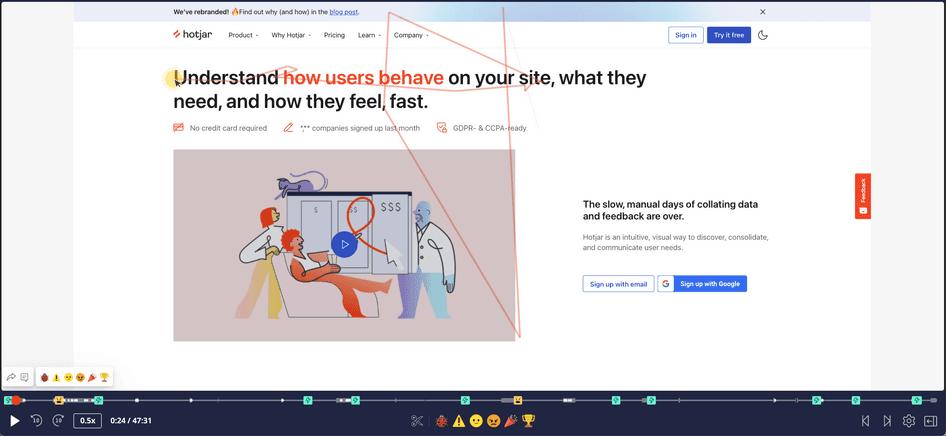
Pitfalls to avoid during the customer journey mapping stages
Jamie Irwin , director & search marketing expert at Straight Up Search , says companies should avoid these three common mistakes when mapping out the customer journey:
Don't map out the entire customer journey at once
Don't forget about the ‘hidden journeys’
Don't make assumptions about customer behavior
To sidestep these common pitfalls:
Start by mapping out the overall journey, and only drill down into more detail once you have a broader, higher-level overview of the customer journey
Factor in every way that customers interact with your brand, even the ones you don’t have as much visibility on, like ‘dark social’ communications about your brand shared in private channels. Talk to your users to find out what they’ve heard about your brand outside of public channels , and use sticky share buttons to keep track of when your content’s shared through email or social media messengers.
Take a data-informed approach: don’t assume you already know your users —test out your hypotheses with real users and qualitative and quantitative data.
Follow proven steps to successfully map out the customer journey
Take the time to understand your business goals and users, involve the right teams, and test frequently to consistently improve your customer journey and make the decisions that will help you map out an experience that will get you happy and loyal customers.
FAQs about customer journey mapping stages
What is the purpose of customer journey mapping.
Customer journey mapping helps you visualize how users interact with your business and product, from the moment they find it until long after they make their first purchase.
The purpose of customer journey mapping is to gain insights into the buyer's journey to create a more enjoyable, streamlined, and intuitive experience for your customers.
What are the benefits of following a customer journey mapping process?
The main benefits of a customer journey mapping process are: :
Building on tried-and-tested processes
Not missing any key steps
Considering all buyer personas
Keeping all relevant stakeholders involved
Creating a valuable customer journey map
Improving user experience
What happens if you don’t follow key steps in customer journey mapping?
If you don’t follow key steps when mapping out the customer journey, your map likely won’t give you the insights you need to enhance the experience users have with your most important touchpoints —like your homepage, landing pages, CTAs, and product pages.
This can result in high bounce rates, low conversion, and unsatisfied users who fail to become loyal customers.
CJM benefits
Previous chapter
CJM touchpoints
Next chapter
- Product overview
- All features
- Latest feature release
- App integrations
- project icon Project management
- Project views
- Custom fields
- Status updates
- goal icon Goals and reporting
- Reporting dashboards
- asana-intelligence icon Asana AI
- workflow icon Workflows and automation
- portfolio icon Resource management
- Capacity planning
- Time tracking
- my-task icon Admin and security
- Admin console
- Permissions
- list icon Personal
- premium icon Starter
- briefcase icon Advanced
- Goal management
- Organizational planning
- Project intake
- Resource planning
- Product launches
- View all uses arrow-right icon

- Work management resources Discover best practices, watch webinars, get insights
- Customer stories See how the world's best organizations drive work innovation with Asana
- Help Center Get lots of tips, tricks, and advice to get the most from Asana
- Asana Academy Sign up for interactive courses and webinars to learn Asana
- Developers Learn more about building apps on the Asana platform
- Community programs Connect with and learn from Asana customers around the world
- Events Find out about upcoming events near you
- Partners Learn more about our partner programs
- Asana for nonprofits Get more information on our nonprofit discount program, and apply.
- Project plans
- Team goals & objectives
- Team continuity
- Meeting agenda
- View all templates arrow-right icon
- Business strategy |
- Customer journey map: How to visualize ...
Customer journey map: How to visualize the buyer experience
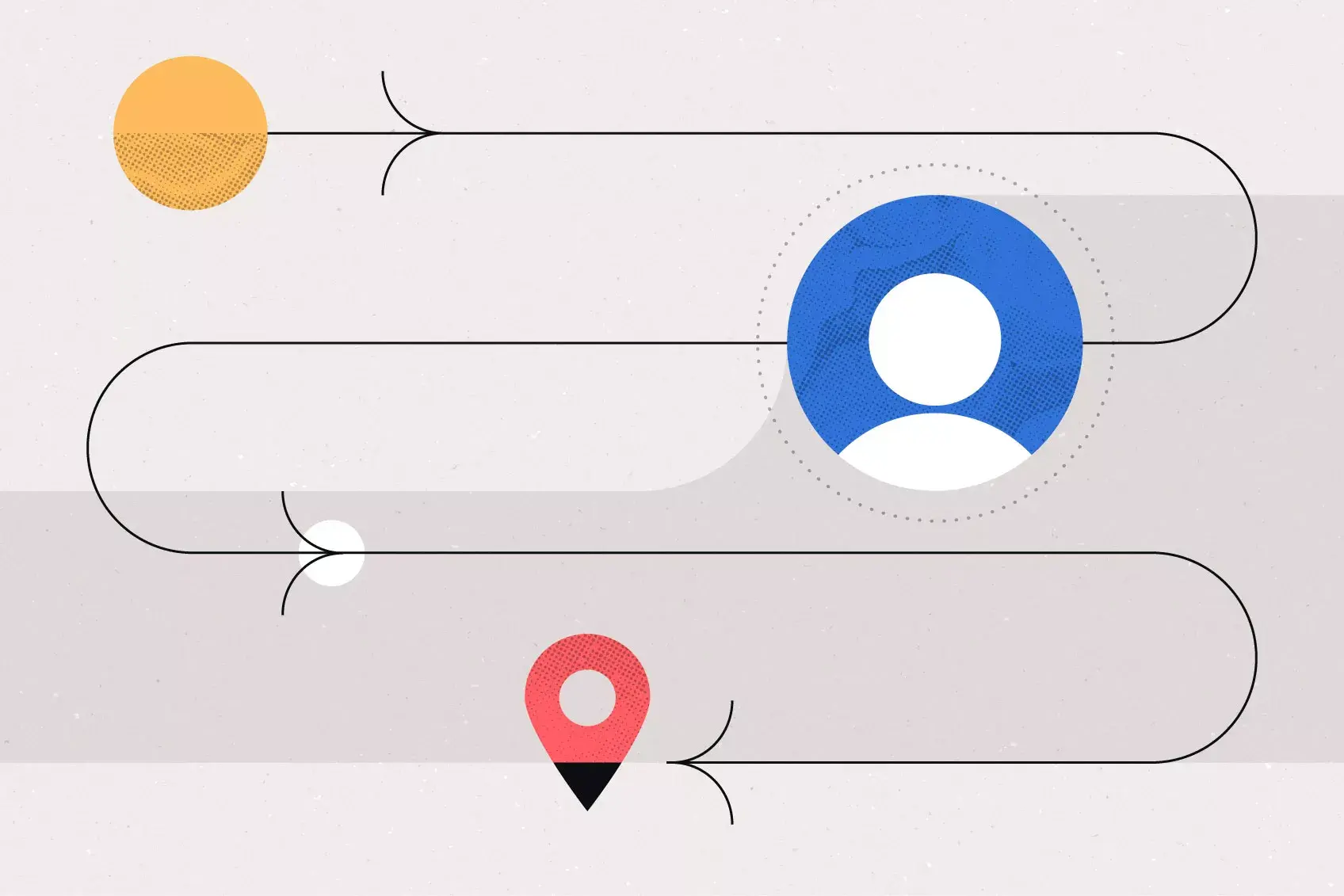
El customer journey o recorrido del cliente es el camino que realiza el cliente desde que tiene una necesidad hasta que compra el producto o servicio. Mientras que el customer journey map es una representación visual de este viaje del consumidor. Sigue leyendo y aprende cómo crear un customer journey y utilizar un customer journey map.
If you skip to the end of a book, you’ll know where every character ends up. But without reading the middle, you won’t understand what took place. A story can’t occur with just a beginning and end—you need the journey between. The buying process is like a story. Analytics show you where each customer ends up, but to understand why they got there, you must examine the buyer journey.
A customer journey map helps you visualize a customer’s experience from point A—their pain points—to point B—their purchasing decision. When you know what leads people to one decision versus another, you can tailor your business strategy accordingly.
What is a customer journey map?
A customer journey map is a tool that helps you track a customer’s behavior through the buying process. The map includes the customer’s thoughts and feelings about their problem, as well as the corresponding actions they take.
Simply put, customer journey maps help you:
1. Identify and understand which customers are interested in your product or service.
2. Tailor your messaging so customers understand the benefits of your product or service.
What are the 6 components of a customer journey?
A customer journey map has six components that—when observed together—give you a clear picture of why a customer behaves the way they do. While these components are all relevant to a customer journey map, they don't necessarily happen in order.
![customer journey map persona [inline illustration] Elements of a customer journey map (infographic)](https://assets.asana.biz/transform/5d18facd-674a-498c-a8b3-33155ed4abda/inline-business-strategy-customer-journey-map-1-2x?io=transform:fill,width:2560&format=webp)
The buying process: Start by outlining what you know about your customer’s buying process. How do they move from awareness to interest to eventual purchase?
Customer actions: Customer actions focus on the specific actions your customers take. This can include actions like reading an article, downloading an ebook, or requesting a sales demo.
Customer touchpoints: Different from user actions, touchpoints are company-focused. What does your company do to engage with your customers? These may include posting an ad on social media or distributing an email newsletter.
Emotions: For every action your customer takes, they’ll have a specific thought or feeling tied to that decision. Knowing these emotions provides the “why” for customer behavior.
Pain points: Pain points drive a customer to purchase your product. They either have a problem to solve or want to fill a need in their life.
Expectations: Customers looking to fix their pain points will have certain expectations for what they’re seeking. This is how they narrow down their product search.
When you analyze customer actions, make sure you’re taking all six elements into account. For example, emotions happen throughout the entire process, whereas pain points and expectations typically influence the buying process.
How do you map a customer journey?
You’ll map the customer journey by working through each action your customer takes and assigning emotions to accompany them. Marketing and sales teams often use customer journey maps to assess their current strategies and improve them. You can also use customer journey maps when developing new marketing or sales campaigns. That way, your customer stays front of mind.
![customer journey map persona [inline illustration] How to build a customer journey map (infographic)](https://assets.asana.biz/transform/10aedb47-2155-4763-9849-a93f7e7af88d/inline-business-strategy-customer-journey-map-2-2x?io=transform:fill,width:2560&format=webp)
Use the steps below to build a customer journey map. Consider the different stages of the user experience, from their first interaction with your company to their last.
1. Set your map objectives
Any time you begin a new project or build a new tool, you’ll need to set objectives . When you know what you want to accomplish with your map, you can move through the development process with clarity. Your customer journey map objectives may include:
Determining why customers abandon their carts
Understanding what makes a customer commit to a purchase
Identifying areas where you can influence the customer journey
When setting objectives, pull together a cross-functional team to provide insight. Make sure to ask individuals on the sales, customer support, and marketing teams about how they perceive customer behavior. By incorporating everyone’s viewpoints, you can round out your goals and achieve greater success.
2. Create buyer personas
Buyer personas—also called customer personas—are fictional customers that represent your target audience . The persona profiles who the customer is, what they like and dislike, and their general motivations or frustrations. By looking at a buyer persona, you’ll have the information you need to tell your customer’s story.
Target market: Women
Target audience: Mothers
Buyer persona: Daniela Vargas, 32, married with one child.
![customer journey map persona [inline illustration] Buyer persona (example)](https://assets.asana.biz/transform/3962ac6b-6a0f-4923-9c8e-bd37e32bf007/inline-business-strategy-customer-journey-map-3-2x?io=transform:fill,width:2560&format=webp)
The target market for your product may be women, but if you serve all women, you’ll still have various audiences. By building out a fictional persona, your team can more easily empathize with your potential customer and create messaging that’s relevant to them.
Your marketing and sales teams likely have multiple buyer personas—one for each type of person who buys your good or service. After all, people have unique buying experiences depending on who they are. Therefore, you’ll need a unique journey map for every persona.
3. Label customer actions and touchpoints
Customer actions focus on every action the customer takes, while touchpoints are the vehicle for those actions. Touchpoints can include interactions before a customer finds your website or once they’re on your website. Use analytics from past customers to assess how the buyer from your target audience might interact with you online.
Customer touchpoints outside of your website:
Social media posts
Email newsletters
Customer actions outside of your website:
Searches for your website on Google.
Navigates to your website from a paid ad on Google.
Clicks your website link from a social media post.
Navigates to your website from an email.
Opens your email but doesn’t take action.
Likes your social media ad but doesn’t go to your website.
Customer touchpoints on your website:
Website landing pages
Customer actions on your website:
Puts items in their shopping cart.
Stays on a page for a specific period of time.
Clicks an ad on your website.
Leaves your website.
Abandons their shopping cart.
Completes a purchase.
Make a timeline of these touchpoints to use as the foundation of your buyer’s story. With this visual representation, write down each customer action associated with the touchpoints.
4. Map the customer journey
You should now have a timeline of how your customer got from their awareness of your product to their final action—whether they decided to purchase or something else. Divide the timeline into stages based on the buyer’s journey.
Stages of the buying process
Awareness: The customer realizes they have a problem that needs solving and determines that your product or service may be the solution.
Consideration: The customer considers whether to buy your product or service.
Comparison: The customer may compare your product to others on the market.
Decision: The customer decides that your product is best.
Purchase: The customer buys your product or service.
Retention: The customer likes your product or service and returns for another purchase.
Advocacy: The customer likes your product or service so much that they recommend you to others.
Your first three touchpoints may fall into the awareness stage, while the next two may move into the consideration stage. Not every customer will move through these stages seamlessly, but these transitions can show you where to improve.
Fill in the story
To complete your journey map, write a step-by-step storyline to fill in the gaps between your touchpoints. Since you know the background of your persona, use what you know to explore what they were thinking when they initially searched for your product. If the customer abandons their cart, consider how they went from being interested to jumping ship.
Add customer emotions
Your customer will have unique thoughts to accompany every action or situation of their journey. Put yourself in the customer’s shoes and try to understand how they feel. Emotions are hard to determine, but with support from your buyer persona, their touchpoints, and your storyline, you can make confident assumptions.
5. Evaluate your marketing strategy
Your completed customer journey map will show you turning points where a customer hesitated to buy your product or abandoned it altogether. For example, a customer that goes to your website but bounces quickly has made it to the awareness stage but may not move into the consideration stage.
Assess what customers need to move between these stages and adjust your marketing strategy accordingly. In this scenario, ask the following questions:
How long did they stay on our website?
Did they move past the homepage? If not, why not?
What are the weaknesses in our homepage?
How could we improve our homepage to engage customers?
If a customer bounces from your website after viewing the homepage, then the first impression you’re giving them may not be strong enough. It’s possible that your homepage design isn’t intuitive or your content doesn’t stand out. By examining the turning points in your map, you can find ways to make the next customer’s journey more linear.
Customer journey map example
In this customer journey map example, Sally’s pain points are that she struggles to stay organized at work. As Sally makes her journey from problem to solution, there are various touchpoints that guide her. For example, she decides task management is a good solution because she’s heard success stories from friends. She then sees a social media ad for a project management software company that influences her to consider the company’s brand. Sally’s emotions throughout the buying process explain how she processed each step.
![customer journey map persona [inline illustration] Customer journey map (example)](https://assets.asana.biz/transform/e572c811-f216-40b3-907c-67a78e8c862b/inline-business-strategy-customer-journey-map-4-2x?io=transform:fill,width:2560&format=webp)
Company: Project management software company
Scenario: Sally needs a task management solution to get organized and improve her work performance.
Expectations: Easy-to-use tool, holds her accountable at work, affordable solution
1. Realizes she has an organization problem at work
2. Determines task management can solve the problem
Touchpoint: Word of mouth, radio/TV/print
Corresponding emotion: “I need to solve this problem.”
Consideration
3. Sees social media ad for task management software
Touchpoint: Online ads
Corresponding emotion: “This product looks interesting”
Comparison:
4. Compares software to others on the market
5. Reads user reviews of software
Touchpoint: SEO, blog
Corresponding emotion: “What tool best fits my needs?”
6. Decides your product is worth trying
Touchpoint: Customer reviews
Corresponding emotion: “Did other users like this product?”
7. Goes to software website and signs up for trial offer
Touchpoint: Blog, website
Corresponding emotion: “This looks like the best option, I’ll try it."
Retention/Advocacy
8. Purchases software once trial period is complete
9. Recommends software to coworkers
Touchpoint: Email, website, word of mouth
Corresponding emotion: “This tool is worth the investment. I should tell my team.”
What are the benefits of customer journey mapping?
Customer journey mapping is beneficial because it gives you a new perspective on how customers act, think, and feel when interacting with your brand. Other benefits include:
Inform your customer service: When you can see your customer pain points clearly, you can use them to better support customers and improve their experience.
Eliminate ineffective touchpoints: The customer journey map will show you which touchpoints aren’t working. If a customer interacts with your brand but doesn’t move forward in the buying process, then you may need to adjust that touchpoint.
Focus strategy on specific personas: The customer journey map helps you find a strategy that works best for one group. When you create a map for each target audience, you can customize your strategies for each one.
Increase understanding of customer behavior: Understanding your audience is crucial to selling products or services. The journey map shows you how customers behave and gives you insight into why they behave that way.
You can make maps for the current state of your customers or a predicted future state. Both types of customer journey maps can help you learn the customer’s perspectives.
Use a customer journey map to better understand your audience
Your maps can serve as a resource for marketing and sales teams. Once you create one, store it in an accessible place so others can reference it. When you keep your map digital, you can also change it as your audience changes.
Work management software provides a central source of truth for your team and stakeholders. Whether you’re sharing your customer journey map or putting your improvements into action, Asana will keep your team on the same page.
Related resources

Everything you need to know about requirements management
How to streamline compliance management software with Asana

15 creative elevator pitch examples for every scenario

How Asana streamlines strategic planning with work management

How to Create a Customer Journey Map with Templates and Examples

Using data gathered from feedback surveys , online reviews, and other customer satisfaction metrics , a customer journey map is used to tell the story of a customer’s lifetime relationship with a company. Depending on the customer persona, this relationship can be as short as a few minutes or as long as many years. Customer journey maps are useful tools for visualizing the quality of each interaction and the customer’s reaction to that touchpoint as they move up the brand equity pyramid .
You can download our customer journey map template, or continue reading to learn more about creating your own.
Table of Contents:
Customer Journey Map: Understanding the Basics
- How to Create a Customer Journey Map in 7 Steps:
- Determine Target Personas
- Define Your Customer Touchpoints, Actions, and Reactions
- Break Out Touchpoints and Actions Into Phases
- Test the Customer Journey Map
- Complete the Customer Journey Map with Persona Data
- Identify Areas of Improvement
- Create a Corresponding “Business Actions” Map
Customer Journey Map Examples
- Customer Journey Map Downloadable Template
Before we dive into creating your own customer journey map, it’s important to cover the basic ideas behind these types of visualizations and why they’re helpful for businesses.
How Journey Map Tracking Helps Businesses Understand Customers
As we briefly mentioned earlier, customer journey maps are tools that help you visualize the specific steps customers go through when interacting with your business. Using buyer personas (a semi-fictional representation of a type of customer based on market research and real customer data, as defined by Hubspot ) you can track the path different customers take on the road to conversion and pinpoint failed or successful interactions. This ultimately helps you do things like:
- Allocate advertising budgets to channels that produce the most positive responses
- Collaborate across teams to improve touchpoints that continuously produce a negative reaction
- Retain and satisfy existing customers by improving previous customers’ churn points
What Are Customer “Touchpoints”?

Customer touchpoints are any interaction someone has with your brand. These could be awareness-based touchpoints, where a potential customer learns about your company for the first time through things like:
- Social media ads
- Reading an online review
- Finding your site through organic search
Or, touchpoints can be more direct interactions such as:
- Clicking a product and reading the description
- Adding a product to their shopping cart
- Making a call to your customer service center
- Signing up for an email newsletter
Depending on the structure of your business, your customer journey map can cover just the main customer touchpoints on your buyer journey, or it can encompass any small interaction that can occur as well. Your ability to create a broad or detailed customer journey map will also depend on the customer data available to you.
How to Create a Customer Journey Map in 7 Steps
Though there are many customer journey map templates available online (including ours at the end of this article) it’s still good to understand the fundamental ideas behind how these maps are created so you can learn to customize each to suit your needs.
Step 1: Determine Target Personas

Each customer journey map is meant to demonstrate just one segment of your customer base, so it should be built specifically for each persona. Many businesses already have personas built for other purposes such as targeted ad campaigns, but if you haven’t, they aren’t too hard to construct. Utilizing your existing user data, create mock customers based on factors like:
- Demographic data (age, gender, location, etc.)
- How they first learned about your company
- Their budget
- What their goals are when purchasing from you
- What’s most important to them when buying
- Pain points that your company either does or could address
Then, decide which persona you’re going to target for this iteration of your customer journey map. For example, you could focus on the “tech-forward business executive” or the “Millennial startup owner,” whichever customer type you want to learn more about and improve the customer experience for.
Step 2: Define Your Customer Touchpoints, Actions, and Reactions
Once you’ve decided on your target persona, the next step is to define the customer touchpoints you want to track. As we talked about earlier, customer journey maps can be used to paint a broad picture of the buyer journey or track every little interaction possible. It’s up to you to determine what the most useful route will be for your project and where you want to focus your efforts.
It can be helpful at this step to list out every touchpoint you can think of, and then narrow down as needed. You’ll likely need to collaborate across teams to make sure you’re covering every type of customer interaction.
When you have your list of touchpoints compiled, it’s then easy to construct a corresponding list of customer actions. For example, if the touchpoint is “reads online review,” then the logical action would be “searches for company/product online.” After that, the next touchpoint would be “homepage/landing page” and the action would be “reads about product details.” You can see how building your customer journey map becomes easier once you get started.
In addition to touchpoints and actions, the third metric you will need to track in your journey map is customer reactions. These can be as basic as “positive and negative,” or be broken down further into numerical scales or other ratings. Customers take each action based on their reaction to the previous touchpoint. For example, a progression could look something like:
Touchpoint: targeted ad, Reaction: positive, Action: clicks ad > Touchpoint: ad landing page, Reaction: neutral, Action: reviews additional competitor options
It’s important to track each of these points concurrently to understand where customer pain points come from.
Step 3: Break Out Touchpoints and Actions Into Phases

Once you have all of your touchpoints, actions, and reactions listed, put them in a logical order that follows the actual buyer journey. At this point, it can be helpful to break out the list into overall phases in order to get a clearer visualization of the process. Again, these phases can be named whatever makes the most sense for your business. If you want to keep things general, you could follow a specific model, for example, the brand equity pyramid, and use the related phases of “brand salience,” “brand meaning,” “brand response,” and “brand resonance.”
It may be more helpful to name your phases something more specific, however, so you could also structure the map into sections labeled “Discovery,” “Exploration,” “Comparison,” “Conversion,” and “Retention” in order to better represent the customer’s thought processes. Though this step is optional, it’s easier to look at a chart that is broken down into larger phases vs a timeline that just details every specific interaction.
Step 4: Test the Customer Journey Map
Now that you’ve established the basic structure of your map via touchpoints grouped into phases, you should have a few different people run through the map to make sure your model is sound. Put yourself into the shoes of your target persona and pretend you are going through each touchpoint as that type of customer. At each point, stop and ask yourself “What would the customer do next?” The point of this exercise is just to ensure that you’re not leaving out any vital steps in the customer journey and that the map follows a logical progression.
Step 5: Complete the Customer Journey Map with Persona Data

Now that you’ve properly set up your customer journey map and tested it for any missing pieces, all that’s left to do is fill in the persona data. From your persona creation process, you should already have a good understanding of each type’s reasons for interacting with your business and what their specific pain points are. Using customer feedback data, abandoned cart data, advertising data, page bounce rate data, and other sources of customer information, you can reconstruct what the typical buyer’s journey looks like for this segment, including their unique actions and reactions at each step.
Step 6: Identify Areas of Improvement
The main purpose of creating customer journey maps is to display your data in a way that’s easier to visualize than numbers in a spreadsheet. If you’ve displayed your persona data accurately, then it should be simple enough to determine where customers are dropping out of the buyer’s journey. Look for places with negative reaction scores, especially scores that lead to customers bouncing from your site, and identify why this is.
At this point in your analysis, it can be helpful to add a new section to your customer journey map called something like “Pain Points,” “Reaction Explanations,” or simply “Why?” In this section, you can add notes or theories about why those negative reactions are occurring. Sometimes figuring out the issue can be a simple matter of walking through the buyer’s journey yourself (perhaps you discover something like an ad pointing to an unrelated landing page) or running additional customer feedback surveys to gather more data about a particular touchpoint.
Step 7: Create a Corresponding “Business Actions” Map

Now that you’ve pinpointed steps on the customer journey that are causing negative reactions, you should be able to identify what your company needs to do to improve these interactions. However, when you aren’t able to determine exactly what is causing these negative reactions, it’s hard to know what to do to fix them. As mentioned, you can always run additional customer feedback surveys to try to shed some light on the issue, but you may be able to discover more immediate fixes by creating a “business actions” map that corresponds to your customer journey map.
While a customer journey map is structured from the customer’s point of view, this reverse map would look at the same touchpoints and actions but from the business’s point of view. For example, if a customer submits a return request, what actions does the returns team take in response? Having each step detailed like this helps you paint a more holistic picture of your business processes to find unexpected areas of customer friction where things may be slipping through the cracks.
Just like customer data in a spreadsheet, there’s only so much you can explain with words on a page. Take a look at the customer journey map examples below to better visualize how these tools can help your business operations.
Hubspot’s simple example helps you understand customer motivations on a basic level, and is most useful for companies without in-depth persona data.

Bright Vessel’s customer journey map is color-coordinated so each department can easily see which touchpoints and actions they are responsible for.

Digital.gov’s example allows for more in-depth customer details, helping you better visualize your personas.

Customer Journey Map Template
Below is a customer journey map template that you can download, edit, and customize to represent your business’s needs.

Customer journey maps are an essential tool for any business looking to learn more about customer pain points on the buyer’s journey. But in order to create these maps, you first need to gather customer data. Chattermill can help you collect, manage, and analyze your customer feedback with our AI-powered software. Contact us to learn more.
Related Articles

How HelloFresh Leverages Customer Insights to Improve Operational Efficiency for Supply Chain Management
We spoke with Stefan Platteau, Associate Director of Global Product Strategy and Analytics, to learn how Chattermill helped HelloFresh optimize its Operations, Logistics, and Supply Chain Management.

How HelloFresh Turned Product Feedback into New Revenue Streams, Growing to a €7B Business
Learn how HelloFresh partnered with Chattermill to make strategic product decisions based on customer feedback, and drive more efficient business growth.

Video Panel: How top brands use AI to impact customer experience
We were joined by more than 35 customers, partners, and friends who wanted to make sure that their choice of AI drives their business outcomes.
See Chattermill in action
Understand the voice of your customers in realtime with Customer Feedback Analytics from Chattermill.
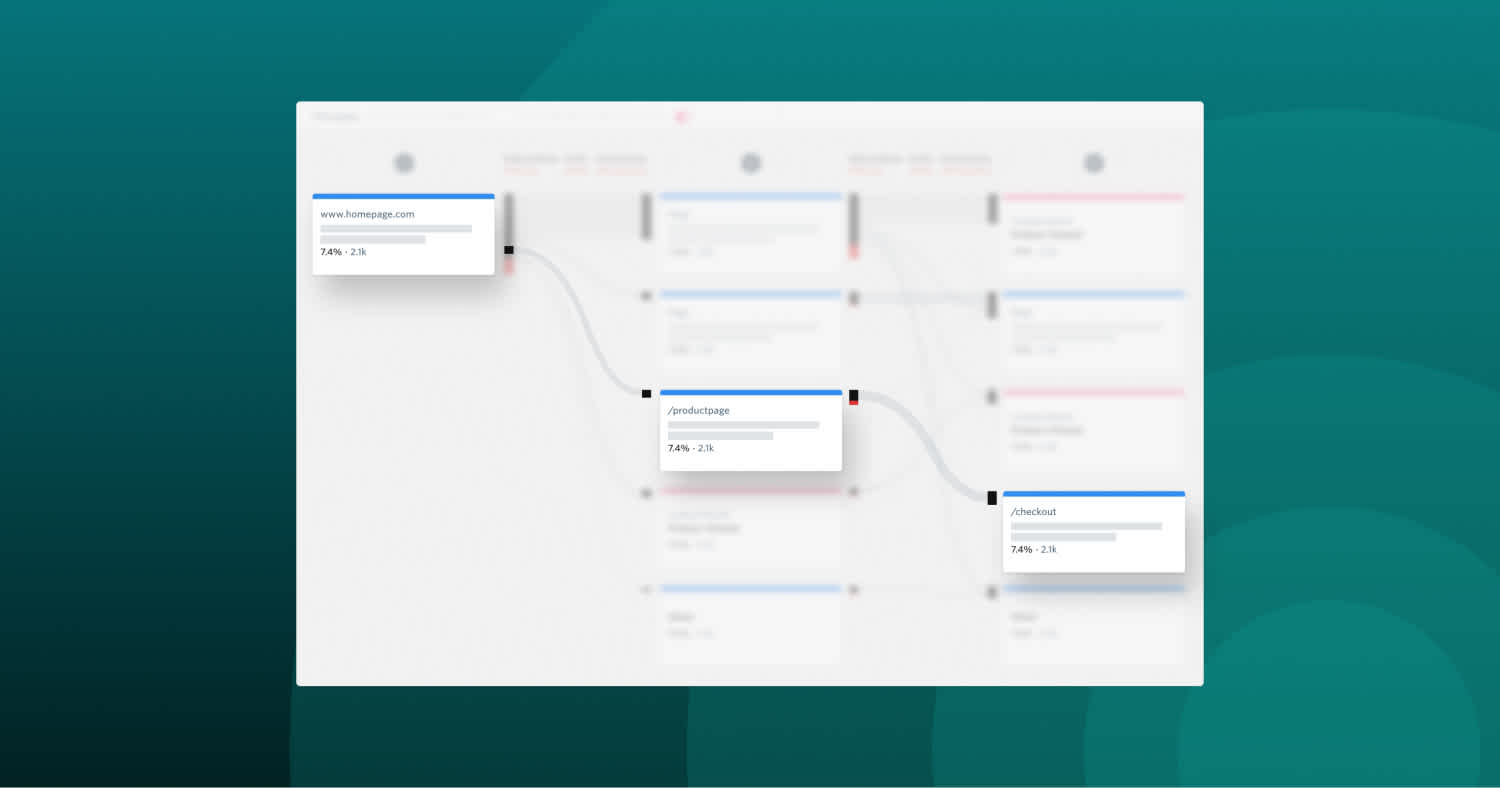
How to understand, use, and build customer journey maps
A customer journey map is key to building a solid marketing strategy. We cover everything you need to know about customer journey maps, their different types, examples, and the steps to making your own.
What is a customer journey map?
Why do you need a customer journey map, characteristics of customer journey maps.
- What are touchpoints?
- Different types of customer journey map
Journey map variations
- How to create a customer journey map
Customer journey map tools
- Return to top
The customer journey is a long and often unpredictable road. Understanding it can be even more complicated.
That’s why customer journey maps were invented: to understand the roadmap of a customer, from the very first touchpoint throughout the lasting life of their relationship with your business.
Customer journey maps (or user journey maps) can be an invaluable resource for companies, from marketing to sales to UX, and are known to help businesses increase their ROI by 13–22% if done correctly.
Below we cover journey maps from top to bottom, their importance, characteristics, and review examples, along with what you need to make your own.
>> Jump to get started learning how to create a customer journey map
Key takeaways:
Customer journey mapping is a strategic (and successful) approach to truly understanding your customers.
There are real and valuable business reasons to journey map.
Customer journey stages include awareness, research (or consideration), evaluation, and decision) to understand how customers interact with your business from discovery to purchase.
Customer touchpoints are every instance of interaction or engagement that happens along the journey.
There are current- and future-state customer journey maps that can help predict future behavior .
A customer journey map (sometimes called a user journey map, UX map, or CJM) is a visualization of the steps and experiences a customer has with a brand, from first contact to ongoing engagement, revealing both seen and unseen interactions.
User journey mapping lets you create personalized experiences across all touchpoints —for every individual—across all channels.
Companies can use this shared understanding to identify opportunities for innovation and improvement.
These maps can be simple or complex, depending on what you're looking to gain from them.
For any company, a customer journey map helps to enhance the customer experience and increase customer loyalty.
A customer journey map can prove invaluable for optimizing across multiple departments—marketing, sales, product, and customer service—in many, many ways. Mapping your customer journey can help you:
Promote a customer-centric culture internally and externally
Identify your ideal buyer and connect with customer needs
Glean customer journey insights into your audience that can drive revenue
Improve sales funnels & conversion rates authentically
Amplify customer experience by understanding the customer’s perspective
Reduce customer support tickets by locating customer pain-points
Aid in marketing campaigns
Generate repeat business
Decrease customer churn and increase customer lifetime value
Together, these advantages translate into higher sales for your business.
A typical customer journey map includes:
Actors—or potential profiles of customers—usually align with personas and their actions in the map are rooted in data . These actors will be the foundation of your map, and they will dictate the actions needed to create the desired outcome.
Customer personas and buyer personas: What’s the difference?
A buyer persona is a profile that showcases your ideal customer based on existing customer data and market research. Buyer personas help humanize the ideal customer you are trying to attract, which helps you understand them better and pick the right marketing strategy to convert them.
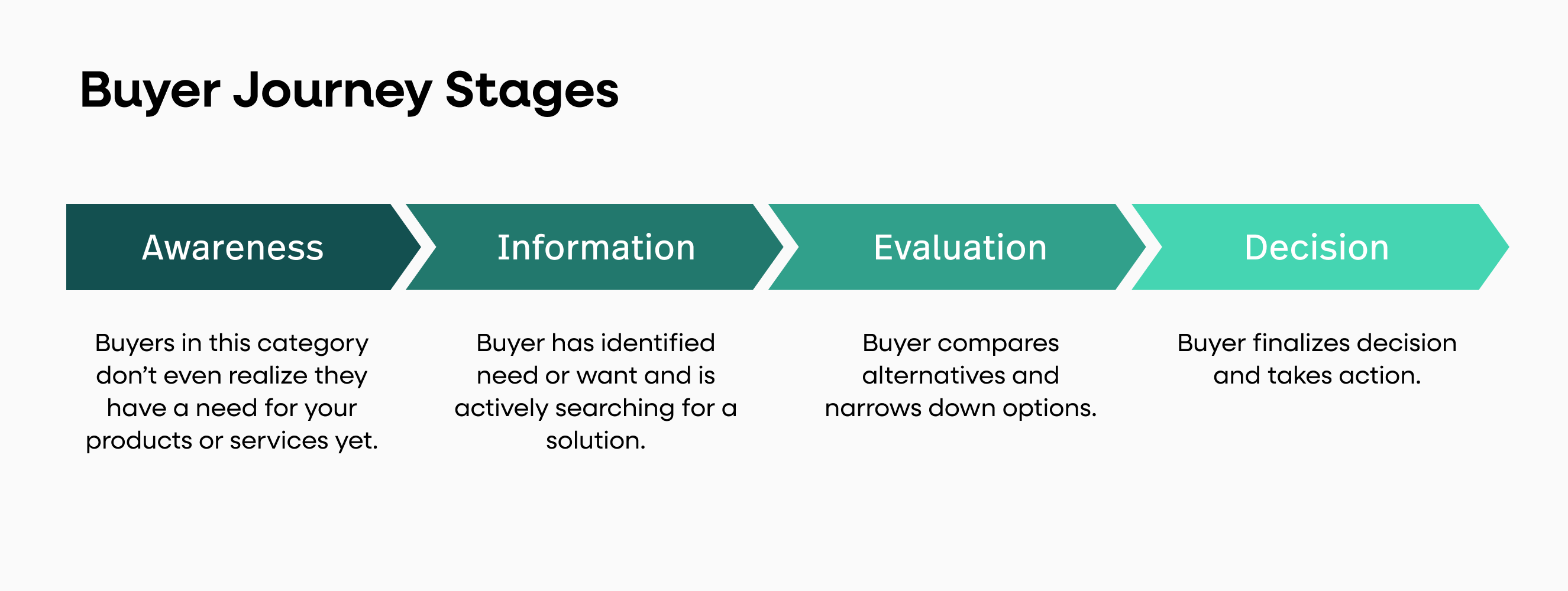
A buyer persona is your ideal customer—they’re in research mode. You can have more than one buyer persona for your company, and understanding this buyer is the key to creating a successful customer experience. This buyer will turn into your customer.
Here’s what makes up your buyer persona:
Demographics —including personal, professional, and specific (age, gender, location, education, income, marital status, skills, routines, etc.)
Goals —including personal and professional, priorities, and challenges
Values —including personal and professional, and what they find to be important in products and companies
Preferences —including the content they consume, their communication choices, communities, groups, or associations, and how they spend their day, on and offline
All of these characteristics make up customer journey maps on the buying path.
Customer journey stages
Journey phases are the different high-level stages in the customer roadmap. They provide organization for the rest of the information in the journey map (actions, thoughts, and emotions).
The stages will vary from scenario to scenario, and each organization will usually have data to help it determine what these phases are for a given scenario. Often you will see awareness, research, evaluation, and decision making in the customer phases.
Customer expectations
Journey maps are best for scenarios that involve a sequence of events, describe a process, or might involve multiple channels.
Pain points are a specific problem that customers or prospective customers of your business are experiencing in the industry.
Scenarios can be real (for existing products and services) or anticipated—for products that are yet in the design stage.
Actions, mindset, and sentiment
Every customer has a particular action that they take, because of a mindset that they have and will express it in their own sentiment.
Actions: When a customer engages with your brand with a purpose.
Mindset : Correspond to users' thoughts, questions, motivations, and information needs at different stages in the journey.
Emotions : How customers feel about your brand, whether positive, negative, or neutral. Plot these emotions in a single line across the journey phases, signaling the emotional highs and lows of the experience.
Opportunities
Opportunities of a customer journey map are desired outcomes. Maps should include key components, which can depend on the goal of the user journey mapping initiative.
Opportunities are also insights gained from mapping—they speak to how the user experience can be optimized.
To create a customer journey map, identify the personas, map the triggers that lead to desired outcomes, and discuss opportunities.
What are customer journey touchpoints?
Customer journey touchpoints are individual transactions through which the customer interacts with a business.
There are about 5–7 minimum touchpoints along a customer journey. Customer journey touchpoints for omnichannel brands are everywhere:
social media posts
product demos
advertisements
brick and mortar visits
website(s) clicks
You’ll also have the added returning customer touchpoints to consider—like how engaged they are with your product, if they are returning to your website or if they are attending your events for the second or third time.
Examples of customer touchpoints
Identifying each touchpoint is crucial for creating a customer journey map that will drive a better customer experience. Once you’ve identified the touchpoints, list out possible customer actions for each.
Some actions that derive from customer touchpoints might be:
Downloading an eBook
Clicking on your FAQ
Requesting a demo or call
Subscribing to your blog
Clicking a paid ad
It’s important to know which touchpoints to invest time and resources into. Your map maps out the areas you can improve, retain and scale.
Types of customer journey maps
Each customer journey map has a different objective and business focus. There are six types to familiarize yourself with:
Current state —These illustrate what customers do , think, and feel as they interact with your business currently.
Future state —These illustrate what customers will do, think, and feel as they interact with your business in the future.
Day in the life —These examine everything that customers or prospects do, think, and feel (within a specific area), whether that involves your product or not.
Service blueprint —This is a diagram that usually starts with a basic version of an existing or future state journey map.
Circular —These are used for subscription-based models to visualize the customer journey as a circle or loop. This helps reinforce the importance of customer retention and lifetime value.
Empathy —These are used to create a shared understanding around the wants, needs, thoughts, and actions of a customer.
Journey maps are meant to be used as a strategic planning tool. Use these definitions to guide you towards aspects of other methods that your team has not previously considered.
Journey map vs. experience map
A journey map is specific to a product or service, while an experience map is more general and can be used outside of a business's scope.
Since experience maps are more generic in nature, they can also be used to find pain points in a product or service for a future journey map.
Journey map vs. service blueprint
If journey maps are a product of experience maps, they will need a blueprint to direct them there.
Service blueprints are a continuation of journey maps in the service industry. They lead the roadmap for service-based customer journeys.
Journey map vs. user story map
User stories are used in Agile to plan features or functionalities, much like a future customer journey map.
In the user story map case, each feature is condensed down to a deliberately brief description from a user’s point of view. The typical format of a user story is a single sentence:
“As a [type of user], I want to [goal], so that [benefit].”
How to create a customer journey map
When you set out to create your own journey map, try drawing everything out on a whiteboard or digitizing it on a spreadsheet to get the big picture. The goal is to find and resolve any customer pain points. Here are eight steps to creating your own customer journey map.
Step 1: Set your objectives for the map
Before the whiteboard comes out, it’s important to set up clear objectives for the map. How do you do this?
Collect customer feedback from all company stakeholders, your team, and your customers. You can do this by forms, surveys, interviews, spotlights, or good old-fashioned conversation.
Ask questions like:
How do you feel about this feature?
How easy was it to find us?
Were there any points of frustration during your interaction with us?
Set goals within the customer journey map like seeing your product through your customer’s eyes, ways to improve your product or service, and how it all impacts your future.
Step 2. Define your customer persona
Your customer is the core of your journey map, so the first step is defining your target customer persona.
A customer or buyer persona is an in-depth understanding of who your customer really is, what they are trying to solve, and how they interact with your business.
The first thing you need to decide is which type of journey you’re going to map:
Persona —a profile of a specific customer type
Target —a profile of a potential customer
Market —a segment of customers
If you're creating your first map, it's best to pick your most common customer persona and consider the route they would typically take when engaging with your business for the first time.
From the point of interest to the product lifeline, track each step along the way to get a true sense of your target persona.
Once you've created distinct personas, you can use them to dictate customer journey maps that describe each persona's experience at various points during their lifecycle with your company.
Step 3: Highlight your target customer personas
Take your journey map persona list and pinpoint your target customer. To do this, dig deep and understand what each customer wants to achieve as they go through the customer journey.
A great way to go about doing this is to first identify the paths that your customer may take on your site.
For instance, if your customer is a member, the first thing that they might do is to log in. These instances will help you determine engagement for each customer.
Here are some different ways to obtain and understand customers' goals:
Survey or interview different customer groups
Conduct user testing feedback
Study customer support correspondence
With this insight, you can then determine where your customer will go along their journey.
Step 4. Determine customer journey stages
Journey maps are organized by customer stages (sometimes referred to as phases ).
Each stage represents a goal your customer is trying to achieve in their journey. You should build a customer journey map with stages that represent your customer's goal-oriented journey, not your internal process steps.
Based on the persona, define the stages that your customer experiences with you over time. To figure out your stages, answer this question:
What does it take for a customer to start from awareness to decision throughout the buying process?
The typical customer journey stages are:
Awareness —how customers found out about you
Research —how you can solve their problem
Evaluation —how you compare against others
Decision —how they chose you
The goal : to determine how, when, and where they discover you, choose you over competitors, purchase from you, and maintain a relationship with you.
Step 5. Identify customer touchpoints
Your buyer journey map will be built off of customer touchpoints. Customer touchpoints are your brand's points of customer contact, from start to finish.

For example, here are a few ways customers may find you:
Search inquiry
Customer review
Social media post
These are just a few touchpoints; there are many more. Identifying these customer touchpoints is an important step towards creating a journey map and ensuring your customers are satisfied every step of the way. It’s also a pivotal part of how you will define your map.
Step 6. Map the current state
It’s time to conduct customer research for your map. This will include information about your customer’s intentions, motivations, digital footprint, and interpretation of your brand.
Most customers are happy to help if they believe you are genuinely interested in their experience and will use your feedback to improve things for others.
For each stage of the journey, try to identify:
What are my customer’s goals?
What type of experience do they want?
What steps are needed to complete that process?
How do they feel during each touchpoint?
What other thoughts, feelings or frustrations do they have during certain stages?
Beyond this information, be sure to look at patterns of how they conduct themselves online, where they frequent, and what they share.
Step 7. Understand motivations, frustrations, and resources
This step involves looking at the totality of the customer experience (CX) with your company.
Every business will look through the lens of its customer personas uniquely. Walking through each journey map stage with your team will help you identify any friction points within the customer experience.
You know your customers best. Here are a few example questions to get you started:
Where could friction appear in this particular touchpoint?
Are people abandoning purchases because of this?
Are customers unaware of this solution that you've provided? If so, why not?
These questions can be answered with customer behavior data, using a behavioral data platform like Fullstory , which delivers a complete, retroactive view of how people interact with your site or app. By finding out how visitors engage with your product and service, you can understand what resources you will need for growth.
Examine customer emotions and motivations.
Every action your customer takes is motivated by emotion. The emotional driver of each of your customer's actions is usually caused by a pain point or a problem.
So, get to know what roadblocks are stopping customers from making desired actions (again with digital intelligence) and get in front of motivation.
Overcome obstacles like cost, product friction , and onboarding frustration with customer experience intelligence.
Take the customer journey yourself.
Follow the customer journey yourself. Analyze the results to show where customer needs aren’t being met by seeing it through your customer’s point of view.
Pro tip: Document the customer journey for each of your personas and make note of the differences. It will help for future user journey maps.
Determine the resources you have and the ones you'll need.
It's important to take inventory of the resources you have and the ones you'll need to improve the customer's journey.
Using your map, you can advise leadership to invest in the right tools that will help your team manage customer demand. Do you have what it takes to solve the customer’s problem?
Step 8: Evaluate, adjust and scale
As with any process, you’ll need to test it over time. Data analysis is used to identify customers’ behavior and pain points that need changing along the way.
Use digital experience and customer intelligence to keep you informed on the user journey. This means relying on a solution to let your customers show you what’s actually happening. With features like session replay , you can understand exactly what they are going through and proactively fix it.
Always include your team and keep stakeholders involved to keep the roadmap clear.
Your customer journey map checklist
This guide on creating a customer journey map should help you truly understand the impact of your product or service. By stepping into your customer’s shoes, you will gain the insight needed to improve the entire experience.
Now, you’re ready to create your map. Here are the questions you will ask yourself while creating a customer journey map:
☑ Set clear objectives for your map ☑ Define your customer persona ☑ Highlight your target personas ☑ Determine customer stages ☑ Identify customer touchpoints ☑ Map the current state ☑ Understand motivations, frustrations, and what tools you’ll need ☑ Evaluate, adjust, and get ready to grow
Use the data and let your customers do the rest.
6 customer journey map templates
Having a template is a great way to get started. There are a few different templates to choose from:
Current state
The current state journey map visualizes the current experience with your product or service. It involves defining the scope of the customer experience with customer touchpoints.
This type of customer journey map is designed with the considerations, thoughts, feelings, and actions of your customers in mind. Current state mapping is a practical approach to identify existing pain points and create a shared awareness of the end-to-end customer experience.
Day-in-the-life
A day-in-the-life journey map is another simple grid map based on time, created especially for the daily grind of the customer. Instead of different journey stages, it represents times in the day related to actions based on decisions in the path of purchasing.
This template helps you visualize your customer’s daily routine even if these actions are outside your company. It typically is organized chronologically to systematically show the course of the habits of the day.
Day-in-the-life's are great for giving you insights into all the thoughts, needs, and pain points users experiences throughout their day. You can use this type of map to evaluate when your product or service will be most valuable in your customer’s day.
Future-state
With a future-state journey map template, your goal is to learn how your customers feel about a new product launch or about how they will require your service in the future.
Future-state journey mapping is a useful approach to explore possible customer expectations and to create new experiences. Mapping out a future customer journey helps to align your team around a common goal—the betterment of the customer experience.
Service blueprint
A service blueprint helps you design a roadmap of your service process—much like building a house. The goal is to be able to make projected changes to the service where needed and to be able to visualize each step in the eyes of the customer.
Service blueprint maps reflect the perspective of the organization and its employees and visualize the things that need to happen behind the scenes in order for the customer journey to take place.
Service blueprints are created when making procedural changes, or when trying to pinpoint solutions to roadblocks in the customer journey on a website.
A circular customer journey map is just that—circular instead of linear or graph-like to showcase a different type of business model. For instance, a SaaS company may find it more useful to visualize the customer journey as a loop or wheel.
This subscription-based journey map does a nice job of portraying both the customer interactions and sentiments, as well as their journey from awareness to purchase.
The empathy journey map is a bit different because it aligns with the customer's feelings and emotions. Empathy is a big factor in the customer journey and this template is designed to help teams align their customer journey mapping exercise with these types of needs.
With empathy, you can get into your customer’s shoes and truly feel what they feel as it pertains to your product or service.
As with anything, you’ll need customer journey mapping tools to help you . The key is to find the right tool that works with your team and workflow.
Here are a few tools to consider:
PowerPoint or Google Slides
With the right map and the right tools, you can overcome roadblocks and open a path to scalability and success.
Enhance your journey mapping process with customer intelligence. Look at behavioral data points like heatmaps , scroll maps , and other insights you can glean from session replay . Combining these quantitative and qualitative insights will help you in your journey-mapping process.
Using journey maps to drive organizational change
It may not be easy to get buy-in to support the changes in strategic planning that result from customer journey mapping.
You can use what insights you’ve gleaned from the current state journey map in these beneficial ways:
Align your organization around the customer viewpoint. Engage with each department and set up a commitment to put the customer experience moments top of mind with an initiative for growth.
Enlist team members and partners to generate empathy for customers. Use your journey map to bring together relevant teams to train on customer experience best practices.
Supplement a new strategy with internal communications that encourage better customer service. As new initiatives roll out, use internal channels to communicate how you’re improving the experience of the customer, and how team members can help.
Optimize your user journeys with Fullstory
Understanding your users' digital experience and optimizing your most important touchpoints can be make-or-break.
With Fullstory Journeys, you can easily see how users explore your site or app and see step-by-step page navigations and other key interactions along the way. This lets you identify if users are using your site how you intended; what the most common navigation paths are; and how users typically arrive at your most critical pages.
It's no longer a guessing game—it's data-driven and actionable.
Fullstory's behavioral data platform combines the quantitative insights of customer journeys and product analytics with picture-perfect session replay for complete context that helps you uncover opportunities.
Sign up for a free 14-day trial to see how Fullstory can help you combine your most invaluable quantitative and qualitative insights and eliminate blind spots.
Frequently asked questions about customer journey maps
Who uses customer journey maps.
For any brand or company that wants to learn their customer, from the point of motivation to the turning point of frustration, a customer journey map is the best tactic to do so. Journey maps are best for scenarios that describe a sequence of events. You might want to map multiple scenarios for one persona, depending on your project goals.
How often should I update a customer journey map?
If business goals change, so could your customer’s goals. If you roll out a new product or service, you may want to edit or update your customer journey map. Keeping your maps updated can help you reach your goals as a team.
How many customer journey maps do I need?
The number of different customer journey maps needed all depends on your target audience. If you have multiple customer personas, it would be best to create different journey maps to suit each one.
At the very least, be sure to create a customer journey map for the current and future state so you can aid in predicting future trends of the customer journey in alignment with your product and service.
Who should be involved in the mapping process?
Anyone that is involved in making your product or service successful should have a hand in the mapping process. Sales, marketing, customer success, and product teams all should be involved in customer journey mapping. Every team member will benefit from truly understanding their customers to make for a better customer experience.
What is a user journey map in design thinking?
User journey maps for design thinking is an iterative process of studying the user so that they can engage with a system with more agility. It redefines customer problems in an attempt to identify alternative solutions that might not be obvious with the initial level of understanding.
Related posts
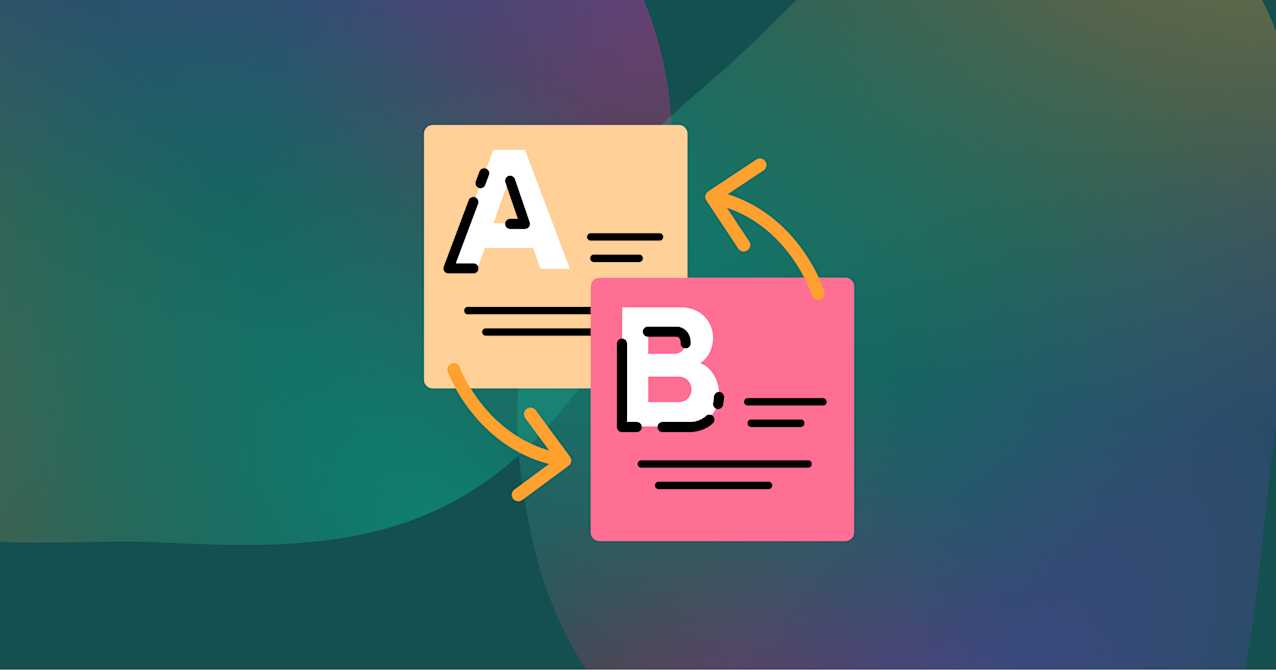
A/B testing is the process of comparing two versions of the same product to determine which is the most compelling for users.
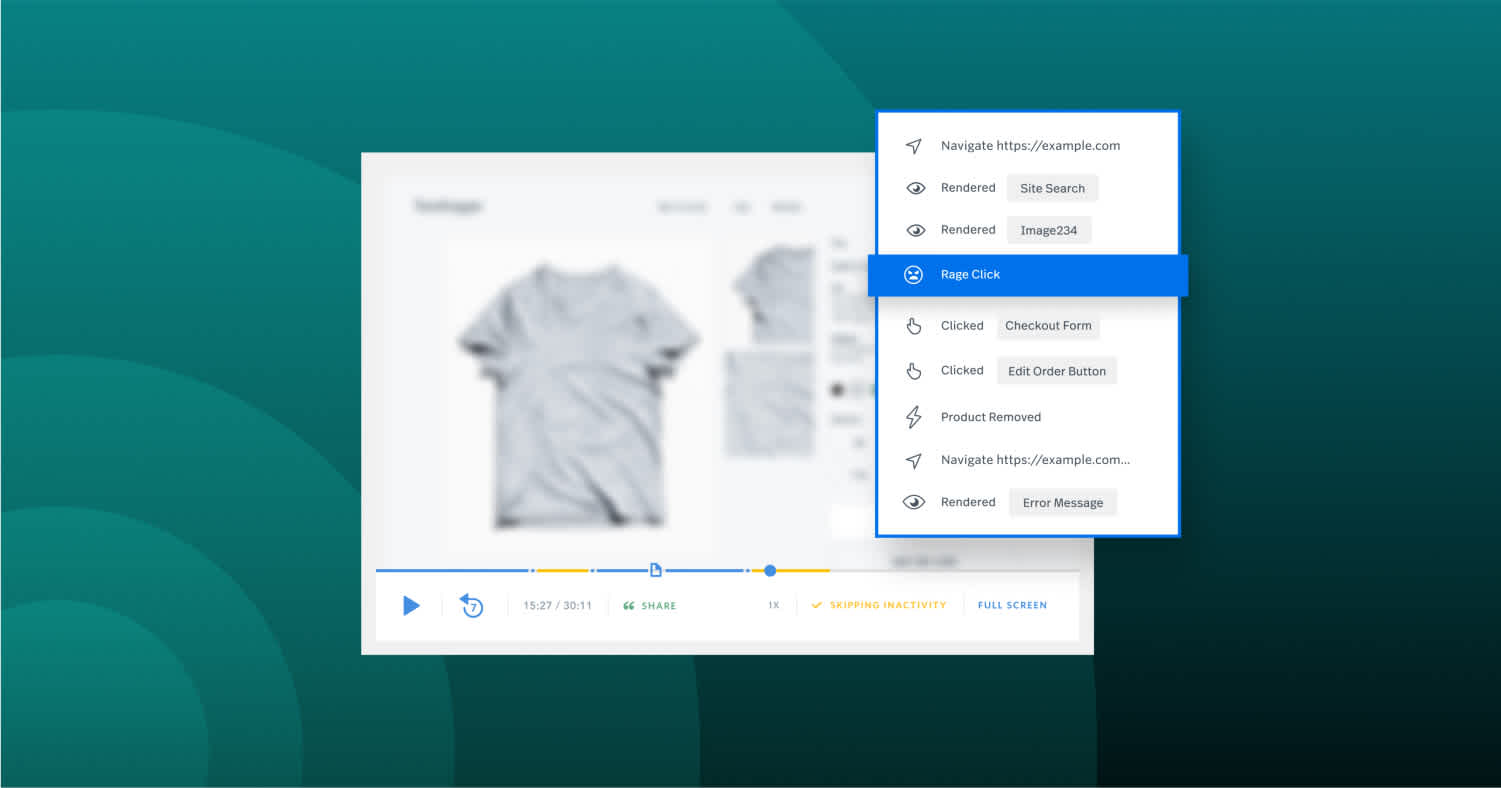
Session replay reproduces your user's online experience. But how should you use it? And how can you learn from it?
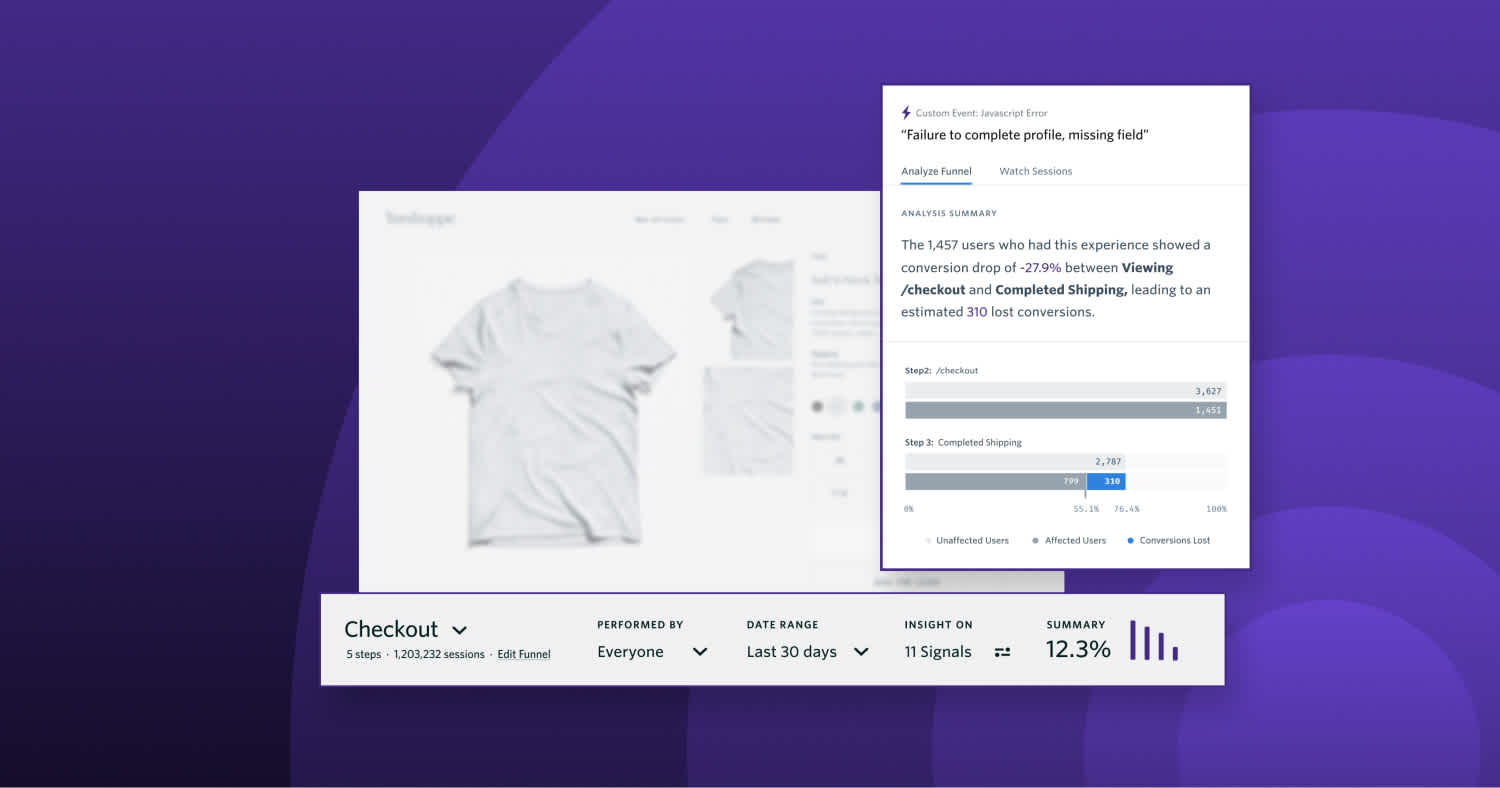
A comprehensive guide to product analysis and analytics platforms, how important they are, and why they’re a valuable asset for your bottom line.
Buyer personas: Your blueprint to market success
Creating a successful product or service requires more than just a great idea. It requires a deep understanding of your customers.
Who are they? What do they need? What motivates their purchasing decisions? This is where buyer personas come into play.
A buyer persona is a semi-fictional representation of your ideal customer. It’s built from real data and informed speculation about customer demographics, behavior patterns, motivations, and goals. The purpose of creating buyer personas is to gain valuable insights into your target market. This allows you to tailor your marketing, product development , and sales strategies to meet their specific needs.
Why buyer personas are important
Imagine trying to sell a product or service without knowing who you’re selling it to. You might have a rough idea of your target audience, but without clear buyer personas, you could send out the wrong marketing messages or focus on the wrong types of customers. The result? Your efforts could miss the mark, wasting both time and resources.
When you create buyer personas, you’re creating a map to guide your efforts. Personas help you understand your potential customers' pain points, motivations, and preferences. This knowledge allows you to create more effective marketing campaigns, streamline your sales team’s efforts , and even drive smarter product development decisions.
1. Creating buyer personas
The first step in creating a buyer persona is research—lots of it. You’ll need to conduct audience research and collect information about your existing and prospective customers. The more data you gather, the more accurate your personas will be. This isn’t a quick process, but it is crucial for long-term success.
Start by analyzing demographic information such as age, gender, location, job title, and income level. You’ll also want to look at behavioral data: What websites do they visit? What do they buy online? How do they interact with your brand on social media? What are their biggest frustrations (aka pain points)?
The goal is to use a blend of quantitative data (like analytics and sales reports) and qualitative insights (like customer feedback) to create detailed personas that represent your target audience.
2. Understanding your target market
Now that you have your buyer personas, it’s time to look at the bigger picture: your target market. Understanding your market means more than just knowing who your customers are. It involves identifying trends, assessing the competitive landscape , and understanding how your product or service fits into your potential customers' lives.
Your personas will guide you here, helping you pinpoint which market segments to focus on. For instance, if your personas reveal that your ideal customers are millennials passionate about sustainability , this will influence everything from your product development decisions to how you craft your marketing messages.
This deep understanding of your target market will allow you to make more informed decisions as you develop your business strategy. You’ll be able to see gaps in the market that your competitors aren’t addressing, and you can position your offering to fill those gaps in a way that resonates with your personas.
3. Aligning your sales team
One of the biggest challenges for any sales team is knowing how to connect with diverse customers. When you have well-defined buyer personas, this becomes a lot easier. Your salespeople can approach each lead with a better understanding of their needs and preferences, allowing them to tailor their pitch to each persona.
For example, a salesperson dealing with a persona representing a cost-conscious buyer will emphasize value and cost-saving benefits. On the other hand, when selling to a persona that prioritizes innovation and cutting-edge features, they can highlight the unique advantages of your product or service.
The key is ensuring that your sales team is fully equipped with the knowledge they need to recognize and address the different personas. This might involve specific training sessions, detailed persona briefs, and ongoing feedback loops to refine their approach.
4. Crafting targeted marketing messages
Another area where buyer personas shine is creating relevant, personalized marketing messages. Once you understand your personas and what drives their behavior, you can create content that speaks directly to them.
This goes beyond just tweaking your language—it's about creating a connection. Whether you’re crafting blog posts, email campaigns, or social media content, your personas will guide your communication's tone, style, and focus.
For example, if your personas include tech-savvy early adopters, you might focus on creating content that highlights your offering's innovative features and uses technical jargon they understand. Meanwhile, if another persona represents parents with young children, your messaging would focus more on safety, convenience, and time-saving features.
Personas also help with social media strategy. By knowing which platforms your personas spend their time on, you can ensure that the right people see your posts. You might find that one persona is more active on Instagram, while another prefers LinkedIn. This allows you to allocate your resources effectively and boost engagement.
5. Improving product development
When you truly understand your customers, you can develop better products and services that meet their needs. Buyer personas are essential in this process. Knowing what features your personas value most, you can prioritize those elements in your product development.
For example, your audience research shows that one of your personas is concerned about environmental impact. You can use this insight to guide your product development decisions, ensuring sustainability is a core focus. On the other hand, if another persona values cutting-edge technology, you can prioritize features that showcase your brand's innovation.
Having buyer personas on hand during the product development phase means you’re less likely to create something that misses the mark. You’ll also better understand how to position and market your product, making the launch smoother and more successful.
6. Mapping the customer buying journey
Every customer goes through a buying journey , from initial awareness to purchasing. By mapping this journey for each buyer's persona, you can identify key touchpoints where you can influence their decisions.
For example, one persona might spend much time researching online before deciding. You’d want to ensure your website is packed with informative content that helps them in their research. Another persona might rely heavily on peer recommendations, so you’d focus on building a strong presence on review sites and encouraging word-of-mouth marketing.
When you understand how your personas move through the buying journey, you can create strategies that guide them from awareness to purchasing more effectively. This also helps you identify any barriers preventing prospective customers from moving forward, allowing you to address those issues head-on.
7. Measuring success and refining personas
Buyer personas are not static—they evolve as your business and market change. That’s why continually revisiting and refining your personas over time is essential. Regularly conduct market research and gather customer feedback to ensure your personas are still accurate and relevant.
Additionally, measure the success of your persona-driven strategies. Look at key metrics like conversion rates, customer satisfaction, and sales performance to see if your personas are helping you achieve your goals. If something isn’t working, adjust your personas or your approach accordingly.
Case study: Increasing digital acquisition through buyer personas and behavioral economics
A fintech banking app approached Simon-Kucher to improve its pricing and marketing strategies to drive growth and increase customer lifetime value (CLTV). Despite having a tiered pricing structure, our client sought new value-creation opportunities, including exploring the feasibility of a freemium option to boost organic growth. Additionally, they wanted to redesign their digital platform and customer journey to capture and retain more consumers.
Simon-Kucher's approach began with in-depth quantitative and qualitative surveys targeting current and prospective customers. This revealed that many users were unaware of the differences between product tiers, meaning they weren't fully utilizing the features they were paying for. To address this, our team developed solutions to increase product engagement, encouraging customers to maximize usage and, in turn, grow value.
Benchmarking against other businesses showed that adding extra features to paid packages was more effective at driving acquisition than offering a freemium option. Furthermore, introducing discounted multi-member plans proved a successful strategy for increasing household utilization and overall growth.
To refine our client’s marketing strategies, we conducted primary research to gather insights on demographics, psychographics, willingness to pay, and customer behavior. This data created actionable digital buyer personas, allowing personalized marketing and a tailored digital experience. Our team also produced a transformation roadmap to drive new growth and retention.
As a result of these efforts, our client is expected to achieve a 29% revenue growth and a 15% increase in new customer acquisition by optimizing their products and targeting specific buying personas with customized strategies.
The power of buyer personas in building your business
Creating buyer personas is a powerful strategy that can transform your business from the inside out. By understanding your target audience more deeply, you can create content, develop products, and craft marketing strategies that truly resonate with the people who matter most—your customers.
From informing your sales team to driving your social media efforts, buyer personas are the foundation for success across all business areas. So, take the time to get them right.
Remember, your prospective customers are more than just numbers on a spreadsheet. They have hopes, fears, and preferences to guide their purchasing decisions. By investing in buyer personas, you’re investing in a more personalized, practical approach to reaching those customers. And in today’s crowded marketplace, that’s an investment worth making.
How we can help
At Simon-Kucher, we specialize in helping businesses unlock the full potential of buyer personas to drive growth and success. Our expert team works closely with you to create buyer personas based on in-depth market research and data-driven insights , ensuring you clearly understand your target audience and their unique pain points.
With our guidance, you can tailor your product development, marketing strategies, and sales approaches to connect meaningfully with your prospective customers. Let us help you leverage buyer personas to refine your strategy, boost engagement, and maximize revenue. Contact us .
Our experts are always happy to discuss your issue. Reach out, and we’ll connect you with a member of our team.
- Global | EN
- Global | DE
- Global | FR
- Global | CN
- Global | JA
- Customer journey maps
- AI Personas
- Impact maps
- Request a demo
- Human Resources
- Pricing plans
- Affiliate Program
- Case studies
- UXPressia Academy
- Cheat cards
- Platform overview
- All templates
- Banking, Finance & Insurance (24)
- Business (14)
- CX/Business Tools (6)
- Services (10)
- Digital (18)
- Education & Career (18)
- Government & Nonprofit (10)
- Health & Well-Being (5)
- Leisure & Entertainment (19)
- Shopping & Purchases (20)
- Real Estate (6)
- Transport (18)
- Travel & Tourism (19)
7 Ways to Analyze a Customer-Journey Map

March 22, 2020 2020-03-22
- Email article
- Share on LinkedIn
- Share on Twitter
A customer-journey map is an infographic visualization of the process that a persona segment goes through in order to accomplish a goal. Journey maps are useful in communicating the general narratives and themes uncovered by longitudinal research done to understand how a customer works toward a goal over time.
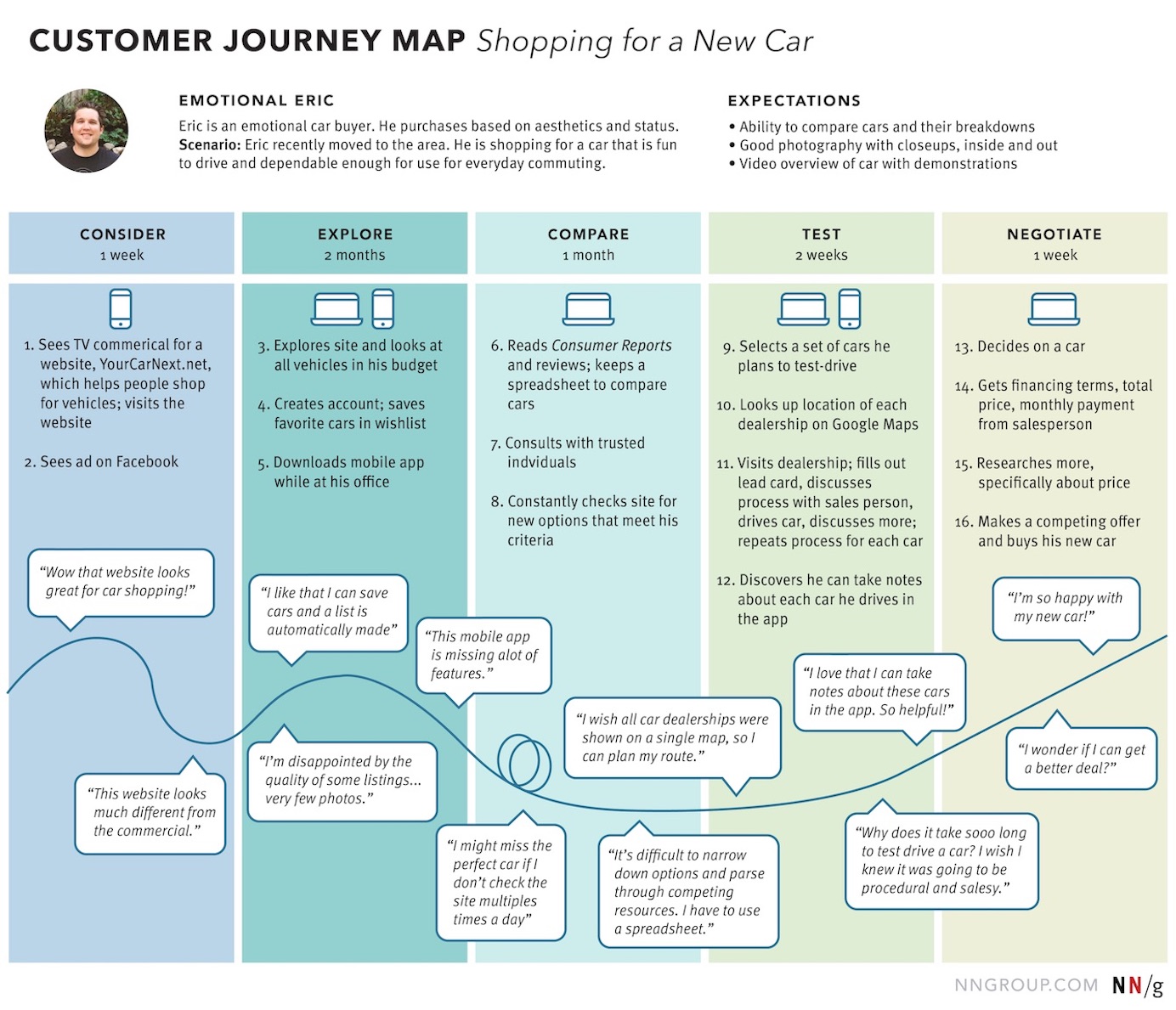
This journey map includes all the information necessary for understanding and analyzing the user experience of shopping for a new car. In this illustration, we have intentionally left out one key piece of the map — the insights and opportunities gleaned from the map. This section is often found at the bottom of a customer-journey map and highlights how the organization can optimize and improve the customer journey.
In this article we will demonstrate how to analyze a journey map and, thus, how to identify the insights and opportunities for improvement.
In This Article:
Analyzing the journey map.
Longitudinal research and analysis is necessary to create a map like this.
Every journey map will look different because the research insights and the resulting visual depend entirely on the context of the journey, its underlying activities, and the persona completing it. That said, there are 7 common elements you can and should look for when analyzing a customer journey.
1. Look for points in the journey where expectations are not met.
Users go into an interaction with an organization with certain expectations. When the interaction does not meet their expectations, you see pain points in a customer journey. To identify these instances, first reflect on who the persona is. Ask yourself; what is important to this persona, where did she come from before this journey, what has she seen and what does she know already? Putting yourself in the user’s mind space will allow you to understand which interactions conflict with user’s prior ideas and expectations.
Of course, you should look for places where users verbalized their concerns, but also use your logic to assess interactions with no explicit complaints or negative comments.
Sometimes people bring their expectations into the journey from other experiences. For example, users expect that when they pull up to a hotel, the bellman will open the door, because that’s what always happens when you pull up to a hotel with a bellman — it’s the mental model that they have formed for that situation. Some organizations set inaccurate expectations early in the customer journey. Others don’t set expectations at all, forcing users to make assumptions and possibly be disappointed if those assumptions prove wrong.
Find the trouble spot and work backward to identify the triggering factor and how the expectations were (or were not) set. Work to resolve the conflict between expectations and reality.
In the car-buying journey map, there were two clear points where Eric’s expectations weren’t met. These instances are annotated using red numbered circles.

2. Identify any unnecessary touchpoints or interactions.
Are there any steps in the customer journey that could be eliminated in order to streamline the total experience? Look for logical ways to optimize the process to reduce total interaction cost . That may mean removing an existing step that is no longer needed or adding something to the experience that bring efficiency to the overall journey.

3. Identify the low points or points of friction.
When you step back and look at the whole journey, you should be able to see where the user experiences the most pain or friction. These points are usually represented visually as dips in the journey diagram. See where the journey reaches its lowest point and compare it to other low points in the journey. These should be on your shortlist of optimizations. That said, not all fixes are created equal: there can be dependencies and constraints involved. Work with your team to decide which low points should be addressed first and which can come later. (Because of the peak-end rule , the lowest point in a journey will have a particularly ruinous impact on the branding effect of the user experience.)

4. Pinpoint high-friction channel transitions.
Many journeys take place across devices or channels . A lot of times the journey breaks down and friction appears when users change channels. For example, a user receives a newsletter about a specific offering from a company. She’s interested in the offering and clicks the call to action in the newsletter. However, instead of being taken to a landing page detailing that particular offer, the user lands on the company’s homepage. At this point, she has to put in effort to find the offer. Or, another user may begin filling out a form on the mobile phone, but wants to complete it on the laptop when it becomes too laborious. Doing so means losing work and starting over. These channel-transition pain points should be identified and streamlined. Think outside of the box: rather than forcing users to work hard, build a bridge for them to get to the other side easily.

5. Evaluate time spent. In your journey map, provide time durations for the major stages of the journey.
This information gives you another lens for analyzing the experience. Assess how long it takes users to achieve the underlying substeps. Are these times appropriate? Time spent often correlates to the amount of user effort. Call out areas of the journey where time and effort are problematic.

6. Look for moments of truth.
Some points in the journey are so important that the rest of the experience might hinge on them. Think about the personas’ attitudes, needs, and priorities. Is there a make–or–break moment in the journey for that persona? This moment may be where your research shows a lot of emotion or where you see a strong divergence between the paths different users take. If this moment goes well, it can save the experience. For example, think of the first time a car-insurance customer files a claim. She’s been paying her policy responsibly, and now she needs her insurance to come through seamlessly for her. The first interaction in the claim experience might be a moment of truth for this persona. If it goes wrong, the user may move to a competitor. Be sure to look for moments of truth and to call attention to them when you find them.

7. Identify high points or points where expectations are met or exceeded.
Good UX practitioners should always balance their analysis by pointing out things that are working well in any experience. Look at the high points in the journey — the interactions that users are happy with. Where do they express positive thoughts and emotions? These insights are also valuable. You may be able to amplify them or recreate similar experiences elsewhere in the journey.

Whether you’re evaluating journey research for the creation of a map or digesting a map created by another party, it’s important to know what to look for. As the creator of the map, you’ll want to identify and call attention to these important elements through visual emphasis and storytelling. As a consumer of the visualization, apply this checklist like lenses through which to view the map in order to find the most actionable insights.
Related Courses
Journey mapping to understand customer needs.
Capture and communicate UX insights across complex interactions
Omnichannel Journeys and Customer Experience
Create a seamless, cohesive cross-channel experience
Interaction
Customer-Journey Management
Build a crossfunctional journey-centric design approach that scales
Related Topics
- Customer Journeys Customer Journeys
Learn More:

The 3 Competencies of Journey Management
Kim Flaherty · 5 min

Journey Management vs. Service Design
Kim Flaherty · 4 min

Types of User Pain Points
Sarah Gibbons · 4 min
Related Articles:
How to Conduct Research for Customer Journey-Mapping
Kate Kaplan · 7 min
Good Customer Experience Demands Organizational Fluidity
Kim Flaherty · 7 min
Journey Mapping: 9 Frequently Asked Questions
Alita Joyce and Kate Kaplan · 7 min
Remote Customer Journey Mapping
Kate Kaplan · 5 min
Journey Mapping in Real Life: A Survey of UX Practitioners
Customer Journeys and Omnichannel User Experience
Kim Flaherty · 6 min

IMAGES
VIDEO
COMMENTS
A CJM depicting entire journey of a persona called Eric when shopping for a new car (Source: Nielsen Norman) Using Personas in making a customer journey map. While there are several steps involved in making a CJM, the most important step is making a user persona. A user persona forms the backbone on the basis of which a good CJM is made.
Group overarching themes into buyer personas and create a customer journey map for each. 5. Review and update each journey map after every major product release. The customer's buying process changes every time your product or service changes. Even slight tweaks, like adding an extra field to a form, can become a significant roadblock. ...
A user persona is beneficial for customer journey mapping as it helps product marketing teams understand who they're selling to and the types of long-term users that benefit from their products. Persona mapping helps flip traditional AARRR pirate metrics to RARRA growth models, prioritizing retention over acquisition.
The first step in a customer journey map is the core demographics, such as: You'll likely find most of this data in your CRM. If not, a survey can give you a clear picture of who your audience is and what they do. I recommend "humanizing" the persona by giving them a name and image.
Step 1 - Create a customer persona to test. In order to effectively understand the customer journey, you need to understand the customer - and this is where creating a persona really helps. You may base this around the most common or regular customers, big spend, or new customers you haven't worked with before.
Example 2: a client journey map for a corporate bank. This free template is an example of a multi-persona, B2B customer journey. The key persona is a newly opened company looking for a bank to run their business. The map also visualizes interactions between the personas involved. Open a full-size image in a new tab.
How to create a customer journey map (step-by-step) Here's how to create a user journey map in 6 steps: Choose a user journey map template (or create your own) Define your persona and scenario. Outline key stages, touchpoints, and actions. Fill in the user's thoughts, emotions, and pain-points. Identify opportunities.
Define the map's scope (15 min) Ideally, customer journey mapping focuses on the experience of a single persona in a single scenario with a single goal. Else, the journey map will be too generic, and you'll miss out on opportunities for new insights and questions. You may need to pause creating a customer journey map until you have defined your ...
Persona-Based (or Persona-Led) Customer Journey Map is a variation on the Customer Journey Map putting the Persona, their background, and unique experience in the center. It's simply a different way of laying out a Customer Journey Map. Instead of following a timescale, this one showcases a digest of touchpoints, actions, emotions, and takeaways.
The wins from using personas and customer journey maps. Companies can use personas and journey maps to rally employees behind the common goal of improving and optimizing the customer experience. That shared commitment is key to building a customer-centric culture. From there, your organization has the best chance to deliver what your customers ...
Developing CX Personas: The Step Before Journey Mapping. In my work consulting, training, and running workshops , one consistent theme I find is teams are super eager to begin the Customer Journey Mapping process. I get it. Customer Journey Mapping can reveal — and help solve — a lot of problems in the customer journey.
Simply choose the touchpoints which accurately reflect a customer's journey with your brand. After you define your touchpoints, you can then start arranging them on your customer journey map. 4. Map the current state. Create what you believe is your as-is state of the customer journey, the current customer experience.
10 top customer experience certification programs. Explore five important tips for how organizations can use buyer personas to create effective customer journey maps. 1. Tie personas to data. Sales and marketing professionals often have a strong sense of buyer persona ingredients, but anecdotal representations are too subjective and incomplete ...
1. Define your purpose. The first step to creating a successful customer journey map is to define your product's vision or purpose. Without a clear purpose, your actions will be misguided and you won't know what you want users to achieve during their journey on your website, product page, or web app.
Use the steps below to build a customer journey map. Consider the different stages of the user experience, from their first interaction with your company to their last. 1. Set your map objectives. Any time you begin a new project or build a new tool, you'll need to set objectives.
A customer journey map generally includes a summary of your customer persona, purchase phases, touchpoints with your company, customer thoughts/actions/emotions and opportunities to improve the ...
Using data gathered from feedback surveys, online reviews, and other customer satisfaction metrics, a customer journey map is used to tell the story of a customer's lifetime relationship with a company.Depending on the customer persona, this relationship can be as short as a few minutes or as long as many years. Customer journey maps are useful tools for visualizing the quality of each ...
Set goals within the customer journey map like seeing your product through your customer's eyes, ways to improve your product or service, and how it all impacts your future. Step 2. Define your customer persona. Your customer is the core of your journey map, so the first step is defining your target customer persona.
In this video, our Customer Success Agent Julia explains why building a multi-persona journey map is helpful to truly understanding your customers and delivering personalized experiences. Learn from two examples of how to use multiple personas on a single map and apply what you've learned to your own maps. Why Build Multi-Persona Journey Map vs ...
6. Mapping the customer buying journey. Every customer goes through a buying journey, from initial awareness to purchasing. By mapping this journey for each buyer's persona, you can identify key touchpoints where you can influence their decisions. For example, one persona might spend much time researching online before deciding.
Here, you'll discover a plethora of templates spanning various domains, from services to CX and business tools, all aimed at enhancing the user experience. These customer journey map, user journey map, persona profile, and impact map templates cater to a broad audience, offering diverse map and persona examples for those in marketing and beyond.
A customer-journey map is an infographic visualization of the process that a persona segment goes through in order to accomplish a goal. Journey maps are useful in communicating the general narratives and themes uncovered by longitudinal research done to understand how a customer works toward a goal over time.. This journey map communicates the various steps in the process of researching ...
3. Decide the levels of details in your journey map. When journey mapping, you want to make sure to create a map that can handle both the overview perspective as well as the important details that might be of value for your customer centric improvements. You don't need to dig deep into areas that work fine today.